The legendary Japanese fighter
Just named colloquially “zero” and still popularly known as such today, the A6M, or “Mitsubishi Navy Type 0 carrier fighter” (零式艦上戦闘機) hence the number used as nickname, was the brainchild of superstar aviation designer Jiro Horikoshi. A superb dogfighter, combined with perhaps the best trained naval fighter pilots of the world’s at the time, achieved total air dominance in the Pacific until 1943.
With 10,939 delivered by Mitsubishi, Nakajima and other plants, it was also the most ubiquitous of all WW2 Japanese models, soldiering over a very large area, between aircraft carriers and land bases, from Mandchuria to New Guinea, Malaysia to the Aleutians. The A6M gained an aura of invincibility in the first year of the war, brushing aside all opposition. This was the result of a number of factors, but its advantages became problems when the allies started to field better planes in 1944-45. It’s designated successor, the A7M Reppū never had the time to replaced it, but the A6M went through several iterations and variants to correct its known issues.
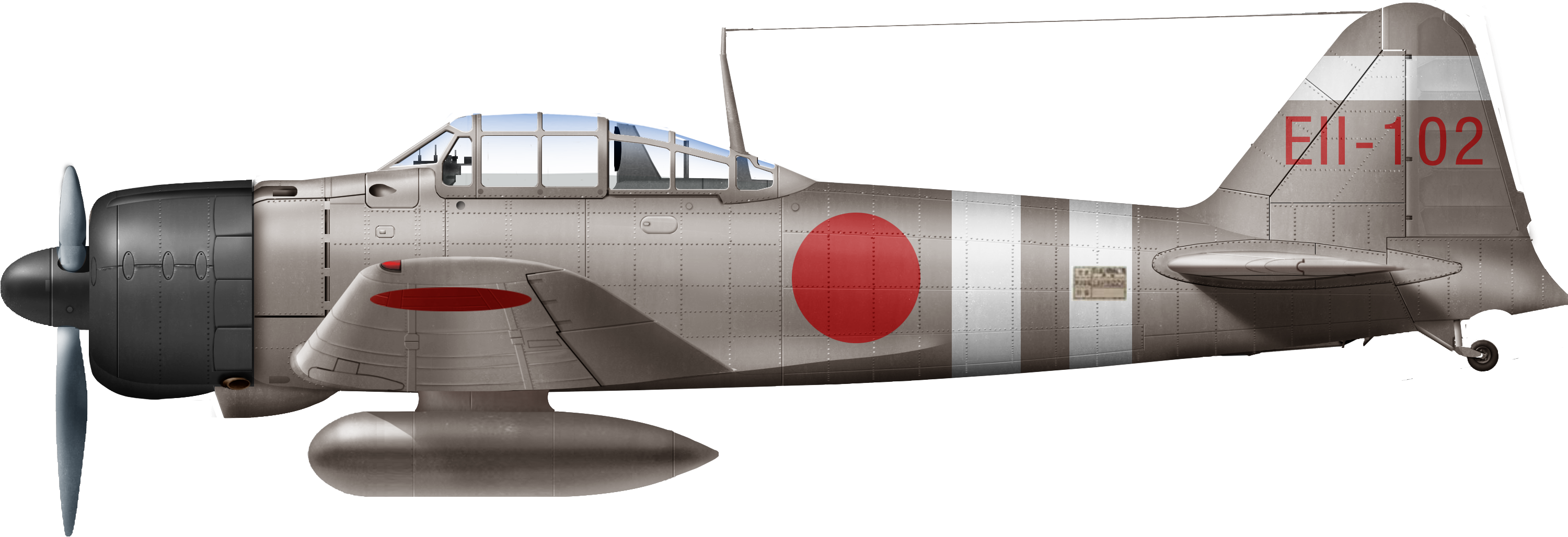
A6M2 in 1940
Design development
A successor to the A5M “Claude”
The A5M “Claude” was the Imperial Japanese navy main monoplane fighter in 1939, a 1st generation model, also designed by Horikoshi with elliptic wings and modern features, all metal fuselage but still antiquated ones, like fixed undecarriage and open cockpit. It was already a superb dogfigher, putting agility over all else. But in 1939, with a more serious opposition over China, pilots started to recoignise its limitations.
This process started early on: The Mitsubishi A5M fighter was just entering service in early 1937, when its replacement was already discussed. On 5 October 1937 was signed and published “Planning Requirements for the Prototype 12-shi Carrier-based Fighter” (or simply “12-shi spec”), sent to Nakajima and Mitsubishi to submit proposals. Both firms started preliminary design work, whereas requirements were still awaited. They were stn in the following months.
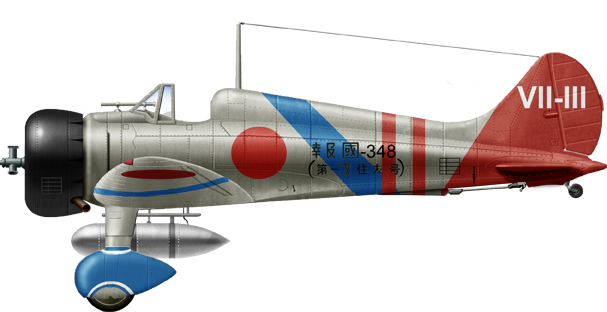
A5M4 onboard IJN Soryu in 1941
Genesis context
It happened that the the Japanese Navy was an early pioneers in carrier-borne fighter aircraft with Hosho preceding Argus by months, and fielded the Type 10 fighter, world’s first designed fighter for carrier operation while others were still adapted land-based models. The Type 3 fighter or A1N1 (a Nakajima copy of the Gloster Gambet) while in service, was followed by the 1931 Nakajima Type 90 (A2N) and 1935 Type 95 (A4N), faster but less agile.
So Mitsubishi was left out of the loop for about ten years before going back for the Type 96 A5N(A5N), first all-metal monoplane fighter, while Nakajima, which competed for the same, basically created a copy for the army, the Ki-27. Soon despite initial reserve, pilots found the apparent superiorority of the A5M in 1937 over all opposition. This new model gave Japanese designers, engineers and craftsmen a valuable experience, this time more and more decoupled from Western designs, with new techniques.
Among key points were how to minimize drag and obtain flush riveting, all sorts of weight saving measures without compromising rigidity, plus the ideal installation of radial engines into a new, high-speed, stressed skin all-metal airframe undergoing no short amount of streamlining at any level. The Type 96 (A5M) entered serviced just as a war in China broke and the Navy soon realized its limited range,n which became the main focus for the next replacement. The idea was to lead deeper penetrations for longer and more efficient escort missions into China as the war progressed. It was also realized that the Type 96 would soon be obsolete compared to upcoming Western Models; After all, both the spitfire and Me-109 emerged in 1935 already.
Other key points were the need for a retractable landing gear and heavier firepower, as the A5M two light machine guns were WW1 standard, rather puny compared to the opposition. Pilots complained about the time they needed to best their opponents in a dogfight. Examination of carrier versus land performance for a dedicated model also brought concerns in the Japanese Naval Command about theory and practice in their new and young tool, naval aviation.
To the traditional roles, reconnaissance, defence, spotting and harrassing until the big-guns battleships arrive to finish the job, was a position already dubious at the end of WWI World War 1 but still prevalent among Naval powers. So based on multiple naval games held by the academy and officers, the IJN soon realized that by having a fully independent arm from the army air force would help them reaching their goals more heavily. Without some legal cluttering or hampering capabilities and types, securing air superiority well beyond the reach of naval artillery thanks to a long range, became a main priority, not only for the attack aicraft of the nex generation, the B5N/D3A, but it’s escort, even reinforcing the idea of longer range could be useful for a fighter in open seas. Overall in 1937-38 these new doctrines, further pushed forward by Yamamoto and other promoters in the Navy versus traditionalists, made the Japanese Fleet Air Arm arguably the world’s best, years ahead of other nations. They clearly demonstrated this superiority in all engagements until 1943. Based on these experiences and discussions came the 1937 specifications 12-Shi:
Specification 12-shi (October 1937)
The design staff started with early combat reports of the A5M in China. From there, the IJN specified updated requirements, in October 1937. These were calling for:
- A speed of 270 kn (310 mph; 500 km/h) at 4,000 m (13,000 ft)
- A climb to 3,000 m (9,800 ft) in 9.5 minutes.
- An endurance (With drop tanks) of two hours in normal regime
- 6-8 hours at economical cruising speed.
- A better armament with two 20 mm cannons and two 7.7 mm (.303 in) MG plus two 60 kg (130 lb) bombs.
- A complete, modern radio set
- A Radio direction finder for long-range navigation.
- Maneuverability at least equal to the A5M
- A wingspan below 12 m (39 ft) to fit in aircraft carriers hangars.
What’s amazing beyond the numbers, is that these figures were not only unheard carrier-borne fighter, demanding speed, rate of climb and armament, they were equal or superior to any land-based fighters, and cherry on the cake, were coupled with the world’s best range, several fold above all competition and usually proper to bomber, mixed with (which was contradictory) with exceptional agilty (how to reconcile the weight of extra avgas and lightness ?). Mitsubishi was apparently not afraid of the task, and entristed again Jiro Horikoshi to form a dream team of engineers, to study this seemingly impossible proposal. Nakajima which was the natural contender was quick in its reaction after reading these and said the Navy’s demands were impossible, pulling out of the competition right away.
Nakajima’s out, Mitsubishi takes up the gauntlet (April 1938)
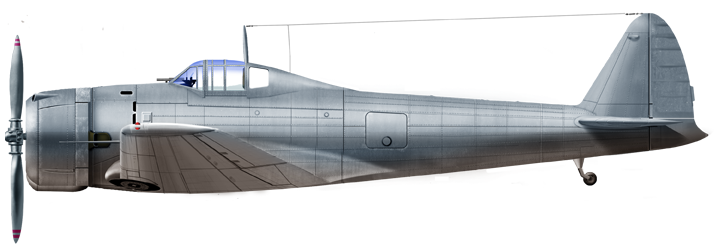
Ki-43 first prototype. It would fly first on January 1939. Note, i can’t find any photo for markings;
Nakajima’s team considered these new requirements impossible and pulled out outright in January 1938. However this must not fool us into thinking this was the official reason. Instead at the time, they looked towards a larger and more lucrative army contract, notably the awaited successor of the Ki-27 “Nate”, which would evolved into, here again, a model relatively similar to the “Zero”, the equally legendary Ki-43 Hayabusa (“Oscar”) (see later). And the agility of the latter even surpassed the A6M, but true, with a far lesser range and not the constraints of a carrier-based model. Both branches would have their respective champion.
Meanwhile, Mitsubishi’s chief designer Jiro Horikoshi, believed the requirements could be met. His take on the matter as that weight saving was to be the ultimate objective of the design. His team basically sat day and night, trying to eliminate every possible elements, replacing it by a lighter solution. Every weight-saving measure was incorporated into the design, requiring also a lot of “out-of-the box” thinking, notably by simplifying parts. Therefore, it at first the team (before having the complete specs) worked on a retractable undercarriage, enclosed cockpit version of the A5M with the latest engine, it was soon clear that very little of the former model could be reused, if at all.
Horikoshi at first simply retained and strengthened his former Type 96 design team with Yoshitoshi Sone and Teruo Tojo for the calculations, Brothers Sone and Yoshio Yoshikawa the structural work, Denichiro Inoue and Shotaro Tanaka the powerplant installation, Yoshimi Hatakenaka the armament plus equipment, Sadahiko Kato and Takeyoshi Mori the landing gear and its equipment. They selected the in-house Mitsubishi MK2 Zuisei 13, capable of delivering 875hp.
The pilot controversy (April-May 1938)

IJN Shokaku pilots in 1941
On April 10, 1938, a draft design of a new fighter sparked a lively discussion around technical decisions to made by designers, and terms of reference itself. Conservative pilots criticized the closed cockpit, arguing that it would severely restrict visibility while pilots managed to convince earlier Mitsubishi designers to also renounced it for the A5M2b modification, mostly to allow the pilots to look over the side of the cockpit forward, to find the correct glide path.
Composition of the armament and priority of flight qualities, which were maneuverability OR speed also fuelled the debate. On that matter, Lieutenant Commander (and Ace) Minoru Genda believed for a carrier-based fighter agility was key, over speed. For him, this way the fighter would be able to impose a battle on the enemy, winning a “turning contest”. He advocated achieving less power and if necessary, also heavy weaponry. Ace Lieutenant Commander Takeo Shibata led the opposing faction, stating that the A5M already demonstrated the Japanese already outperform other fighters.
Battles in China showed -and all pilots agreed on this- that the main problem, in order to engage opposition, was first to get there. Due to its short flight range, the A5M could just not escort bombers up to the objectives. So Shibata wanted both high straight speed and range to be paramount in the new design. Speed for hims was also a factor to impose its own battle tactics on slower opponents. Shibata also argued well-trained pilots with a faster aircraft would have a double edge in combat, even with marginally lower maneuverability.
This controversy between the two aces was not resolved at a meeting held on April 13, 1938. Circles close to the the Imperial Navy High Command started to voice their frustration over the pilot’s internal war and many started to advocate for a freeze of the 12-Ci program, rewrited them as well.
Jiro Horikoshi however intervened, and promised to ease all oppositions with his design. Based on early calculations, he was able to convince the Navy and the pilots alike that his new high-performance would have at the same time, the desired speed, range and maneuverability to please all pilots. Kaigun Koku Hombu (IJN aviation procurement bureau) officially approved the basic layout of the new model. But even construction of prototypes was greenlighted, Mitsubishi’s design team already had the design well refined in Oyomachi, Nagoya.
Impossible Challenges

Demands were so radical, though, it obliged to almost start from scratch. The company also took into consideration innovationd in several fields to achieve its goals, notably the use of a new top-secret aluminium alloy, developed by Sumitomo Metal Industries in 1936. This “extra super duralumin” (ESD) was indeed lighter, yet stronger, and more ductile than other alloys used at the time. The only problem -a serious one for using it at sea- was corrosive attack which made it brittle.
The problem was soon solved by consulting chemical companies and securing an equally innovative anti-corrosion coating, to be applied after fabrication. Among other measures, it was soon obvious that no armour protection was affordable given the limitations, for the pilot. Any special protection for critical points of the aircraft or the engine were ommitted as well as self-sealing fuel tanks. These measures, radical, helped reaching the specifications, but their cost was not apparent at first. It was paid dearly in 1943, five years later.
The Mitsubishi Type 0 given the year, was however lighter and more maneuverable than any fighter that came before, added to the longest range for any fighter plane (single-engine) at the time, in WW2. Tactically it was an enormous advantage for the Navy, that could escort their strike aircraft all the way to their objective, stay in defense, assist destroying opposition, and escort them back safely. No other country at the time has such fighter. The Zero was also capable of searching out possible targets hundreds of kilometres away, patrol much longer, etc. The tradeoff in weight and weak construction was known. It was discovered later it was quick to catch fire and exploding after a few rounds.
The reasoning was however, that speed and agility was the best defense. Given the cultivated aggressiveness of Japanese pilots, the new fighter was fitting them like a glove. The A6M in the end, secuced the navy as being the 2nd generation fighter it needed, by combining in addition of this agility, heavy armament and long range, a low-wing cantilever monoplane layout, a etractable, wide-set conventional landing gear, and an enclosed, well designed cockpit.
Outside advanced techniques with this extra-super duralumin, work was greatly facilitated by getting rid of pilot armour and self-sealing fuel tanks, thanks to the attack mentality of pilots of the time. Armament however as asked for was to be seriously upgraded. This ended by the choice of a pair of licence-built Oerlikon 20mm cannon (as the Type 99) located in the wings, which needed serious strenghtening at this place, exclusing also the fitting of satisfying arrangement of folding wings. The fuselage retained two Type 97 7.7mm machine guns in the hood.
Design Development
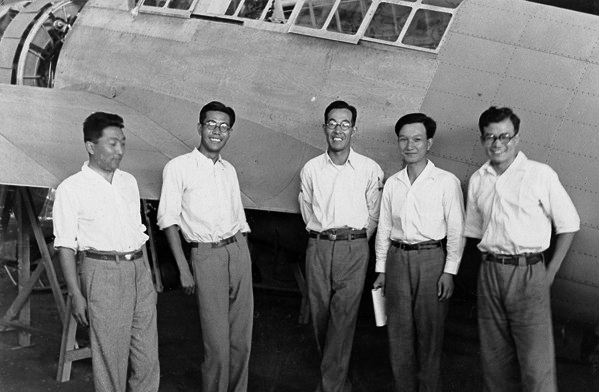
The young and very talented design team behind the Mitsubishi A6M1 Type Zero. A smiling Dr. Jiro Horikoshi is at the center. His assistant, Yoshitoshi Sone, is at the left. (Mitsubishi Kokuki K.K.)
Construction of the first prototype started circa in November 1938, completed in March 1939. This very first Type 0 weighed… 43,801b which was ludicrously light even compared to the gracious Spitfire prototype (53,32lb). So despite a modest output and helped by a sober consumption, the model maintained both long range and good performance and agility in all corners. That however meant future, heavier powerful engines could not be fitted without extensive redesign. So the offensive first, agility first doctrine eventually contained the seeds of its own downfall and never having a true successor.
Nakajima understood quickly these limitations and after trying to upgrade the Ki-43 by creating an interceptor derivative, the Ki-44, soon started again from a blank page with the Ki-84 whereas Mitsubishi condemned the Navy to stick with the A6M until the end of the war. The A7P (see later) indeed would never be ready in time. The Navy was nevertheless quite impressed with the prototype, which started unofficial tests at Mitsubishi’s Nagoya factory on 16th March 1939. Various systems were started and closed, flight commands, starter, ect.
Full engine tests started on the 18th, before being towed by ox-cart to Kagamigahara airfield for full air tests. Test pilot Katsuzo Shima had the privilege of “deflouring” the A6M, lifting off at 5.30 pm, 1st April 1939 for the maiden flight. Problems were detected with the braking system. Excessive vibration too in flight, which were common for new models. After extra bracing and solving minor issues, the Navy staff was invited for official tests of the model now called the “A6M1”, using an identical prototype.
On April 25, 1939 the first flight showed a limited top speed due to unsufficient output, compared to new fighters created in Germany, Great Britain or the USA now gearing up for 1000 hp+ gines. On May 1, Kaigun Koku Hombu instructed the powerplant team to install on the first prototype, now inactivated for further factory tests, the Nakajima Sakae 12 rated for 940 hp. While being refitted on October 18, the second prototype was tested with a three-blade propeller, seemingly superior and full armament set. These were factory tests though, performed whereas on October 25, the model was was accepted by the fleet. Weapons testing started later in October, with excellent results as for acuracy, nine hits sercured out of 20 shells, in flight on a 19 m2 ground target.
The third prototype was in fact the very first pre-series A6M2 fitted with the Sakae 12 engine. To install it, the engine mount and hood were reworked to accomodate the larger Sakae and for minimizing and keep forward visibility, designers made the hood a very tight fit, a veritable glove around the engine. The first consequence was unsufficien engine cooling, an issue the designers took considerable effort to solve. The team also worked to eliminate a noted tendency by test pilots to a flat spin and so the tail was redesigned, with its cord moved back, the horizontal tail shifted up resulting in this elongated “tail” and almost triangular shape, and increased length. The original configuration can be seen on the production A6M2-N “Rufe”.
This third prototype was vital to secure mass production, at Nagoya aircraft factory No.3. The Navy the lack of outright speed at 304 mph instead of 315 mph as asked for, had all the remaining requirements met and teething issues worked on actively, so it was officially accepted on the 14th September 1939. And it was time: War raged in Europe since the 1st. This order came even before the completion of the full test cycle, and it gained its Full military designation, to be communicated to all branches of the administration, as “A6M1 Type 0 Carrier-borne Fighter”.
Name and designation
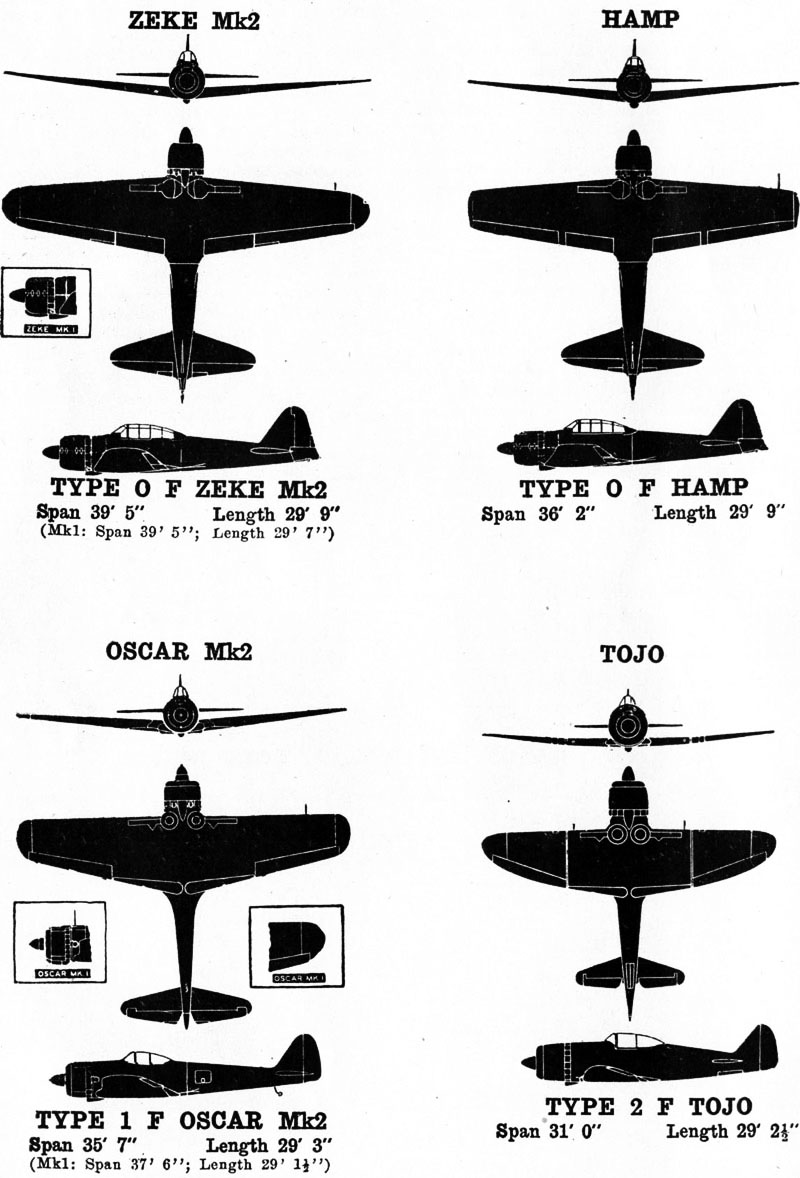
ONI comparison between the “Zeke” and “Hamp”, believed to be a completely new aircraft.
And this brought us to the famous name of the model. Unlike later WW2 models which for propaganda reasons received nicknames instead of the cold navy designation (the army did the same), the usual practice for pilots and personal was to call it the “Rei-sen” an abbreviation of the full designation. It was by no means official or had any meaning. Also, A6M referred to A for the type (fighter), 6 as the sixth fighter model designed by Mitsubishi, and of course “M” standing for Mitsubishi.
The ‘0’ however, derived from the last digit by virtue of the unique Japanese calendar in reality came from the year 2600 (1940) and the “Rei Shiki Sento Ki” shortened to Rei-Sen or Reisen could mean “zero” by simplification. It became popular, but was not official in US Intel either. In 1941, the Allies applying code-names to all models had the A6M2 designator chosen being ‘Zeke’ last letter in the alphabet in reference to the “model 0”, “Zek” being a contraction from the biblical name “Ezekiel” although “zero” while not official became far more popular.
The cut-wings version A6M3-72 was designated ‘Hamp’ and the A6M3-22 ‘Zeke Mark 2’, the A6M2-N ‘Rufe’ (see later). ‘Zero’ in western sources mostly became first popular by US use, as British personnel in Singapore/Malaya called them first as ‘Navy Noughts’. The model became so feared (a bit like the Tiger tank of the Wehrmacht), that the handy nickname of “Zero” became a reference for all Japanese fighters in the general public and the press, obscuring many other models, including those of the army. It has been maintained the same way over many years in popular culture, as basically the only known model by the general public. Even among pilots, especially in 1942, “Zeros” were seen everywhere despite they encountered the “Oscar” or its successors. Despite it’s many design changes, the A6M5 also kept the famous name.
Initial Reception
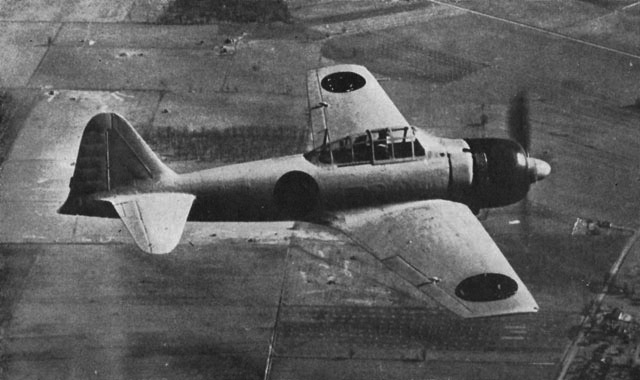
ONI, the “Hamp”, A6M2
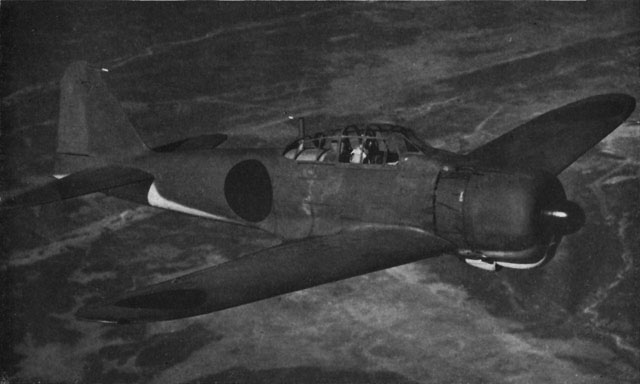
ONI, the “Zeke”, A6M3
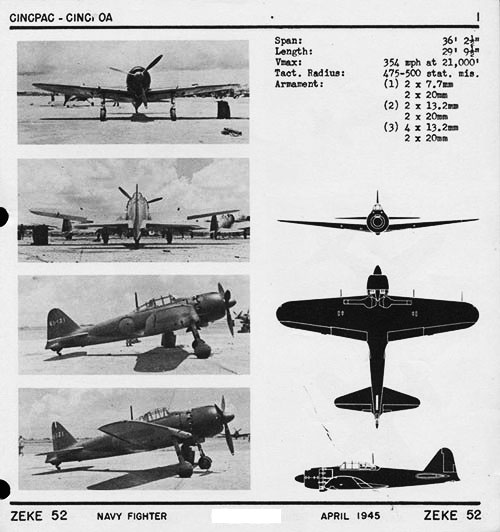
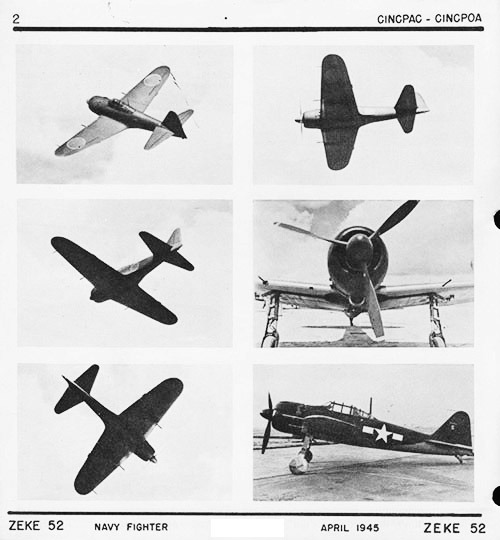
ONI depictions of the “Zeke 52” (A6M5)
The pre-production batch was received for military testing at Yokosuka kokutai, stationed at the Oppama airfield. This instructor/test unit was the most famous in Japan, staffed by the most experienced pilots of the IJN. They were all fully able to appreciate the model, and in their initial reports, spoke highly of its flight characteristics, rivalling in superlatives terms. The A6M1 was trouble-free in addition, which added to the immense trust they had for it, apart a serious incident on March 11, 1940 when test pilot Okuyama flying the second prototype tested overloading the engine with revolutions in a steep dive.
The second approach from 1,500 m to 900 m at 50° angle generated such vibrations and noise the suddenly exploded, leading the prototype to burst into pieces, with the pilot thrown out of the cockpit at 300 m. His parachute opened, but the schock was such the pilot was pulled out of the belts and fell into the water at great speed, killed instantly. Exact cause could not be determined although some expressed that perhaps the aileron balancers broke resulting in the initial vibration that destroyed the aircraft. This, the initial order delivery schedule was pushed from May to July 1940, leaving time to strengthen the attachment points of these balancers, as well as the rudders.
Final tuning as production took place added pressure from the high command and military personal, as its amazing flight qualities spread like live fire from Oppama among aviators. Some went off working hours to see and test it of possible, while Mitsubishi was trying to manage the best flight range as requested probably the most stringent and demanding specification. Extra rosy reviews came also from Yokosuka kokutai test pilots despite Mitsubishi’s insitence that their “product” was still unfinished.
On July 21, 1940, Kaigun Koku Hombu announced the reception of the first batch of six pre-production fighters, which flew to Hankou in China, staffed with pilots from Yokosuka Kokutai led by Tamotsu Yokoyama. The small contingent was integrated into the 12th Rengo Kokutai. Back in Japan, the next batch of pre-production aircraft were sent straight to IJN Kaga for carrier qualification. After successful completion, the A6M2 model 11 was accepted into service, gaining the “Reisen” moniker. These nine carried fighters also departed for Hankow, reinforcing the 12th Rengo Kokutai (which had a first loss due to AA at the time).
Problem with engine cooling were solved by using tin deflectors installed on the cylinders of the first row meanwhile. Their effect was to directing air jets to the cylinders of the second row. This became the standard for all variants, whatever the engine, but another issue was revealed in front-line conditions which was the frequent jamming of the ventral fuel tank discharge system. This unwanted “ballast” created drag under the fuselage, reuniting the aerodynamics qualities of the aircraft to some extent.
Design evolution
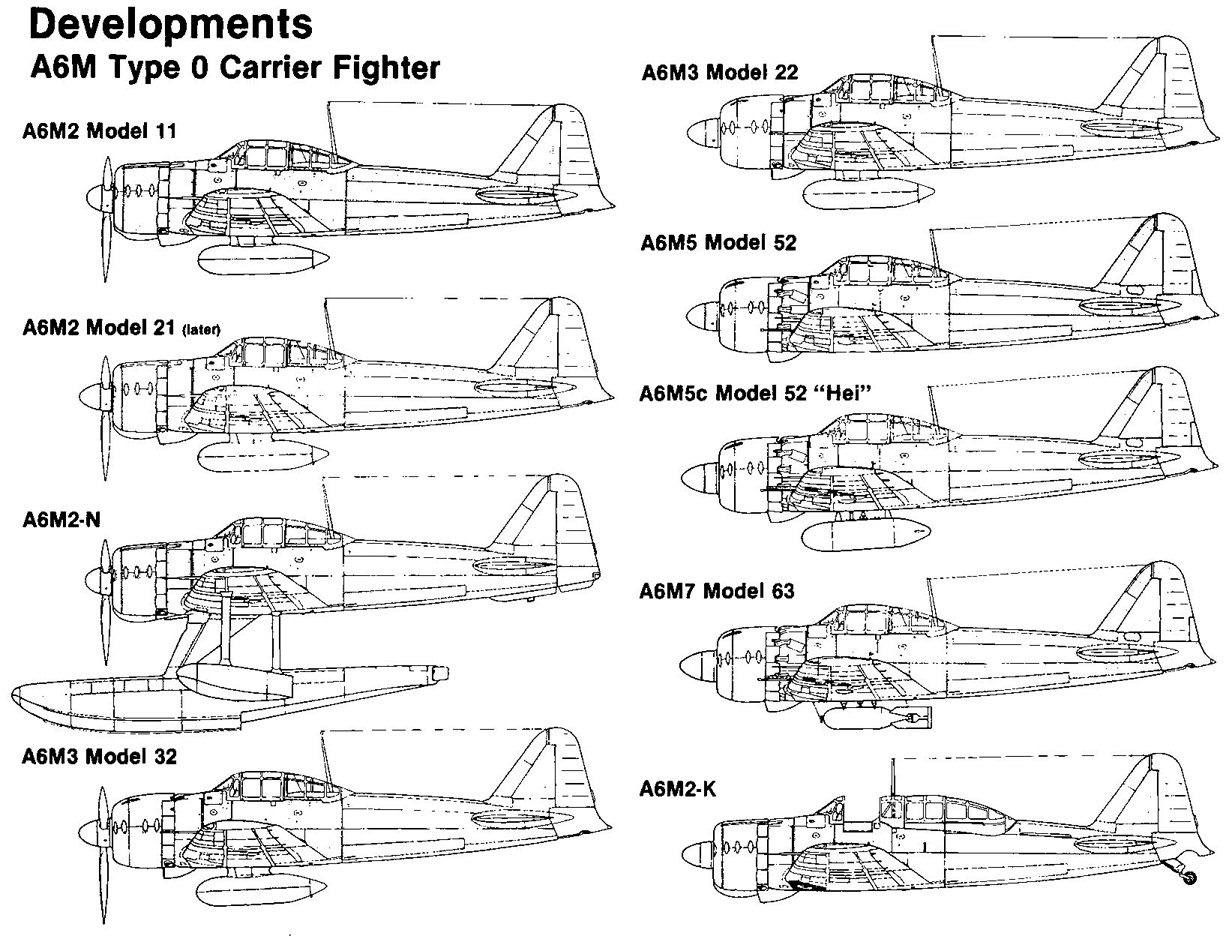
Variants
Mitsubishi being asked, despite the acceptance and first order, to solve the lack of speed, concentrated on the next iteration in 1940, the A6M2. Same model but with a the more powerful 940hp Nakajima Sakae 12 engine. The A6M2 was mostly modified with extra bracing for the larger, heavier engine, and the first 15 pre-production models were sent to Hankow, China for operational trials, starting on 21 July 1940. First combat missions started, showing a clear cut superiority over any model of Chinese fighters. Only two Zeros were lost in these early operations and it was by AA fire, traded for many, many kills, fighters and bombers alike. They ruled the skies over China, at least in dedicated coastal areas. More inland, the Ki-43 made it’s combat debut also, leading to interesting comparisons.
Mitsubishi built 47 more A6M2 Model 11 by November 1940 and started working on the Model 21, to answer a regular critique. The wing structure intil that point did not supported the complicated gear for wings folding. A first measure found was folding wingtips. The passage from “11” to “21” denoted this airframe change, the other digit, the engine change. The A6M2 Model 21 thus became standard at the time of Pearl Harbour, 18 mo,nths after its combat debut. There were 328 of these in JNAF units, the bulk of some 521 naval fighters aboard carriers of the Kido Butai (1st fleet air arm). The A5M was now relegated to light carriers, land-based units and theaters, notably in China.
1941 saw an effort by the design team to try overcoming the A6M initial design limitations, to keep its superiority over Allied fighters. This led to the design of the first real all-out improvement, the A6M3 Model 32 which was redesigned around the 1,130 hp Sakae 21 engine. For simplification the folding wingtip section was removed for a simplified clipped wing. The centre of gravity was also moved back towards the bulkhead and this reduced in turn the fuel tank volume.
Later came the Model 22 which saw the return to the folding-tip wing and fitting an extra 12 gallon fuel tank in each wing to reclaimed the lost range (it was still superior to any allied fighter). Meanwhile, engineers worked on an even greater improvements, the Model 52. The Model 22 had a fairly short operational life and production with just 560 delivered between 1942 and 1943, including those by Nakajima.
For most naval air historians the A6M5 Model 52 was really the “game changer”, less compared to the Model 32 it replaced, but compared to the A6M1 as a whole. Helped by some weight saving in the wing, heavier gauge wing skins were possible to make for higher dive speed (a point which was lacking previously, the F4F could escaped that way, being way more rigid), and the engine had a new cowling caracterized by individual exhaust stacks for additional thrust. This became in 1943 the standard, most numerous and used version overall.
The Model 52 became outdated however by 1944 as already by mid-1943 it did not fared well compared to the beast that was the F6F, so further modifications were pressed on, all severely hampered by the limitations of the initial design. Meanwhile, Mitsubishin came with the A7M Reppu and J2M Raiden, the latter entering service unlike the first in small quantitied, and Kawanishi with the excellent and N1K Shiden, but these complicated design failed to obtain masse production and Mitsubishin’s factories were stuck with a 1940 model that cannot be upgraded any longer.
To try improve altitude combat capabilities and enabling some interception capabilities at a time the Empire was on the defenseive, Jiro’s team managed to pull out the ramarkable A6M4, first with a turbo-supercharged engine and the A6M6 using water-methanol injection. The Navy also wanted a more serious fighter bomber from it’s standard model leading to the development of the A6M7 and eventually to the A6M8 fitted to endure the massive 1,350 hp Kinsei engine, almost twice the power of the original Suisei 13 and its 875 hp. Their development was complicated by shortages of all sorts plus bombings, and in small quantities.
Design Features
-The Zero also revolutionized the way naval fighter could operate, by bringing an amazing radius of action, twice the previous figures in the IJN: 1,180 miles. Ex. The FAA Sea Hurricane was limited for example to 600 miles, the sea spitfire just 550, and the F4F 845 miles.
-The zero blended the limit between carrier-borne fighters and land based equivalents. When the zero was in service, the F4F was 4 months late in its introduction. For the first time a naval fighter, usually inferior to its land counterparts, could dominate the skies and dogfight with any model in the air at that time. This gave the fighter a “long arm”, ability to escort the attack planes to target, engaged the CAP in a long dogfight further straining gazoline, and came back escorting all the way. It could strile by keeping the carriers out of arm’s way. This range completely deceived US commander in 1942. ONI figures were totally underestimated at around 800 miles and surprise total in operations. Having a 500 miles radius of action around a carrier was unheard of, and decisive. Their appearance seemibly in many places at once made the US think the Japanese had far more zeros than in reality.
-Thus, it was clear the US intel needed to have their hands on a zero at all costs. It became as much top priority as for the British cracking for example the Enigma code. However in almost all cases, down Zeros were so light they disintegrated, leaving practicall nothing to study but scattered small remains on miles on end. The first occasion it nearly happened was over Parl Harbor in Dec. 1941, as two of these were shot down, but the first landed on its belly, but slided and crashed into N.4 hangar at Kamehameha. At least the rear section survived well enough to be studied. Another crash-landed on its way back to the Kido Butai, also making a controlled belly-landing on Nihao Island. The pilot, Shigenori Nishikaichi was captured by local Hawaiians, but managed to escape, returned to his planes and burned it entirely, before being caught and killed. The first would be captured in Alaska. This was a crucial blow as the Japanese lost their secrecy and pilots were duly briefed on the strenghts and weaknesses of the nible champion.
-August 1940: Start of service. Sept. 13 first victory over China 30 Chinese fighters I-15/I-16. 30 min. dogfight over chongking. Saburo Sindu claimed 20+ Chinese down without any loss, but four zeros damaged.
-The “zero” had a indirect major shortcoming: Its production. Interservice rivalry first objected to adopt the A6M despite it’s qualities, and even for the Navy itself, Japan lacked the engineers, the economic muscle, and the industrial culture needed to rapidlt ramp up to wartime production the way the US did. By late 1943 still, the Zero, was still hand made by skilled laborers. The models were only made in Nagoya and parts conveyed by mostly primitive means: Oxen were carrying these between facilities ! Due to the absence of airfield or railway nearby, not good roads and the fear to damage tghe delicate fighter on trucks, so they were carried the old way for 34 miles being final assembly.
General structure
(To come if i can find infos)
Engine
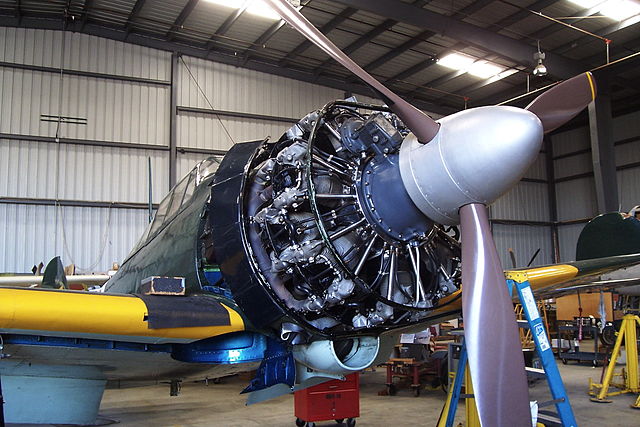
A6M5 Sakae engine without cover. A distant licenced mix of Hawker Siddeley, Bristol Jupiter and Wright Cyclone designs studied and improved over the years.
The A6M1 engine was not the one initially planned for production, but a quick in-house production model to speed up testing. It was the Mitsubishi MK2C Zuisen 13: A 2-row, 14 cyl. radial air-cooled, supercharged engine with a cubic capacity of 28.017 liter (1,709.7 cubic inch displacement) and rated for 780 horsepower. It was half the final evolution of the Type 0 A6M7.
The first standard engine of the production A6M2 Model 12 was the air-cooled, supercharged, 27.874 liter (1,700.962 cubic inch) Nakajima Hikoki K.K. NK1C Sakae 12. This was a two-row, fourteen-cylinder radial rated at 925 horsepower coupled with a three-bladed Sumitomo constant-speed propeller through a 1.71:1 gear reduction. The Navy found it lacked power and wanted to swap to the next model in development.

Various hood and cowling designs between types
This gave the A6M2 Model 22, powered by the Nakajima NK1F Sakae 21 (hence the model name) 14-cylinder radial rated for 1130 hp and equipped with a two-speed supercharger. A single A6M3 was tested with a Sakae 12 to but posed weight distribution and center of gravity issues. Differences between the Sakae 12 and 21 were the bulbous reduction gear housing around the front of the crankshaft (absent from the Sakae 12). The Sakae 21 had the Naval designation NK1F, first letter standing for the manufacturer, Nakajima, K for “air cooled”, 1 for the sequence number within given class of engines and F for the version of the engine. The Sakae 12 was also called NK1C.
Specs were as follows: Cruise speed 207 mph (333 kilometers per hour), max 277 mph (446 kilometers per hour, Sea Level) or 335 mph (539 kilometers per hour) at 16,000 feet (4,877 meters) with a ceiling at 37,000 feet (11,278 meters), maximum range to 1,175 miles (1,891 kilometers). This was less than the A6M1 and go go downards until measures were taken to reclaim the lost fuel.
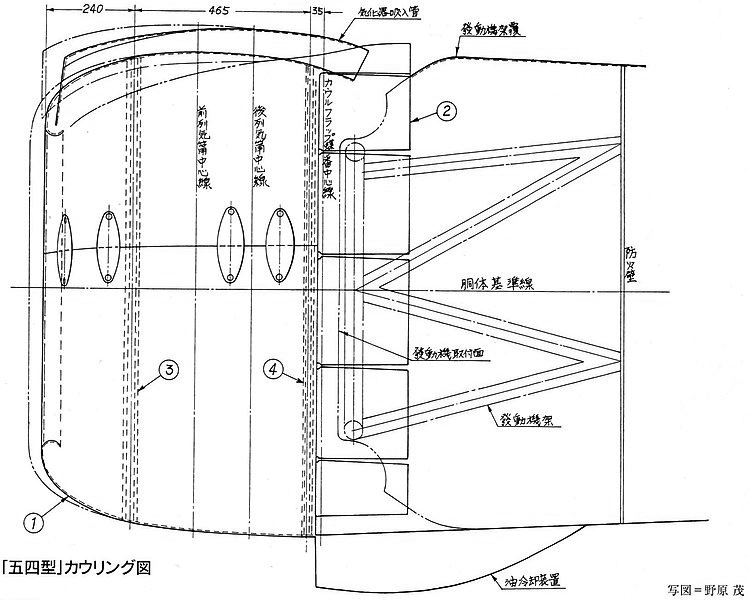
Cowling of the experimental A6M8
The standard A6M3 was given the Sakae 21, with a new 2-stage mechanical supercharger, improved gearbox, upflow carburetor rated at 1130 hp on the Model 21. This was the “chopped-wings, low range” Zero of the whole serie. The A6M3 M22 regained some range. The A6M4 was a rare, mostly experimental variation with a turbocharger which never worked properly mostly due to materials issues. The A6M5 kept the same engine with minor improvements, and the A6M6 tested the Sakae 31a engine with water-methanol injection, never passing out the prototype phase, but pushing the figure to 1,210 hp (902 kW).
The A6M7 had the 1,130 hp Sakae-31 engine. By 1944 when it was tested, this was 1,000+ hp shy of most allied fighters. This engine remained the most powerful on offer before Mitsubish came out, two years late, with the Kinsei 62 engine, capable of 1,163 kW (1,560 hp). It was adopted by the prototypes A6M8 but never saw action. Thus, the Zero made all its WW2 career with 1,000 hp like some Italian fighters. It was not a problem as long as the superstructure remained light, but demands for protection and better armament rose weight considerably and performances stayed on the same range all along, with decreasing range to boot.
Armament
The Production A6M1 was given a couple of Dai Nihon Heiki K.K. Two Type 97 7.7 mm (.303-caliber) light machine guns were mounted in the hood, firing in slight channels, and synchronized with the propeller arc. These were licenced Vickers Type E .303 machine gun, so they were liquid-cooled. 600 rounds in sore for either, with tracers. This was coupled with two Type 99 20 mm autocannons mounted in the wing, but with just 60 shells per gun. Both were licensed Oerlikon FF guns. No rack was installed to carry bombs unlike what was planned (aktghough fittings were there), but a belly extra fuel tank as the range was already insane for the time.
Specifications for the 1937 12-Shi fighter called two 20mm cannon, two 7.7mm LMG, racks for two 60kg bombs, and with A6M3 Model 32 no modifications were made but in the channels which the LMGs fired through as the engine hood grew in size. Ammunition supply for wings cannon was a main criticism, and it was increased from 60 to 100 rounds per gun. Same for the Model 22. The Model 22KO or A6M3 Model 22a had longer-barrel cannons. Some Model 22s experimentally tested a 30mm cannons, in combat at Rabaul. But vibrations were just to much for the wings.
The 7.7mm machine guns had a capacity raised to 680 rounds each and close to the Army Type 89 MG with belt ammunition for a 1000rpm rate of fire and effective range of 600m. They had a muzzle velocity of 2460ft/sec and weight 26lb each. Replacement on the field and service was easy. Not so much for the 20 mm wing guns.

Divergence path between the 7.7 and 20 mm.
The wing Type 99 cannons of the Model 22 used drum-magazine types (100 rounds) belt-fed later to reach 150 rounds. The Model 22a or Model 2 Shiki 3 with a longer barrel reached 490rpm at 2,000ft/second, and useful range of l000m. The 30mm Type 5 tested by just three A6M3 Model 22 were limited to a 45-round magazine, with a muzzle velocity of 2460ft/sec, but as said before was not adopted.
The pilot could aim via a Type 98 reflector gunsight mounted in front of his position, the tube going through the front glass, but for post-action briefings an optional Type 89 camera-gun could be fitted to the port wing root. The Type 89 Motion Picture Gun 2nd remodeled No/3899 from Roku Sakura.
Armament was augmented on the A6M5a, with belt-fed Type 99-2 (long barrel) 4-shiki, to 125 rounds per gun. The next A6M5b replaced the right LMG by a single 13.2 mm Type 3 gun with a 790 m/s (2,600 ft/s) muzzle velocity and, 900 m (3,000 ft) range, 800 rpm, 240 rounds in store. That was an appreciable increase of firepower, but asymetric. The A6M5c was even more powerful and engineers managed to shoe in two extra 13.2 mm (.51 in) Type 3 machine guns (same model as on the hood) in the wings, outer portion from the cannons. Although ammo was limited they had on paper more firepower than their adversaries given the fact 20 mm superior to 0.5 in HMGs. However the left hood 7.7 mm gun was deleted, making room for extra ammunition for the right Type 3 HMG. In addition the underwing was reinforced to accept four racks carrying each a small 60 kgs incendiary bomb or rockets. The “special type” bakusen was a modified fighter bomber substituting to the drop tank rack, a bomb rack to lift a 250 kg (550 lb) bomb.
Eventually the little-known A6M8 fitted with the most powerful engine of the serie, had a brand new cowling now with a pair of 13.2mm Type 3 HMGs and those in the wings replaced by two more of 20 mm for four total, each with a 125 rounds belt. Unfortunately, Only two prototypes were built, this model never saw combat. This was a sharp contrast to its Army rival Nakajima Ki-43 Hayabusa which at its beginning only carried two 7.7 mm LMGs.
Cockpit, Equipments & Avionics
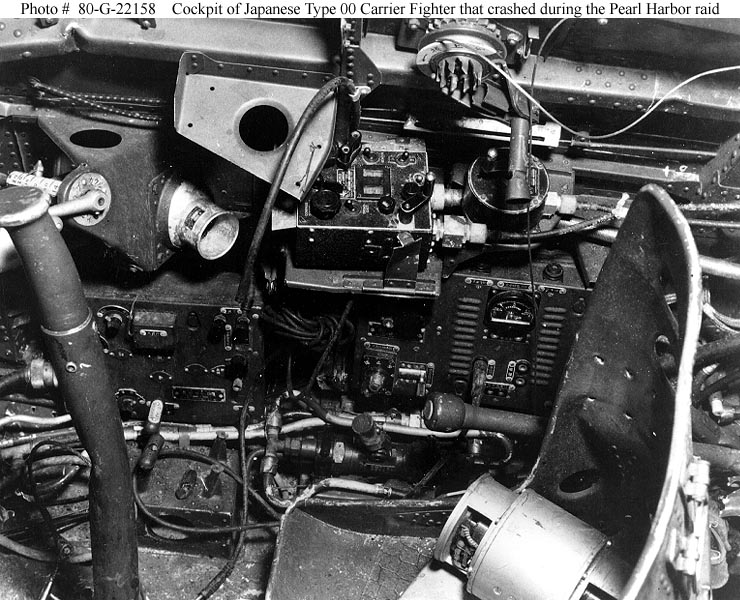
On the A6M2
The Zero cockpit was clear and simple to read, with the lightest materials possible, and common dials for several metrics to save space and weight. It also made for a less complicated electric wiring, less chances of a shortcut and fire. The two most important dials for the pitch and yaw and speed indicator were placed right between the central console, either side of the 7.7 mm machine guns, which took some internal space but could be serviced by the pilot. The rest of instruments, 13 different dials mostly related to the engine’s rpm and oil, avgas indicators among others, was located below. Extra gauges and dials were located on the right side, along with control levers. See also a 360° view.
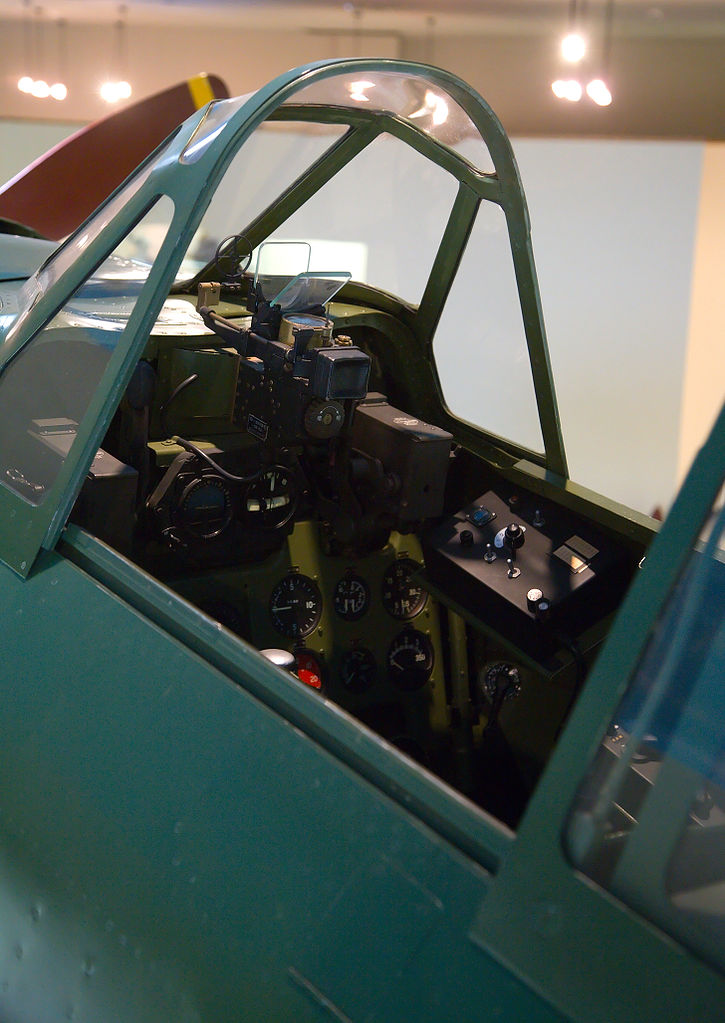
On the A6M5
Normal provision was a full radio fit with a direction finding equipment. The radio direction indicator was located at the lower left of the instrument panel with a console on the right side of the cockpit, close to the inertia panel of Zerostarting handle. The proper radio control unit was located on a console rear of it. The loop antenna was installed behind the pilot’s head, under the glass cover, and can be manipulated through a control handle a the rear of the radio control unit. The wooden mast (because lighter) rear of the cockpit supported the radio aerial connected to the fin top. To serve the radio a transformer and battery were located inside the fuselage, behind the pilot’s seat. The Model 11 standard model was the Type 96-Ku-1 radio, complemented by the Type 1 Ku-3 direction finder. The Model 22 was likely equipped the same way.
Final assessment
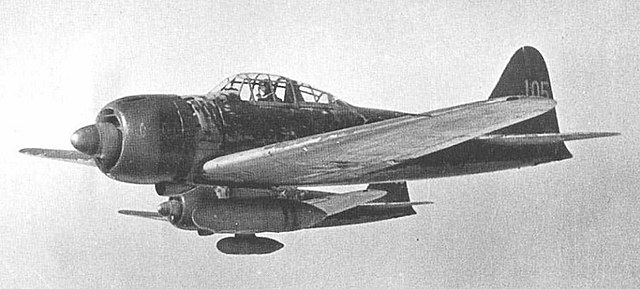
IJN Ace Nishizawa’s A6M5 UT105, 7 May 1945. The worn out dark olive green paint factory applied is well visible here.
When it was introduced in early 1940, the “Zero” was one of the most modern carrier-based aircraft in the world. Its oppositon in the Royal Navy was the heavy Fairey Fulmar and in the US Navy the Brewster F2A Buffalo, to the point of being superseded by the Grumman F4F Wildcat. Until the introduction of the F6F Hellcat from mid-1943, the Zero was almost “untouchable”.
Its main advantages as a dogfighter were a fairly high-lift, low-speed wing and very low wing loading. It also had a very low stalling speed (below 60 knots or 110 km/h, 69 mph). Its “phenomenal” maneuverability as recoignised by its foes over China and Chennault’s “Flying Tigers” already in 1940 (equipped with the Curtiss P40 Warhawk) allowed the A6M to out-turn any Allied fighter of the time. Eearly models were fitted with servo tabs on the ailerons, after pilots complained about too heavy commands at above 300 kp/190 mph. That was the price for lightness as, these features were planned bu not included. However, servo tabs were retired, as with this lightened control forces pilots had much confidence to overstress their airframe, making quite vigorous maneuvers while not always grasping how flimsy was their fighter to endure G-Forces.
In fact, first information seeping through about the new Japanese “superfighter” arrived peacemeal in Europe and America, both in vague and contradictory terms. The existence was noted in reports by many observers, notably Colonel Claire E. Chennault, working still as an adviser to Chiang Kai-Shek, before meeting them in person with the “Flying Tigers”. These messages were not given the same importance given the isolationist policy of the US at that time. This majority simply wanted to prevent an increase in military spending, and spread the opinion that this new mystery fight was just a “pale copy” of European models. There were some ground for it, with only proofs such as licensed/copies of the Hamilton-Standard propeller, Bendix chassis, Palmer tires, “Sperry”, “Pioneer” and “Collsman avionics, “Oerlikon” cannons and “Vickers” derived light machine guns. At the same time, the press was far more enthusiastic about the new Lightning, Corsair, and Mustang in development, they assumed would be infintely superior.
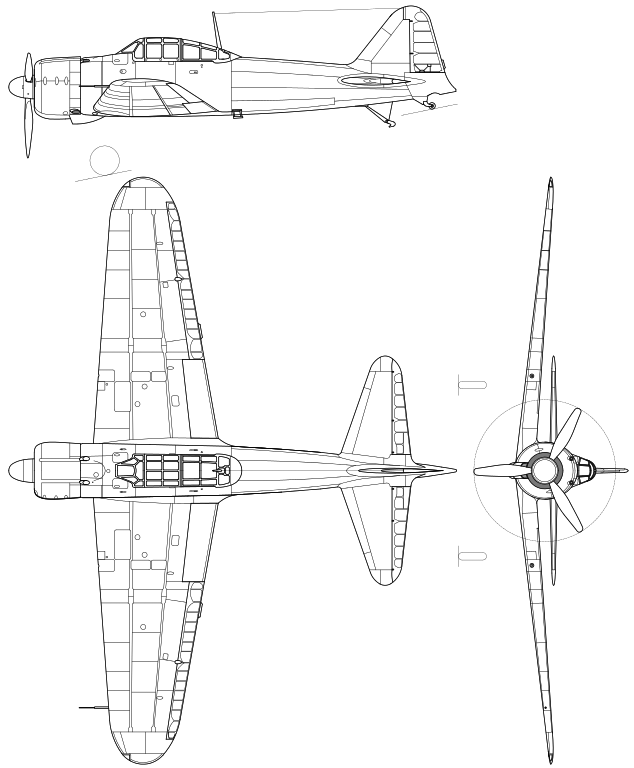
A6M2 drawing
However the rampaged of the Zero in air battles in China also convinced the Japanese military that Japanese aviation overall could gain incontested air supremacy, not only over China, but over Asia at large. The common belief at the time was that a single Reisen even in the hands of an experience pilot, could down from two to five enemy aircraft in a first encounter. Such calculations were recalled during heated discussions when considering war against the USn despite contradictory opinion (generally from the Navy and Yamamoto in particular) about the economic superiority of the United States.
The hope of a short war, just like in Germany in 1939 was that six months would be sufficient for Japan to expand rapidly in all the pacific and create a “glacis” containing enough resource for a possible war or attrition although most believed (hoped) that the “decadent west” and rampant pacifism would prevail. Qualitative advantage was seeked for already in all branches of the military, navy included (examples were many, like the “long lance torpedo”, the Yamato super-battleships, giant aircraft-carrying submarines, superior destroyers and cruisers, etc.).
The “superfighter” fully met this picture. But its high qualities, praised at the start and proven time and again until late 1942, brought the IJNAF it’s own demise, as specialists of Kaigun Koku Hombu missed the moment when work on its successor, from a black page, was to start. It should had started right in 1941, but at the time the military simply did not believe their wonder machine would become obsolete within the “six month” campaign credo. A fatal mistake as the Zero soldiered on until 1945 with significant but not game changing improvements.
Production & Variants

Technical tree of all versions
In the end, Mitsubishi, which facilities were tailored initially for peacetime and had a rather low output and limilited possibilities only produced 3,879 out of more than 10,000. This is, ironically its competitor, Nakajima, who assembled the remaining 6,215. The remainder were 844 spread between trainers and floatplanes, also built by Nakajima, which had larger and better facilities.
A6M1 (1939)
Initial prototypes, two which carried this A6M1 designation. The A6M1 was really the ideal “pure” zero as it was first thought of. It’s super light structure made the best of the 700+ hp of its tiny original engine, manoeuvrability was superb with a turning circle barely larger than that of the A5M, and extraordinary range for any fighter. The two prototype A6M1s were powered by the air-cooled, supercharged, 28.017 liter (1,709.7 cubic inch displacement) Mitsubishi MK2C Zuisen 13, 2-row, 14 cylinder radial rated for 780 horsepower (takeoff). It was coupled with a two-bladed variable pitch propeller, later three-bladed Sumitomo constant-speed propeller after early trials (license-built Hamilton Standard). The second prototype was called c/n 202 and contributed to the September 1939 acceptance trials by the Navy. Next would be production (pre-prod batches initially) A6M2s. Name Rei Shiki Sento Ki, or “Rei-Sen,” was chosen.
A6M2 M11 and M21 (1940)
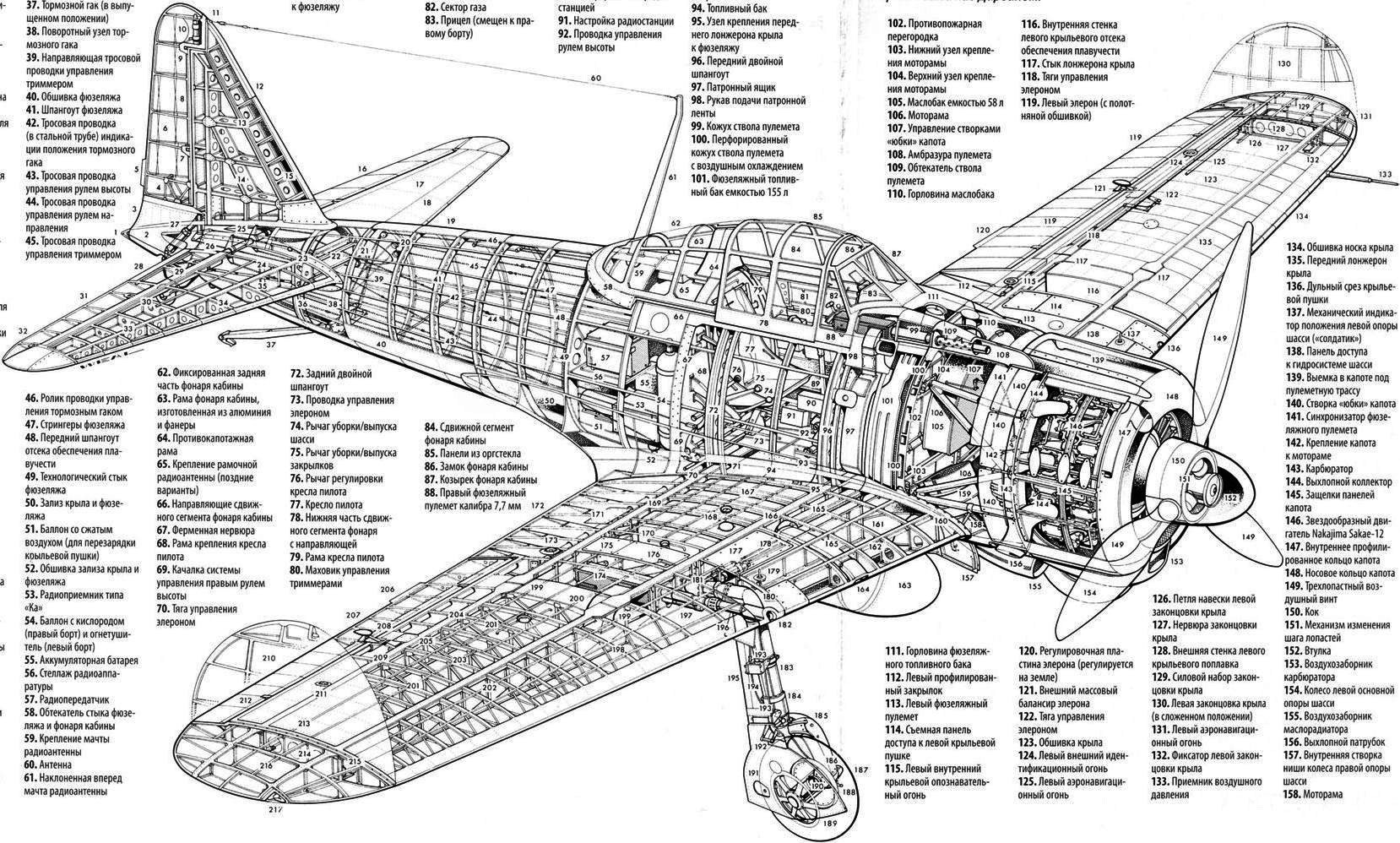
Tech cutaway of the A6M2
A total of only sixty-four A6M2 model 11 with serial numbers from 3-67 were built. The first wave of modifications saw the strengthening the rear spar of the wing from the 22nd model. From 37th location of the exhaust pipes was moved away to the fourth flap regulating engine cooling and fifth. The port’s cross section for the wings guns was reduced, the cabin air inflow holes for ventilation were relocated at the leading edge of the right wing console. The 47th introduced a modified glazing of the cockpit rear canopy.
Tests on board Kaga the fit in a standard lift to be very tight, with a gap too small to safely move it from the hangar to the flight deck and back. Personnel successfully coped with this problem nevertheless, fing ways for a perfect firt on the lift each time, but doubts came about the same in the heat of battle. So Mitsubishi introduced wingtips manually fold. Minor improvements consisted in changing the cross section of the cannon ports, cabin ventilation air intake, leading to the A6M2 model 21.
From the 127th the Model 21 received a new aileron balancer adjustable on the ground after the April 17, 1941 crashed that killed Lieutenant Shimokawa due to vibrations (see abiove). From November 1940, it was also built by Nakajima (Koizuma plant) in two years, for a total of 740 A6M2 model 21 at Mitsubishi and 800 for Nakajima, which developed from it the A6M2N “Rufe”.
The “zero floatplane”: A6M2-N “Rufe”
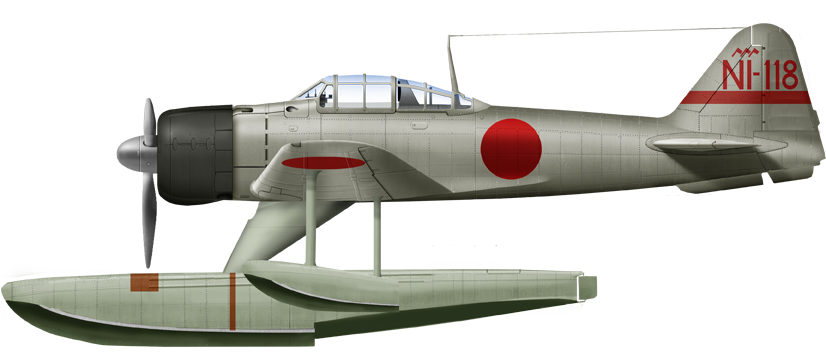
The A6M2-N floatplane was developed as requested by the Navy to support amphibious operations (operated by one of the many IJN seaplane tenders), or defend remote bases. Based on the A6M-2 Model 11 technically, it had a modified tail to keep stability with a much higher drag, cauised by the added floats: One large under the fuselage to keep balace and two small underwing. 327 total were built, and it was deployed in 1942 as the “Suisen 2” (“Hydro fighter type 2”). Its first actions were mostly defensive, in the Aleutians and Solomon Islands. They were found surprisingly good at harassing PT boats at night, causing the latter to increase AA and adopt projectors. They were also found useful to drop flares on them, allowing destroyers to fire on them.
A6M2-N also were used to protect fueling depots in Balikpapan and Avon Bases in the Dutch East Indies, sparing land fighters or the Shumushu base in the North Kuriles, relatively “quiet” sectors. They were operated notably in several operations from IJN Kamikawa Maru in the Solomons and Kuriles and the Hokoku Maru and Aikoku Maru during the Indian Ocean raids. The Aeutians saw the first kills, RCAF Curtiss P-40 Warhawk, Lockheed P-38 Lightning and B-17 Flying Fortress. They were found versatile enough to be used for patrols, as fighter-bomber and short reconnaissance support during amphibious landings, spotting targets of opportunity for escorting vessel’s artillery.
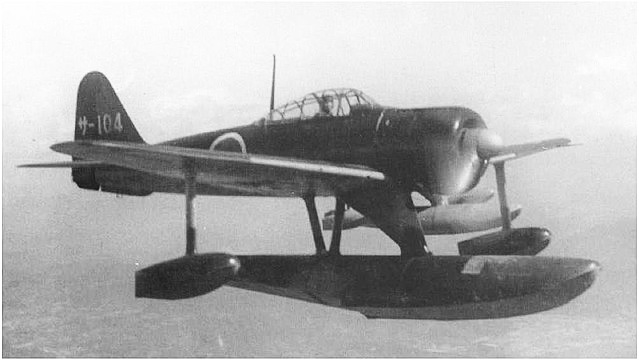
The “Otsu Air Group” used them alongside the Kawanishi N1K1 Kyofu (“Rex”) from the Biwa lake, Honshū area. The French forces in Indochina managed to captured and test one of these, until crashed after being overhauled.
A6M3, the chopped off wings version
A6M3 M21
By mid-1941 the company agreed with pilots that the recently introduced A6M1 needed modernization. It turned out the pilots wanted to strengthen firepower but it was not done due to structure issues, and improving maneuverability was not considered, however speed qualities were. The adoption of the Sakae 21, with its two-stage mechanical supercharger and improved gearbox plus upflow carburetor for a, output of 1130 hp, improved high-altitude characteristics, but the increased weight diminshed somewhat agility.
To compensate the fuselage’s fuel tank was reduced from 98 to 60 liters, whcih reduced the range accordingly. An advantage early in the war, it was not that important. The hood was also modified, to accomodate a new supercharger air intake above the engine, raised with now machine gun’s characteristic channels. An automatic, larger propeller of 3.05 m was also installed from 4th production model, and ammunition load (by default of armament) went from 60 to 100 shells per barrel for the main wings 20 mm guns. It was in larger drums, protruding beyond the wing, so now covered by a fairing. Ailerons were also modified, without the initial and fragile complex two-stage control system.
A6M3 M32
The A6M3 entered service in June 1941, so even before Pearl Habour, and had their first tests in China. Reports shows performances were increased to a lesser extent than expected. Many pilots also wanted to abandon the wing folding mechanism. Designers when decided to have the wingtips cut off along the folding line for it to still fit. Speed also increased a bit, and the wings surface lost, about a square meter deteriorated maneuverability to the price of increase climb rate at 6000 m in 7 min 19 s (7 min 27 previously). The A6M3 model 32 as a new model however experienced teething problems with the Sakae 21 engine, and production of just 32 was only reached by July 1942, with 343 total. This was pinprick compared to the next, main production version which was the one mostly encountered by pilots.
The “chopped off” wings version was assumed by the allies to be a new model and received the codename “Hap” (nickname of the USAAF General Henry Arnold), which ordered it was changed to “Hump” and eventually discarded in December 1942, and eventually with better intel, was called “Zek 32”.
A6M3 M22
When the Zero Model 32 arrived in frontline units a fierce battle developed over the Solomon Islands, compounded later by the crippling losses at the Battle of Midway and lack of airfield network in the combat area. This the admiralty returned to the demand of reclaiming range of the Zero, tat least close to the one of the A6M1. For this purpose, the A6M3 model 22 appeared with two additional fuel tanks holding each 45 liters located in the wing, near the weapon bays. Not to impair maneuverability wings were back to their elongated folding wingtips. In all, 560 model 22 were produced, including some Model 22a, improved with their type 99 model 2 guns with elongated barrel. Three aircraft also tested a new 30-mm guns, but the wings were just too “delicate” to withstand their recoil. Both variants of the A6M3 m32/m22 were built by Nakajima, to increase radically production numbers.
A6M4: The high altitude interceptor
The A6M4 model 32 was a new version using a turbocharger was used. Only two prototypes were built tested at the 1st technical arsenal of the fleet. Mitsubishi in fact forgotten all details about the designation “A6M4” and exact production records and Jiro Horikoshi himelf did not recalled the details. The model was developed in secrecy in a separate workshop around a small team. “A6M4” appeared on a captured Japanese memo at the Air Technical Arsenal dated 1 October 1942, only mentioning a “cross-section of the A6M4 intercooler”. Design and testing of this turbo-supercharger performed by First Naval Air Technical Arsenal at Yokosuka generated a report and at least one photo of a prototype exists, showing a turbo unit mounted in the forward left fuselage.
The main problem was then to get suitable alloys for the manufacture of the turbo-supercharger and its ducting. Bad quality materials caused ruptures, fires and degrading performance which cancelled further developments. The navy never accepted it, so the potential numbers Model 41/42 were never formalized, whereas the arsenal still used the designation “A6M4”. This experience was not lost as it povided technocal backrgound for further tests and engine designs. If production was never launch, Japan would never have its interceptor variant, the Zero staying a low-alt dogfighter to the end. But the J2M became that “bomber killer” ask for later, and work done on the A6M4 contributed to it.
A6M5
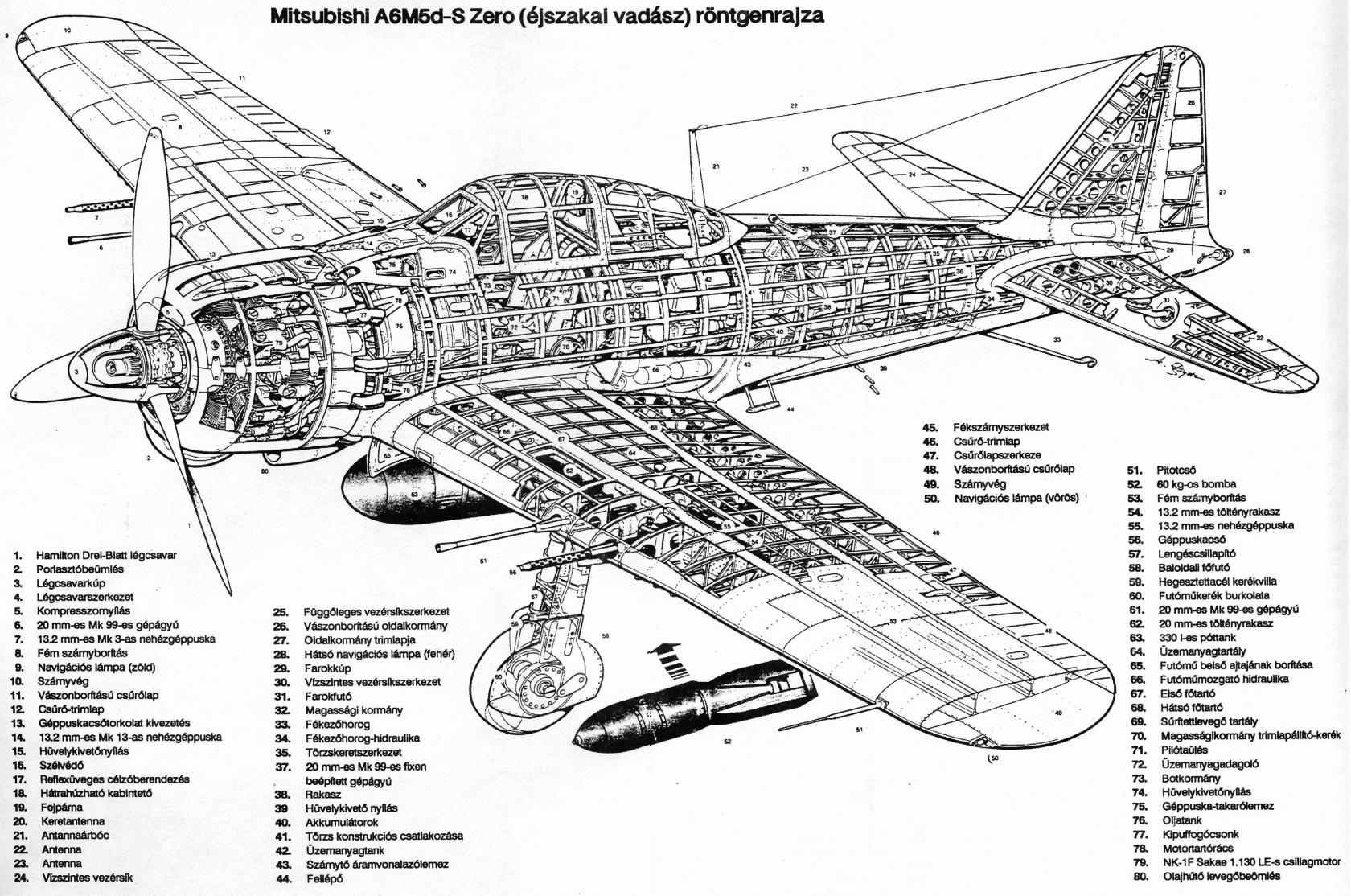
This was by far, the best known, best produced and numerically largest variant of all. But it was also the challenger of the new F6F Hellcat, among others. Its genesis went back to late 1942, when pilots reported on possible improvements on the A6M3. What became the Model 52 started over the same issues of getting rid of the mediocre wingtip folding system but shortening the wings while increasing speed. The aileron trim tab and flaps were revised first, and Nakajima, due to the poor daily rate of Mitsubishi, took on the bulk of the production. So the model could have been seen as the “Nakajima A6M5”. The prototype was created in June 1943 based on a production A6M3, making its maiden flight on August 1943. Performances were average, but better than initial models, thanks to hood and exhaust modifications, topping at 565 km/h (351 mph)) at 6,000 m (20,000 ft) with a climb rate of 7:01 minutes.
It seems that early production models were still fitted with the same exhaust system and cowl flaps as on the Model 22, but the upper cowling was redesigned towards the Model 22, while a new exhaust system was worked on, providing better thrust by spreading stacks aft with better distribution. The new exhaust system was completed by “notched” cowl flaps, and heat shields aft, not to damage the fuselage. From the 4274th model, another incremental improvement came with wing fuel tanks adopting for safety, carbon dioxide fire extinguishers. Still not self-sealing, that was at least one protection measure, sorely lacking. From #4354, a new radio, the Model 3 with its aerial Mark 1 with a shortened antenna mast were standardized. From #4550, the lowest exhaust stacks were made even compared to those above, but the first pilot flying it, reported these burned the forward edge of the landing gear doors and compromised the tires so from the next plane, #4551 Mitsubishi install even shorter lower exhaust stacks. Nakajima manufactured the Model 52 at Koizumi (Gunma Prefecture). The
A6M5a, Model 52
The M52 Ko, appeared from #4651 at Mitsbushi.
-Its armament was modified, getting rid of the Type 2 drums for the belt-fed Type 99-2 4-shiki, with 125 rounds per gun (25 more) and the underwing could be better streamlined, with the elimination of the bulge. The ejection port for spent cartridge cases was moved also away.
-Another modification which was well awaited, was about extra rigidity, with a thicker wing skinning installed, for greater diving speeds.
A6M5b, Model 52
The 52 Otsu was mostly concened by an armament change over the hood:
The old 7.7 mm (.303 in) Type 97 gun (750 m/s (2,500 ft/s) the right forward was replaced by a single 13.2 mm Type 3 gun capable of 790 m/s (2,600 ft/s) for muzzle velocity and a 900 m (3,000 ft) range, 800 rpm and storage for 240 rounds. It needed also an enlarged opening and channel, creating an asymmetric appearance on the cowling.
-The other main modificaton was a revised gas outlet near the windscreen.
-Each wing cannon received a fairing on the leading edge.
-An armored glass 45 mm (1.8 in) thick was fitted to the windscreen as protection.
-A larger propeller spinner was fitted.
-The ventral drop tank was changed, having fins and suspended instead on a slanted pipe.
The first of A6M5b or “M52 Ko” was tested and ready by April 1944, production ending in October 1944.
A6M5c (Model 52 Hei)
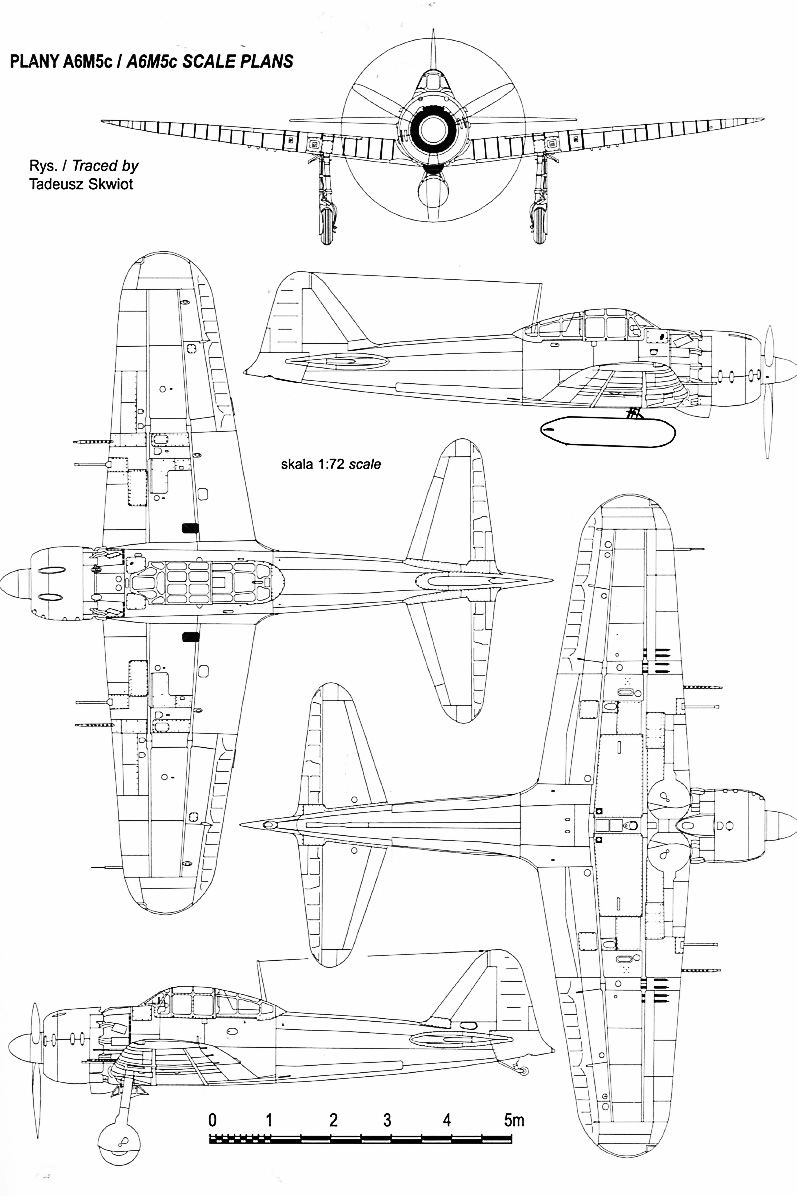
The final production variant of WW2.
-An extra 13.2 mm (.51 in) Type 3 machine gun was added in each wing, outboard of the cannon, with the right reinforcements. The left hood 7.7 mm gun was deleted and not replaced. But this version overamm had three 13 mm and two 20 mm guns, ending as the best armed Zero in service.
-In addition, it was modified to carry four racks underwings, to be used to carry rockets or small bombs, located outboard of the 13 mm wings guns.
-Major change, the engine, a Sakae 31 engine, for increased performances
-For protection, an extra 55 mm (2.2 in) thick piece of armored glass was installed at the headrest.
-Also a 8 mm (0.31 in) thick plate was installed behind the seat. At last the pilot got the protection it deserved.
-The central 300 l (79 US gal) drop tank was changed to a four-post design.
-Wing skin was thickened for better dive performances, with detailed structural improvements.
The first A6M5 made its maiden flight in September 1944, but it was not a good dogfighter and was used at the time mostly as an intercepting to reach B-29s and for “special attacks” (Kamikaze raids).
The ultimate sub-version was a “pure” interceptor, the A6M5-S (A6M5 Yakan Sentōki) and dedicated night fighter. The armament was changed as a single 20 mm Type 99 cannon was installed behind the pilot aiming upward, and inspired by the Luftwaffe’s Schräge Musik installation which prototype and plans were carried by submarines. There was no radar and thus this variant was basically “blind” and only vectored from the ground to a probable location.
There were also experiments of a bakusen, a fighter bomber, with Model 21 and 52 converted with a bomb rack holding a 250 kg (550 lb) bomb, replacing the drop tank. Numbers so converted are unknown.
Also, the Model 52 was converted into the specialized A6M5-K two-seat trainer at the end of the war, in short numbers as advanced trainer by Hitachi, but mass production never started.
A6M6
The A6M6 Type 0 Model 53 was developed to take advantage of the Sakae 31a engine with a newly designed water-methanol engine boost, plus self-sealing wing tanks, something that was expected; Preliminary testings however were disappointing, with not notable increase of power and unreliability of the fuel injection system. Testings went on until it was dedided to cancel this version, amidst priorities. Only a single prototype was produced. This version shows how much the IJN was desperate to see a power increase on its warbird, by all means possible. But the basic structure was simply not to accept larger engines. There was no way around a complete redesign.
A6M7
This brings us to the natural successor of the Zero, the A7M Reppu, developed better below. However engineers at Mitsubishi were not done yet. The A6M7 Type 0 Model 62/63 was at least a rare variant to see service, the very last. It was designed to meet a new Navy requirement for a dedicated attack/dive bomber version operable from smaller aircraft carriers and/or replace the Aichi D3A2 on a lighter package than the Suisei. The A6M7 was completely modified for for dive bombing, with a reinforced vertical stabilizer, special bomb rack underbelly and racks underwings for two 350 litre drop tanks plus bomb swing stopper underside the wings. It received naturally the last engine, the Sakae-31 capable of 1,130hp at take-off. Gun/MG armament was also the same as the A6M5c. The model was capable of carrying a single 500kg bomb. Production started by May 1945 but the need for it radically declined and it was used more in the “special attack” (kamikaz) role, in particular over Okinawa.
A6M8
Basically the same attempt of power improvement as the A6M6 but with a Mitsubishi Kinsei 62 engine capable of 1,163 kW (1,560 hp), making a 60% power increase compared to the A6M2. The cowling and nose were completely redesigned. The carburetor intake was massively enlarged as on the B6N Tenzan with a long duct, exhausts modified, and large spinner similar to the Yokosuka D4Y which shared the same engine. The larger cowling also had the advantage of allowing larger nose MGs, both 13.2mm Type 3 models. Eventually, four 20mm Type99 shiki-2 cannons were fitted in the wings, two paired, with the same ammunition figures of 125 rounds, belt-fed.
To regain range also, this ultimate Zero carried two 150 l (40 US gal) drop tanks underwings. Under the fuselage two new racks were installed, designed to be capable of holding 250 kg (550 lb) bombs. However the most ever powerful zeros never saw service: Only two prototypes were completed in April 1945. Despite an IJN order for 6,300, production never materialized and US troops captured the two prototypes having completed all their tests flights.
Detailed specs
Specs A6M5 (1943) |
|
| Crew: | 1: Pilot |
| Fuselage Lenght | 9.06 m (29 ft 9 in) |
| Wingspan | 12 m (39 ft 4 in)11 m (36 ft 1 in) |
| Wing area | 22.44 m2 (241.5 sq ft), Aspect ratio: 6.4 |
| Airfoil type | Root MAC118/NACA 2315, tip MAC118/NACA 3309 |
| Weight Empty/Gross/Max TO: | 1,680 kg (3,704 lb)/2,796 kg (6,164 lb)/2,796 kg (6,164 lb) for the A6M2 |
| Max takeoff weight: | 1,671 kg (3,684 lb) |
| Propeller: | 3-bladed Sumimoto constant speed metal propeller |
| Engine: | Nakajima Sakae 21 engine 14-cylinder air-cooled radial 1130 hp (see notes) |
| Fuel cap.: | 518 l (137 US gal; 114 imp gal) internal and |
| Top speed: | 600 km/h (370 mph, 320 kn), 533 max, 333 cruise at 4,500 m (14,930 ft) |
| Climb rate: | 15.7 m/s (3,090 ft/min), 6,000 m (20,000 ft) in 7 minutes 27 seconds* A6M2 |
| Wing Loading: | 107.4 kg/m2 (22.0 lb/sq ft)* |
| Endurance: | 1,870 km (1,160 mi, 1,010 nmi)* A6M2 |
| Ferry Range (straight A to B): | 3,102 km (1,927 mi, 1,675 nmi)* |
| Service ceiling: | 9,800 m (32,200 ft) |
| Wing Loading: | 93.8 kg/m2 (19.2 lb/sq ft) |
| Power/mass: | 0.3161 kW/kg (0.1923 hp/lb) |
| Armament | 2× 7.7 mm (0.303 in) hood, 2×20 mm wings guns |
| Other payloads | 1x 330 l (87 US gal; 73 imp gal) drop tank* A6M2 |
The A6M in action

Type 0 A6M2 taking off from IJN Akagi for the Pearl Harbor attack
First engagements over China (1940-41)
As said above, its the flight group Yokohama Kukutai, that cemented the reputation of the aicraft over China, based in Hankow. The kill ratio obtained at the time was simply demential. It was way above that of the F6F later in the war, and was not kept as high due to the degrading quality of the pilots, opposition and context later in WW2. So the overall picture was far less favourable, and after starting on a 12 to 1 kill ratio, from mid-1942 it rapidly started to fall, until reaching by late 1942 and early 1943 something closer to 1:1. By mid-1944 it has been radically inverted to 1:12, and even dug deeper.
The first pre-series A6M2 with the 12th Rengo Kōkūtai started operatuins by July 1940 and on 13 September 1940 had at last their first victories when 13 A6M2s led by Lieutenant Saburo Shindo, escorting a group of G3M “Nell” bombers over Chunking repelled the attack of 34 I-15s and I-16s and claimed 27 of them for no loss. However four Zeroes sustained some damage, and until their retirement in September 1941, they had claimed 99 Chinese aircraft, local conservative figures, and 266 according to Japanese sources. A massive divergence which is quite common at the time and did not help historians today.
By early 1941, the presence of the A6M spiked, well helped by a superior range, many based at Hankow and recently captured airfields to help Japanese forces progessing into the mainland, and from carriers close to the coast, the assigned area of operation of the IJN. But this grow was done at more a limited pace from mid-1941, with the introduction and testing of the A6M3, of which only a few preseries saw action. Air groups were soon back on carriers and back home for extensive training in preparation for future operations. In fact it was even supposed to be withdrawn already in the late summer of 1941 (So late August to early to mid-September). Therefore, in the fall of 1941, all sights of the A6M made by AVG Flying Tigers were actually cases of mistaken identity. However there is the Gerhard Neumann case, a German-born refugee which was part of Chennault’s team. He allegegly reconstituted several downed/forced landed zeros as late September 1942, so a full year after Japanese allegedly retired it from the area;
However, there are missing records for some IJNAF units, which could have led to believe they stayed behind, probably with the earlier A6M2, now superseded on first line service by the A6M3. And there were the Tainan Kokutai Zeros, operating as far as north of Hainan Island. On November 22, 1941, a composite fighter squadron attached to the 22nd Air Flotilla HQ was created to participate in the fall of Singapore, 14 A6M2s model 21 (Tainan Air Group) plus 13 A6M2, same model, from the 3rd Air Group flew via Saigon and Hainan Island to be based at Soc Trang, south of Saigon by December 1941. Two made emergency landings on the Luichow Peninsula. But they were not lost to enemy action from the AVG, only recuperated from scattered part by Neumann. The Chinese AF was indeed the first to have a more precise opinion on the warbird, when an A6M2 the pre-production batch, serial V-110 was recuperated in good general state on the Fainan Island, examined on 18 September 1940 by a mixed US-Chinese team led by Neumann. The crucial intel however was very slow to enter ONI database (The US weren’t at war back then).
The A6M3 and early pacific operations 1941-43
In late 1941 in preparation of the operation against Pearl Harbor, all A6M3s were stationed on carriers and in home island reserve units. Apart a few A6M2s in Indochina as seen above, the Zero was entirely focused on the upcoming pacific theater. On 7 December, from all six fleet carriers of the Kido Butai, some 521 Zeros took part in early operations, including 328 in first-line carrier units. Not all took off that day, only a fraction, as a second wave was prepared, and the remainder were kept for CAP. The Model 21 became the common encounter in these early weeks in December 1941 and January 1942, which staggering range of 2,600 kilometres fooled the US intel and high command. At Pearl, PBY searched in vain for the carrier fleet, which in reality was stationed far more to the north, based on the supposed range of the A6M. The appearing over distant battlefronts of the A6M seemed to indicate they were far more of them than in reality.
These encounters soon created a psychosis in USN and USAAF pilot’s mind, as the previously “pale copy of…” seemed on the contrary invincible. Zeros becalme quickly the bete noire of Pacific pilots, and “zeroes” were seen everywhere, even though these were often “Oscars”. This alleged superiority was not completely well funded, as its early opponents like the Brewster Buffalo on the British side, never were a match to start from. But when the FAA started to introduced the spitfire in this theater of operation, pilots were surprised of the almost supernatural dogfighting abilities of the A6M, comparating quite well with the Me-109. Some even found it superior. By late 1942 when the FW.190 appeared on the western front, both were easily compared. The A6M3 could out-turn the Spitfire with ease and sustain a climb at a very steep angle while having thrice the range.
A lot was learned at Corea Sea in May, at Midway in June, and Guadalcanal from August 1942. Allied pilots soon developed tactics playing their strenght. Avoiding dogfight and instead swoop down from above in a high-speed pass and firing a quick burst, then back up to altitude. The F4F Wildcat applied them with success at Guadalcanal and practiced a type of high-altitude ambush, using the early warning system provided by Coastwatchers and radar. They were deduced from reports in China of those used by Chennault, the “boom-and-zoom” tactics against the equally agile Nakajima Ki-27 “Nate” and Nakajima Ki-43 “Oscar”. AVG pilots used their P-40s strenghts in the same way the F4F.
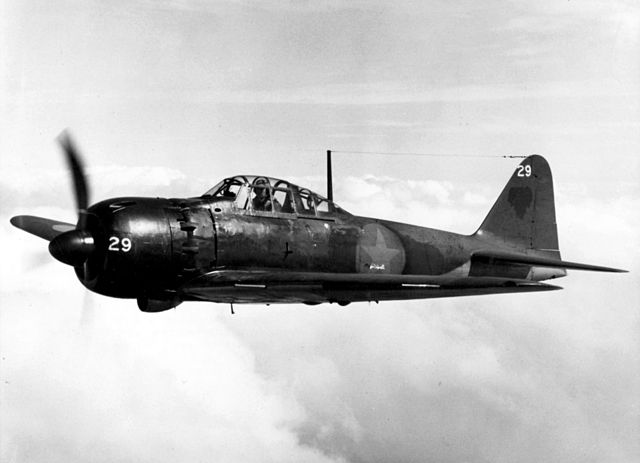
The captured restored A6M5 in flight in 1944. After the Aleutian A6M2, it brought significant improvement to allied intel on the new model, that most pilots found impressive for its low power compared to allied standards.
Lieutenant Commander John S. “Jimmy” Thach, USN ace, also introduced the “Thach Weave”, a formation of F4Fs some 60 m (200 ft) apart. If one was attacked, the remainder two would turn toward each other and surge behind the attacker. If the Japanese pilot then turned to disengaged, it would present its flank by the bait’s wingman. This was the main tactic used at the Battle of Midway and also in the Solomon, until the gradual retirement of the Wildcat. Both Coral Sea and Midway saw a large portion of the best and more experienced IJN pilots lost. Something the Kido Butai never recovered. Already during later engagements like at Santa Cruz and in general over Guadalcanal, pilot experience started to swing to the US side.
Although many officers were critical of the Wildcat, speaking of a “sluggish cat” with too short ammunition storage, Japanese pilots had a somehwat different opinion: Japanese ace Saburō Sakai for example was impressed by the toughness of opponents, as the only brake to the Zero’s total domination:
I had full confidence in my ability to destroy the Grumman and decided to finish off the enemy fighter with only my 7.7 mm machine guns. I turned the 20mm cannon switch to the ‘off’ position, and closed in. For some strange reason, even after I had poured about five or six hundred rounds of ammunition directly into the Grumman, the airplane did not fall, but kept on flying! I thought this very odd—it had never happened before—and closed the distance between the two airplanes until I could almost reach out and touch the Grumman. To my surprise, the Grumman’s rudder and tail were torn to shreds, looking like an old torn piece of rag. With his plane in such condition, no wonder the pilot was unable to continue fighting! A Zero which had taken that many bullets would have been a ball of fire by now.
The A6M4 and late pacific operations 1943-45
The later years, after the arrival of the F6F and F4U in very large quantities and with better, more experienced pilots, the A6M5, despite being the largest production of the type, largely thanks to Nakajima, already overworked with Army fighters and countless others, met it’s demise. Despite all attempts to modernize it, the light initial structure could not be up-engined, up-armed or beefed up much in any ways. Many attemps made until the end of the war led to small experimental series only.
Until the epic Battle of Leyte in October 1945 when the IJN committed its last reserves, the number of fleet carriers dwindled dow gradually, and the great replacement plan of the new armored Taiho class and lighter Unryu class failed to materialize. Post-Midway, the fleet still had the two large Shokaku class, the Jun’yo, Zuiho, Chitose pairs, and a cohort of smaller escort, on which the A6M could still operate, but both Taiho and Shinano had fairly short careers (a single sortie for the latter!), while none of the new and promising Unryu class was really operational in time, most even never completed.
After the catastrophy of Midway, further losses at Santa Cruz and the long attrition campaign of the Solomons (notably the 1st and second battle of Guadalcanal), the Kido Butai was gradually eviscerated. Already outmatched (marginally depending on the pilot) by USN/USMC models, the USAAF also introduced a perfect “zero killer” as the powerfully armed Lockheed P-38 Lightning, which four “light barrel” AN/M2 .50 cal. Browning machine and 20 mm autocannon in the nose could be fatal in a single short burst to the A6M, whicle being able to pick its targets thanks to their speed, and even equalling the A6M in range thanks to their configuration.
The amazing raid to eliminate admiral Isoroku Yamamoto (Operation Vengeance) is a good example of this. 18 P-38G fighter aircraft from the 339th Fighter Squadron arrived on the aerial convoy of 2 G4M1 bombers covered by six A6M3 fighter aircraft, after making a 600 miles out to the target, 400 miles back (1,000-mile total with extra fuel allotted). So after arriving, pilots were already too short of gazoline, to engage in any dogfight and used their speed and surprise to shoot down the two bombers, without engaging the Zeros, and then quickly turn back, loosing one P38G for a single A6M3 damage during the engagement.
The A6M5, still somewhat underarmed compared to the six Brownings 0.5 of the Navy fighters was hard-pressed but it’s main asset remained always in the hands of a skillful pilot as still, it was able to maneuver at least as well any opponents, and being still deadly in competent hands. Many aces of the 1940 era were still alive, although promoted and spared combat as commanders, to form the new generation of 1943, 1944 and 1945 pilots. Shortages of materials also started to impair construction and cause some delays, while quality generally dwindlded down, notably for the engines. While the A7M2 Reppū was awaited all along 1944 and into 1945, the A6M5 went on soldiering until the famous June 1944 “Turkey Shoot” of the Marianas, where the last commander and flying officers with enough experienced were shot down.
By October 1944, the “bait fleet”, Vice Admiral Jisaburō Ozawa’s “Northern Force”, could only sent a limited number of fighters, to lure out Halsey’s TF 38. Ozawa’s tempting decoy actually had only 108 aircraft on the six carriers. The largest par of which were indeed A6M5s. Overwhelmed by several fold more fighters sent by Halsey, in two waves, they were nearly all shot down but a few.
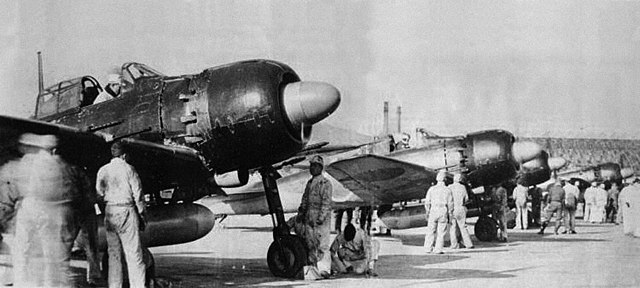
A6M5 Model 52C prepared in Kyushu for a Kamikaze operation over Okinawa.
Afterwards, apart some incursions around iwo Jima and last ditch attacks over the Philippines, the longer Okinawa campaign coincided with the start of Kamikaze operations. In these, the improperly trained pilots of the 1945 wave, were soon mixed with students reciving the most basic training.
These A6M5 were not the best platform for such missions as they carried a small bomb load if any, and the ventral space was used by a droppable fuel tank. In Kamikaze attacks, not all fighters were destined to end as “missiles”. Trained pilots were preferred to escort the composite flights, and defend it against incoming fighters, always detected in advance by radar, until low-altitude flights were attempted by more experienced groups. The A6M5 was seconded in these operation by the fresh (May 1945) A6M7, better provided in bombs, and properly used for Kamikaze attacks, not escort.
The army rivals: “Oscar” and “Frank”
Unlike the Navy, and just as for the previous A5M/Ki-27 duel, the inter-service rivalry prevented the adoption of a Navy fighter. Both branches had similar specifications and Nakajima knew about Mitsubishi’s prototype in development. They choose to adopt the same basic philosophy as the Army asked the company to develop the fighter quicker. Compared to the Zero there were two major differences: It was to be even less rugged (land based fighters were less “tough” than their carrier counterparts) and had less range. Perhaps it’s why development ended sooner, and Nakajima’s prototype flew a month earlier.
In early 1942, unlike the Navy which just upgraded the A6M while a successor was in the works, the Navy decided to create a brand new fighter, the Ki-84 Hayate (“Frank”), which in many was was superior to the A6M5. In fact it was perhaps the very best Japanese fighter of WW2, more powerful and beter protected the Zero could ever dream to be. Its equivalent, the A6M7 “Reppu”, for several reasons, was never ready in time (see later).
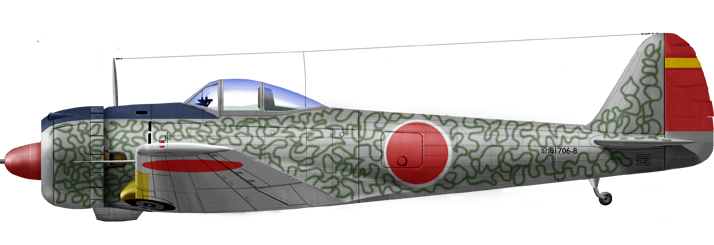
Ki-43-IIb Hayabusa “Oscar” (1st Air Combat Regiment, 1st Company, 1st Squadron, Home Defence 1943)
Compared to the A6M3, it’s contemporary, the Ki-43, which first flew in January 1939, earlier than the A6M, on April 1, 1939. Also it was also lighter, and in comparative tests, out-turned the A6M2/3/5 at low altitude, but was slower at 320 mph versus 330 mph (A6M3) or 351 mph (A6M5) with aslo a slower climb rate. Alsi it’s armament was way too light, with just two 7.7 mm MGs versus the Zero’s two 20 mm (0.787 in) wings cannons. It proved also difficult to uprade with armor and self-sealing tanks without degrading it’s performances, unlike the A6M5.
On the long run, before replacement came with the Ki-84 in 1944, the Ki-84 was out-done by the A6M5 in any corner, even the late Ki-43-III “Ko” (Mark 3a) introduced in December 1944 with the JAAF. It had a slightly improved Sakae engine, individual exhaust stacks for 354 mph at med altitude but the same twin HMGs. The Ki-43 “Otsu” (Mark 3b) had the Mitsubishi Ha-112-II radial engine and two 20 mm (0.79 in) Ho-5 cannon, but the structure could not handle these and the Ki-84 in development looks more promising.
In between the Ki-43 and Ki-84 appeared the Ki-44 Shoki “Tojo”. Nakajima’s engineers in 1940 started developing a new interceptor as a private venture based on the Ki-43 cell, heavily modified, with a new engine. Eventually, a Japanese Army Air Force specification was emitted, calling for a maximum speed of 600 km/h (370 mph) at 4,000 m (13,130 ft), reached in five minutes. The new interceptor featured the in-house Ha-41 14-cylinder double-row radial engine intended for bombers inistially.
As it was larger, the fuselage was strenghtened and enlarged, but otherwise shared many points with the Oscar still. All in all, production was slow, with an average of 50 monthly, peaking at 85 in April 1944 and really starting in February 1942, with many-production models made from August 1940. The 1223 “Tojo” mostly made operated from Japan to intercept bombers, and was the equivalent of the later Navy J2M. It’s development work paved the way for a more agile, less specialized model that became the Ki-84.

Ki-84 Hayate “Frank” (1943) (Author’s illu)
The Hayate was probably the best mass-produced fighter of the IJA (Imperial Japanese Army) in WW2. In performances it was superior to the liquid-cooled powered Kawasaki Ki-61 Hien “Tony” but inferior to the Ki-100, the same re-engineered with a radial, something a bit counterintuitive. The IJAAF Ki-100 by coupling a Mitsubishi Ha-112-II radial to a Ki-61 fuselage in 1945 was marginally better as an interecptor. It was too little, too late however.
The span of service of the Ki-84 and production, more than 3,514 so less than the A6M5 total production, which added to the “Oscar” (5,919) amounted to circa 9,500 so a bit less than the Zero, made it a good-all around package of performances, ruggedness and availability. Engineers had lightened the Ki-43 so much that it was obvious it was severely constrained all-around, to improve the engine, protection or armament. A brand new model was necessary, this time, much strongly built but with also a far more powerful radial engine in order to compensate.
It only flew in April 1943, so well after the A6M5, with a 1 800 ch Nakajima Ha-45-11 Homare (four variants, the last, 21, output’s was 1990 hp) and top speed of about 580 to 630 kph, for a 10,500 m ceiling. Armament was way superior, with two wing 20 mm guns and two 12.7 mm heavy machine guns in the nose. The pilot was protected by an armor plate behind, and extra armor was added to sensitive parts, and there were self-sealing tanks. In short, resilience was much better, and compared favourably to the A6M5 whih still inherited from the A6M2 “flimsiness”.
But since they were less common, allied encounters were rarer and pilot’s impression dificult to assess. After the war, speed tests with captured Ki-84s showed it was comparable to or better than the P-51 Mustang and P-47N. It aldo kept the edge in maneuverability against the P-47, P-38 and Chance Vought F4U Corsair, and some pilots allegedly said given it’s reputation “forget it, it’s a Frank”. Only the lack of experienced pilots prevented its success, as the last produced were squandered with rookies in Kamikaze missions.
Zero Aces
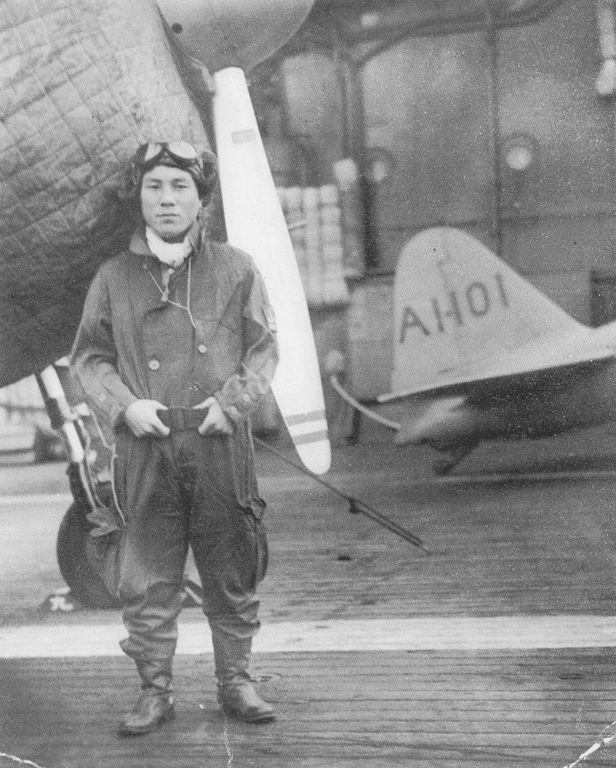
IJN Pilot Abe on IJN Akagi, posing in front of his Zero.
The basic unit called “Kōkūtai” or “air group” (航空隊), specific to Navy air groups. A Kōkūtai could be based on land or aircraft carriers and its dotattion could vary considerably, upt to several hundreds aircraft, like the 343 Kokutai (see later). One famous carrier-based group was the 652nd Kōkūtai. Each of these was subdivided into Hikōtai (“squadron”), three per Kokutai. In the IJA the equivalent was a Sentai.
The Tainan Kōkūtai based in Formosa inb 1944-45 became the most famous group, a nest of aces. This group operated from Rabaul in New Britain and started its rampage in the Philippines by early 1942, the Dutch East Indies, New Guinea and and mainland Japan towards of the end of the war. Saburō Sakai was one of its leading aces. The IJN Air Service organized an “all aces” elite unit, the 343 Kōkūtai, equipped not with the A6M5 in late 1944, but with Kawanishi N1K2-J fighters under orders of the famous Minoru Genda. This one of the rare “veteran” true fighter units among many Kokutai which basically were spent in Kamikaze missions.
Other veteran pilots flew also with the 601st Naval Air Group (225 aircraft of all type, nominal strenght), which operated with the 3rd Fleet (15 February 1944–9 July 1944), the 1st Carrier Division or Kido Butai (10 July 1944–9 February 1945) and the 3rd Air Fleet (10 February 1945–postwar). In it were operating the 161st, 162nd, 308th, 310th, and 402nd Fighter Sentai. They notably operated from IJN Taihō, Zuikaku and Shōkaku (symbols 311/11, 312/12 and 313/13), taking part in the Battle of the Philippine Sea, the Battle of Iwo Jima, Battle of Okinawa and the defence of Japan, flying the A6M5 and N1K1 in 1945.
- Tetsuzō Iwamoto: 94 (14 in China and personal claims 202 kills)
- Shoichi Sugita: 70 (some sources: 80)
- Saburō Sakai: 64 (2 in China)
- Takeo Okumura: 54 (4 in China)
- Hiroyoshi Nishizawa: 36 official (102 claimed)
- Toshio Ohta: 34
- Kazuo Sugino: 32
- Junichi Sasai: 27
- Sito Origami: 10 (9 in China, 1 disputed)
- Toshiyuki Sueda: 9
- Kunio Iwashita: 9
- Master Sergeant Kawai: 4
- Master Sergeant Maruyama: 4
- Captain-Petty Officer Takeo Tanimizu: 8 (A6M5c)
*Note: Many of these pilots transitioned from the A5M (China) to the A6M, and a selected few survivors piloted the N1K1 in 1945.
Flying the A6M-2N “Rufe”
In Home defence
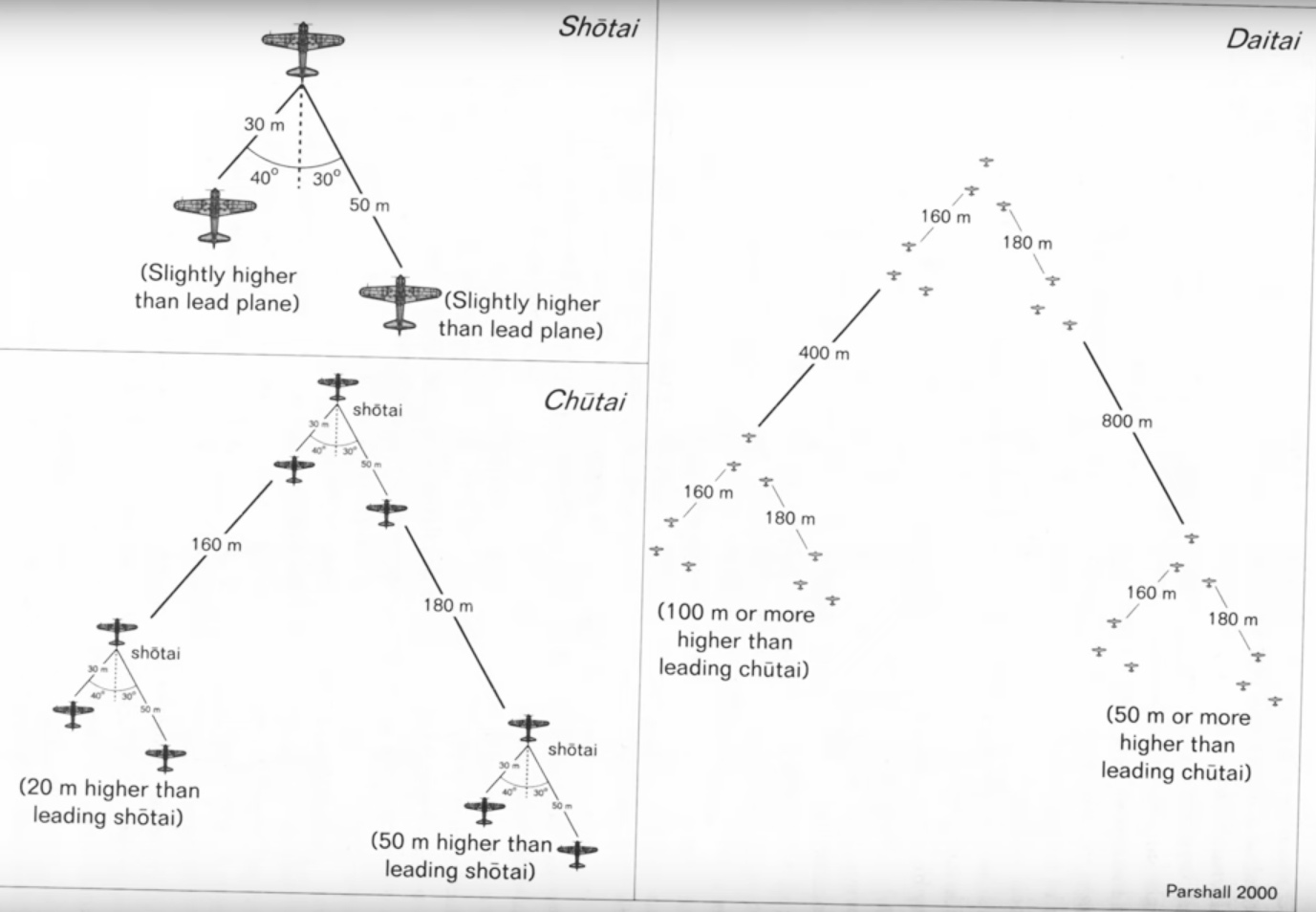
Revised IJN fighter attack formations in 1942
Zero Adversaries
The A6M2 clearly dominated the sky when pitted against Chinese Polikarpov 1-15 biplanes and 1-16 monoplanes, but from late 1941, the RAF Buffalos, USAAF P-36 Mohawks. Due to its low wing loading it could out-turn any of them in all dogfights and just dominated any encounter. Some equality was found when encountering the P40B Tomahawk and Hawker Hurricane, but only pilots made the difference, using their best assets and using hit and run tactics. Chennault used to dive into Japanese formations to take on a few aircraft before running out of range or in clouds.
The Zero started to find even better opponents in the P-38 Lightning and even the stubby F4F Wildcat. P-38 pilots selected their moment of fight, based on their superior speed, notably better altitude, ready to pounce for an eye blink killing blow thanks to their armament. The F4F was more agile, and could, if well used, even outperform the Zero in some corners, but mostly taking punishment and escape.
The third generation of American fighters mounted the F6F and F4U and they dominated dogfight by sheer power, speed and strength. Both F4U and F6F, even with relatively inexperienced pilots, could take on the Zero with confidence in any conditions, and this was coupled with overwhelming numerical superiority. The last Zeros fought off B29s escorted P51 Mustangs over the home islands, and between the fierce self-defence and high altitude, speed offered by the first and the intrinsict qualities of the second, equally at home at this altitude, A6M5 were no longer a match.
Zero vs. Chinese I-153 & I-16
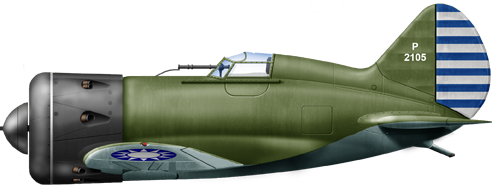
I-16 Type 5 of a Chinese ace, 1940. Author’s illustration
The bulk of the Nationalist Air Force in 1937-39 was equipped with the I-153 biplane and I-16 monoplane. The latter was still enountered well into 1943 and so reports of duels between these and the A6M2 are known. The small Polikarpov I-16 “Ishak” (Donkey) was the beloved, main first line fighter of the Soviet Union of 1941 despite its age.
At Nomonanh in 1939, the adversaries of the Soviet Air force were IJAAF models, so likely the Ki-27 “Nate” in majority as the Ki-43 was just getting started. The Navy could however had seen some combat in China over Mandchuria in 1945 during the Soviet invasion of August, as it had the responsability of coastal areas. But at the time, these units probably flew second-line, worn-out A6M2, and combat reports of combat are scarce. By that time, the Soviet AF flew the Mig-7 and Yak-9, which were infinitely superior, with veteran pilots.
Zero vs. US P40E Tomahawk

Famous P40E of Chennault’s “flying tigers” in 1941. Author’s illustration
The P40 was derived from the P36 Hawk, a 1935 (first flight) modern all-metal, enclosed cockpit, with rectracting undercarriage and stressed aliminium skin fuselage and wings model. It equipped USAAF units in 1939 and still largely in 1941 while being replaced by the P40. The Zero would deal with the P36 in China already. On 11 January 1939, five Hawk 75Ms of veteran CAF 25th Fighter Squadron Cdr. Liu Yijun defended Chongqing, proving superior to the I-15 and I-16 and eventually the 75A-5 was built under license in China until moved to India (RAF Mohawk IV). For top speed and agility it was easily dominated by the A6M2.
Curtiss improved massively over the design by just fitting on the prototype XP-37 an Allison V-1710 inline engine with cockpit moved further to the rear of the fuselage. The final product, called YP-37 (13 built) and then XP-40 with the Allison V-1710 became the prototype of the Curtiss P-40 Warhawk. The latter first flew on 14 October 1938 and started to replace the P36 in USAAF units in 1939 and until December 1941, became the main USAAF fighter. Its top speed of 538 km/h (334 mph/290 kn) at 15,000 ft (4,600 m) was on par to the A6M2’s 533 km/h (331 mph, 288 kn) at 4,550 m (14,930 ft), but it never was as agile.
Still, the P40E Tomahawk flew by Claire Chennault’s squadron for the Chinese Nationalist Air Force met the A5M and A6M and was among the first to clearly report and warn the USAAF about the performances and agility of the new fighter. He also learned how to best deal with it, avoiding dogfights and devising adapted tactics, a precious set of advice that was officialized after the capture of a Zero and extensive tests. A bit like the Wildcat, the P40 could still count in its superior construction to survive battle damage. The few that were still around in late 1942 when the A6M5 appeared were hopelessely outmatched.
Zero vs. P38 Lighting

P-38F of USAF top ace Richard Bong in 1944 – Author’s illustration
The incontestable winning point of the P-38 design was its superchargers, worked on for years at NACA -predecessor of NASA- which enabled superior performances to anything else that flew at the time, thanks to the light fuselage and peculiar twin-boom design combined to two very powerful inline engines, a pair of Allison V-1710 V-12 liquid-cooled turbo-supercharged piston engine rated for 1,600 hp (1,200 kW) each, enough for 666 km/h (414 mph/360 kn) based on 1,425 hp.
At high altitude, reaching 44,000 ft (13,000 m) the superchargers gave it superior performances, well completed by a combat range of 2,100 km (1,300 mi, 1,100 nmi) versus 1,870 km (1,160 mi, 1,010 nmi) for the A6M2. It was still faster at all altitude ranges than the A6M5 and could escape easily in dives, reaching in rare cases 800+ kph but dealing with extreme air compressibility issues, notably strong vibrations.
For agility however, it was noted as inferior to the A6M5 and only the pilot’s respective skills generated a more balanced result. A twin-boom plane generally had more drag than a monocoque, single fuselage model. However the model generated plenty of aces, like Richard Bong (40) or Thomas McGuire (38), top aces of the USAAF, which preferred it over the M51 Mustang. Like the Navy pilots they were perfectly briefed over the advantages and weaknesses of the A6M and they had in the nose the most powerful armament of any US “light” fighter in this war, one Hispano M2(C) 20 mm cannon and four M2 Browning machine guns in the nose. One or two 20 mm HE rounds could tear apart a zero while the P38 presented almost the same ruggedness as the Corsair and Hellcat.
Zero vs. Grumman F4F Wildcat
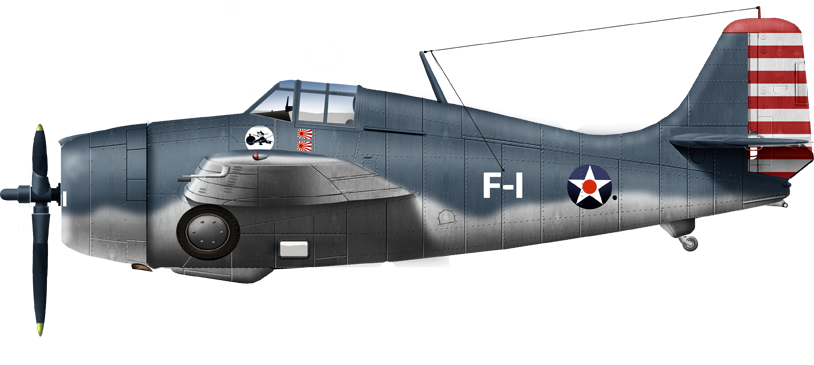
F4F-3 of ace J.S. Thach from VF3 “Felix” in 1942.
The big difference between the two was that the Grumman F4F Wildcat was designed based on awaited specifications from the Navy, for a modern monoplane, and the company used the biplane F3F as a base. When the specs arrived some adjustments were made and it entered service as such. It’s not before encounters were made at the battle of Wake on December 8 and later on the 23th for the surviving fighters, that the F4F had a glimpse about its main adversary for the upcoming two years (and more). Indeed, even after its replacement by the Hellcat, the valiant F4F was small enough to fit on escort aicraft carriers, and most of them (of the Casablanca class) were tasked to defend amphibious fleets in all operations. Therefore, the F4F went on to fight not only the Zero until 1945 but even other late models.
Many aces were made on the F4F and pilots soon devised the best tactics to stay alive when encountering the Japanese warbird. They could not count on defeating it at its own game -in a barrel loop and tight turns-, and instead, try to hide in the clouds if the engagement started badly, or more commonly dive, or just count on their own resilience and ability to still manoeuver at extreme speeds. Many tactics based on this were devised, and it took about a year before they started to be told to young recruits until late 1942. One of the best was always the dive: The Wildcat could dive at 400+ mph while the Zero’s controls began stiffened at 250 mph and were unmovable at 350 mph, beyond that, its structure was just not strong enough to risked grave damage. Marc Liebman, Captain USN (ret) in particular gathered all reports on these encounters and deduced this and other advantages Wilcat’s pilots could count on. This particular tactic allowed the F4F to choose to leave behind its follower and return later or out-turn the A6M at the first occasion.
Among these, the Wildcat could also take on hard G manouvers the Zero cannot follow, since the latter still has a traditional float type carburetor. The engine will just starve out trying to catch the Wildcat in those. At a macro level also, most Zeros did not have radios and could not coordinate properly their attacks or defense. Also if the Wilcat could manage to stay alive when fired at, the Zero was limited to 10 seconds of ammunition for its 20mm cannons, and next its machine guns were virtually useless against the F4F, which could absorb enormous punishment. The F4F could never be underestimated. It was not “easy meat”, even mith moderately trained pilots. There is a reason why it was maintained so long both in the FAA and USN.
Zero vs. Grumman F6F Hellcat

F6F-3 of ace Alex Vraciu from CV-16 USS Lexington summer 1944.
Unlike the F4F which was designed in the complete ignorance of the A6M, the F6F was created with it in mind, specifically, taking in account as many pilot experience as possible. All the strong points of the Wildcats were just pushed forward. With more power, more sturdiness, a better armament, the “orgre” that was the Hellcat when it arrived in 1943 started to completely dominate the A6M3. However, it started from a long way away. The previous F4F compared by a young pilot of that time as “a little beer bottle of a plane with a battery of .50-caliber guns in its tiny wings.”. Despite a more powerful, 1,200 horsepower engine, its speed was limited to 318 mph, compared to 331 mph on the A6M and tactically a range of 770 miles compared to 1,950. Engineers at Grumman were confident to radically improve on both points, but especially on the first.
The process started in 1938 already when the F4F was not even in service, engineers worked on a new version redesigned around the massive Wright 14-cylinder, 2,600 horsepower in development. But t’s really when a zero crashed almost intact in the Aleutians that Grumman’s engineers had a clearer picture of what they had to beat. But they persisted on their design, with some adjustments. But the luck of diverging schedules, Grumman had its hands on the even more impressive Pratt & Whitney 2000 hp R-2800 Double Wasp, which formed the beating heart of the new warbird.
As a result, at 380 mph the F6F outpaced the Zero at optimum altitude, had a better, 37,000-foot service ceiling and above 10,000 feet climbed as quickly, while being even more faster in a dive. For range they still performed at 400 miles from their carriers of needed. And when it came in 1943, the pool of experienced pilots in the IJN had been already reduced significantly by the F4F. F6F pilots were essentialy now fightng a downhill battle. Event the A6M5 could not regained the advantage. Both were now geavenly matched and IJN pilots had in turn to learn how to to beat the F6F and avoid its strenght, looking for close dogfights and counting on surprise.
But the amazing ruggedness of the F6F, based on raw power, was always very efficient. In February 1944 for example during an attack on Truk, Lt. Eugene A. Valencia escaped attacking Zeros, was hit, but then turned back hard to make a surprising (for them) head-on run, guns blazing, managing to shoot down three A6M5s straight away. In June 1944, the “great Mariannas Turkey Shoot” was not longer an even affair between worn-out zeros and inexperienced pilots. It just turned ugly for the Japanese, earning for the F6F it’s record kill ratio, confirmed time and again until the end of the war.
Indeed its qualities as “kamikaze killer” was also considerable: Over Okinawa on April 17, 1945, four Hellcats from USS Yorktown (ii) detected an enemy formation of some 40 light bombers and zeros from 25,000 feet, and a limited two-airplane Hellcat section dove and attacked, the other section covering them, and they then reversed course. This particular maneuver broke the kamikaze formation with 17 confirmed kills in a matter of minutes. This tactic became a favorite and mowed down these formations, leaving only scraps to hit the steel wall of the task force’s AA.
Zero vs. Chance-Vought F4U Corsair
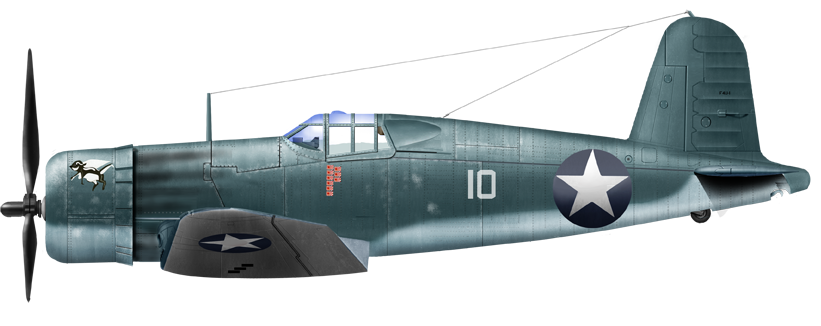
F4U-1 “Gus Gopher” (Wilbur “Gus” Thomas) VMF-213, Guadalcanal 1943
The prototype XF4U-1 flew at the time the A6M barely reached production. It would become from 1943 one of its fiercest adversary from its introduction in December 1942.
After the F6F, the F4U was the other “Butcher bird” of the USN, or to be more accurate at first, of the USMC. The “whistling death” from Chance-Vought was making its maiden flight two years before the F6F Prototype. However soon it appeared plagued by two issues that prevented adoption as a main carrier-based model, plus teething issues that delayed its entry into service, and the F6F was chosen instead by December 1942: Lack of visibility from the nose, crucial when landing as the flying deck was hidden from view, and linked to the first, its innate propensity to “bounce off” the deck, missing all arrestors cables. Since the USN was hiring plethora of new young pilots to populate its numerous air groups stationed on the Essex-class fleet carriers by in late 1942, they wanted an easier models, so the F4U was ruled out and passed onto the USMC, quite eager to replace its antiquated models. It’s ruggedness made it perfect to land on summarily prepared airfields, and visibility was no longer an issue.
In the hands of the Marines, spread over many airfields in the central Pacific, the gullwing terror was able to regain supremacy over the Imperial Japanese Army Air Force, as did the F6F from the Task Forces. In addition to the USMC, the Fleet Air Arm also inherited this model, which was found largely superior in many ways to the seafires and sea hurricanes still populating British carriers in 1943. With a new optical guiding system, the visibility problem when landing was overcome, and it also helped in fine to solve the “deck bouncing” issue, now far more precise. So much so that in late 1944, the F4U made a comeback on USN fleet carriers and doubled the F6F as a fighter bomber, it’s specialty. F6F and F4U were hand in hand pummeling the home islands in 1945.
Now compared to the Zero, the main advantage of the F4U was its superior speed. The first version was faster than the A6M3, and subsequent versions stayed aloways superior in this regard to the A6M5 or Type 0 model 52. The other advantage was of course its raw power, far superior to the A6M, with the last version F4U-4 had a modified dual-stage-supercharged 18W engine, which when injected with a water/alcohol mixture reached 2,450 hp (1,830 kW). It was almost double of the A6M5 at the time. As the F6F, the structure of the F4U was extremely rugged and it proved quite resilient in combat, being capable of absorbing extra punishment the A6M5 could not.
In the first wave alone of the “Great Mariana turkey shoot”, 42 out of 60 Japanese planes (most being zeros) were shot down for two F6F and a single F4U conceded in return. Like F6F pilots, still, they learned hown not to dogfight the A6M5 and instead, use their armor and speed to blow them apart in high speed passes instead, denying them a close range in equal terms. In 1945 USN stats would give a 11:1 kill ratio in favor of the Corsair versus identified A6M Zero in combat. Although the radical decrease in pilot quality should be taken in account, it was still compensated by a better model overall compared to the A6M2 or A6M3. That left still some margin of superiority to the F4U. USMC pilots meanwhile, were more used to combat land planes, especially the Ki-43 “Oscar” and Ki-84 “Frank” at the end of the war, but still encountered second line A6M2 and A6M3.
Zero vs. P51 Mustang

North American P51D F6D Mustang “The Flying Undertaker”, Ace Major William Shomo (6 victories), Tinian AB, spring 1945.
This fantastic fighter was designed in just 120 days as the prototype NA-73X flew on October 25, 1940. The initial goal was to create an assault plane powered by an Allison engine, not a fighter, and the early NA-73s and NA-83 were only ordered on paper by the British RAF. It took until 1943 before the idea emerged to escort bombers with long-range fighters, and the mediocre initial assault plane was remotorized by the Rolls-Royce Merlin (a match made in heaven), licence-produced by Packard. Some 15,000 airframes were created between Los Angeles and Dallas plants. With its pressurized cockpit and its trademark design innovations, like the “laminar flow”, bubble canopy, landing gear, mass production simplifications, conical lofting, and general good looks, courtesy of “Ed” Schmued, the “best USAAF ww2 fighter” also generated scores of aces.
Those were only encountered by rare A6M5 over the Home Island, after the capture of Iwo Jima and conversion into a massive air base. The latter operated scores of the massive B-29 superfortress, and for escort, their P-51 Mustangs. These highly dangerous missions lasted for seven hours, at the limit of range, with 3 hours flying over the open Pacific, one over their objective with fierce dogfights and 3h for the return to Iwo Jima. Losses over the open sea were frequent due to possible mechanical breakdowns or damaged planes over Japan due to AA, and pilots picked-up at sea always ended POWs with marginally greater chance of survival in 1945 compared to their earlier USN counterparts.

P51 taking off from Iwo Jima airbase, May 1945.
When air opposition dropped radically the USN started to used its F6F and F4U for ground attacks, and so was the P51. Starting in July 1945, 51 raids by the VII Fighter Command claimed to have destroyed or damaged 1,062 aircraft and 254 ships. Many A6M5 (produced until the last days of the war) were simply destroyed on the ground.
Never ready successor: A6M7 Reppu “Sam” (1944)
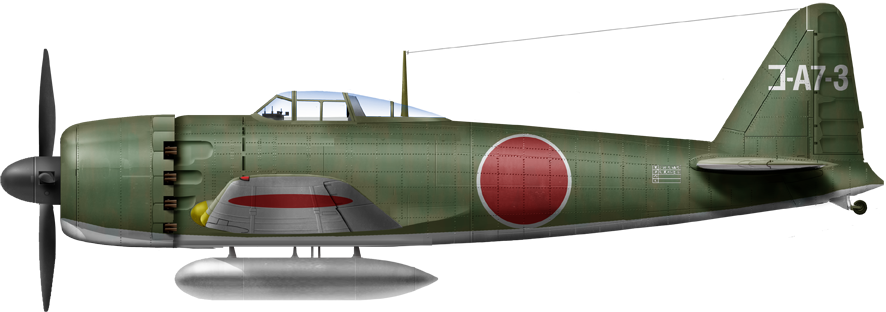
Profile rendition of one of the prototypes
The A7M Reppu (“Strong Gale”) was planned as the successor to the A6M, since the basic frame of the A6M5 could be furrther upgraded and updated without completely redesigning it. The Navy was influenced in large part by the development of the Army’s Ki-84, and design work began in April 1942, at a time the Kido Butai was still intact (the battle of Coral Sea did not happened yet).
Mitsubishi’s chief engineer, the very same Jiro Horikoshi and his team, worked aoround the clock to the new prototype, and by July 1942, the Japanese Navy at last backed this officialy up with specific requests, redesignated the “Navy Experimental 17-shi Ko Type Carrier Fighter”. Top speed as requested was now to be 639 kph with a ceiling of 6,000 meters and a climb rate of that altitude in 6 minutes. For armament, it needed to have two 20-millimeter cannons plus two 13 mm HMGs while keeping the same maneuverability as the A6M3.
Horikoshi’s team soon found the engine suitable for the right performances but at that time instead of concentrating on it, Mitsbushi was completely absorbed into the construction of the G4M bomber and A6M fighters already, so the prototype was delayed quite significantly. So much so that unlike the Ki-84, the first A6M7 prototype flew on 6 May 1944. Right away, the promising engine did not delivered as expected: It was found to be underpowered.

War emergency was such that the Navy ordered Mitsubishi to stop development of the A7M, with a permission to continue, while not using resources to develop new engines. A7M development went on using the existing Ha-43 engine and basically the engineers were back at work trying to lighten the structure enough to regain performances. The first prototype with the Ha-43 engine flew on 13 Oct 1944 and managed to reach 628 kph (below the requested speed, but accepted due to the new engine), however its handling was even better than the A6M5.
However fate intervened again: An earthquake in the Nagoya region, added to the scarcity of resources caused by the Allied naval blockade further delayed production of the preserie, of which only eight aircraft were ready by the next summer of 1945, meaning none was deployed in any active unit. The few flying ones made test flights when avgas was available, but the A7M fighters would never see action and the remainder in construction or completion at various stages were captured at Nagoya by the occupation troops.
Of note it should be said that Mitsubishi was not “stuck” with the A6M. In 20 March 1942 first flew the prototype, and from December was delivered to the Navy a new non-carrier based fighter: The J2M Raider “Jack”. Thus rather disgracious and stubby fighter was entirely developed from precise specifications for a home defence fighter provided by a much more powerful engine, not compatible with the flimsier A6M5: The 1,044 kW (1,400 hp) Mitsubishi MK4C Kasei 13 14-cylinder air-cooled radial engine (prototypes) up to the Kasei 26a engine (3-speed supercharger for 1,820 horsepower (1,360 kW)) for high altitude. On the larger scope, these changed very little: Only 621 were produced, devoted to B-29 interception until the last day of the war. It was never intended as a carrier fighter, having no hook or reinforced undercarriage.
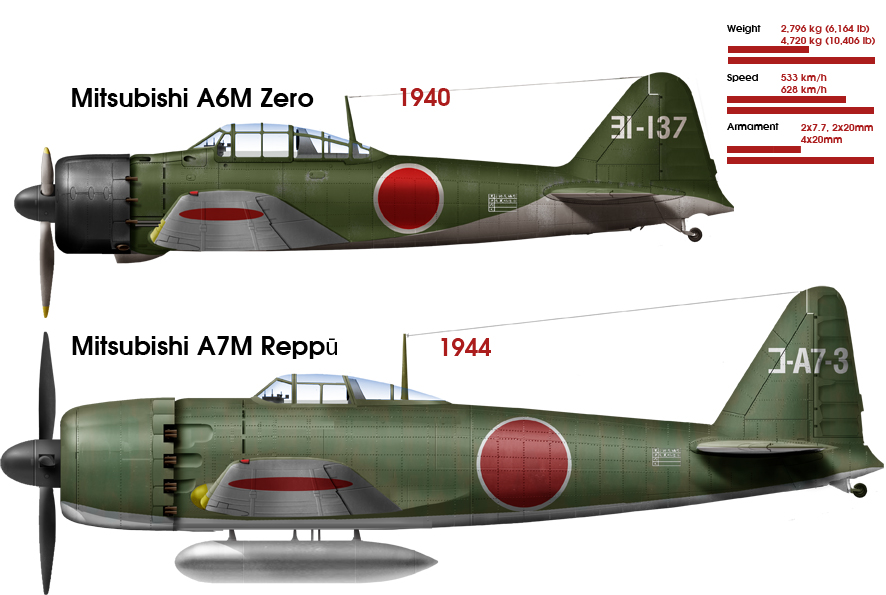
Comparison between the A6M and A7M
The navy also had another high performance fighter, from Kawanishi: Unique case in aviation history, it came from a floatplane interceptor, the excellent N1K Kyōfū “Rex” developed from May 1942 and introduced in late 1943 to replace the Nakajima A6M2-N “rufe”. It was developed into a land-based interceptor, the N1K-J Shiden “George”, the first J-1 flying in December 1942 and the first J-2 in December 1943. In all, 1,532 combined were delivered, a far cry to the 10,000+ of the A6M, but the very last N1K5-J Shiden KAI 5 powered by the HA-43 (MK9A) 2,200 takeoff hp (project only) was certainly very promising.
Preserved Zeros today
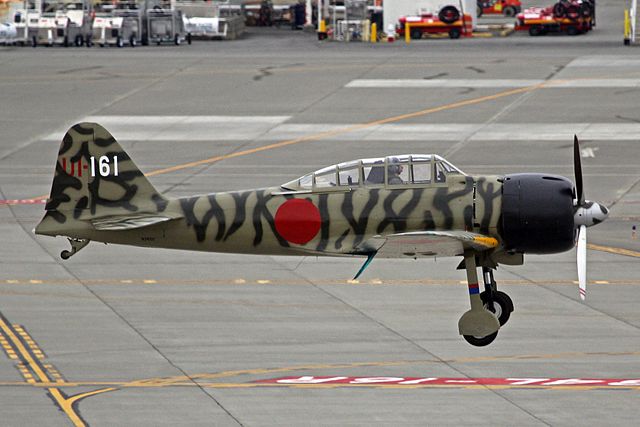
A6M3 at the Flying Heritage Coll.
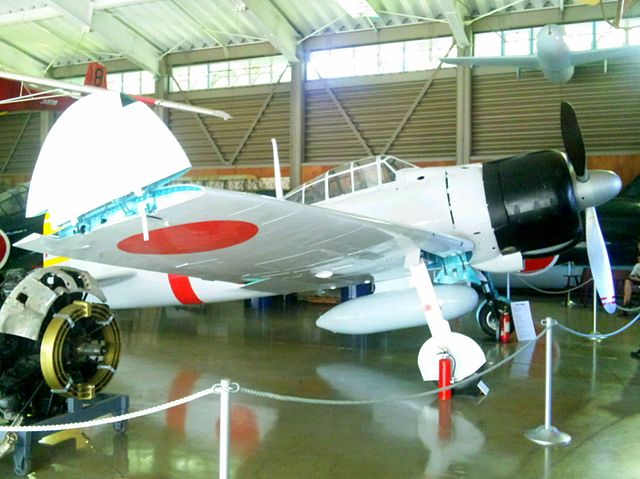
A6M2 M21 at the Kawaguchiko Motor Museum, Yamanashi prefecture
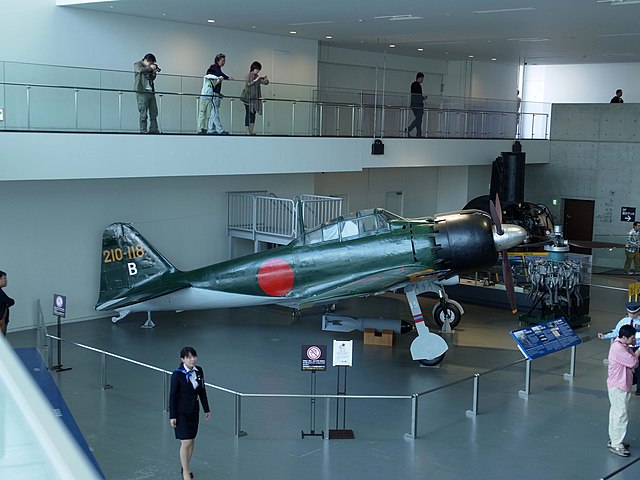
Mitsubishi A6M Zero yamato-museum
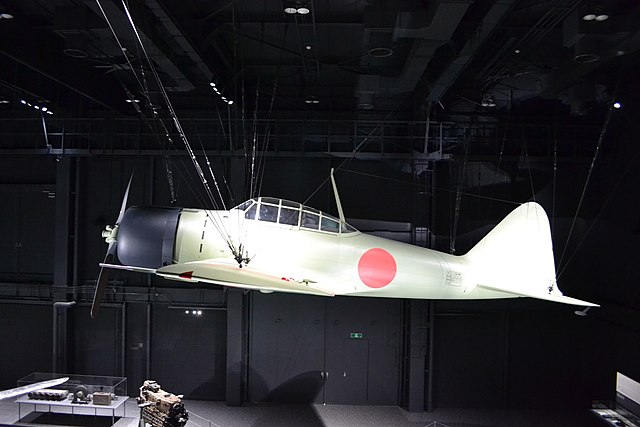
A6M1 prototype at Junishikansen (Mock-up Replica, full size)
Many A6M5s were captured in various stage of completion when the home island were occupied. Most of these would make the bulk of preserved aircraft arond the world today. Most surviving Zeros for this reason are either A6M5, or are made up of parts from multiple airframes recuperated and restored over the years, procuring a bit more diversity in types and models. They are however referred to by conflicting manufacturer serial numbers. Some were picked-up in utterly wrecked condition, and have been reconstructed and restored by recreating the missing modern parts, to the point they only had few original ones. Most of the flying ones no longer have their original engines, replaced with similar American units. The “Planes of Fame Museum’s” A6M5 is the only one with its Sakae engine.
Flyable Zeros (outside reconstritutions based on the North American T-6 Texans with modified fuselages used in movies and series) are a few (3), but static ones could be found in Australia (2), China (1), Germany (1, replica), Indonesia (1), Japan (10), New Zealand (1), UK (2), and the US (15, including replicas and in storage, prending restoration).
References
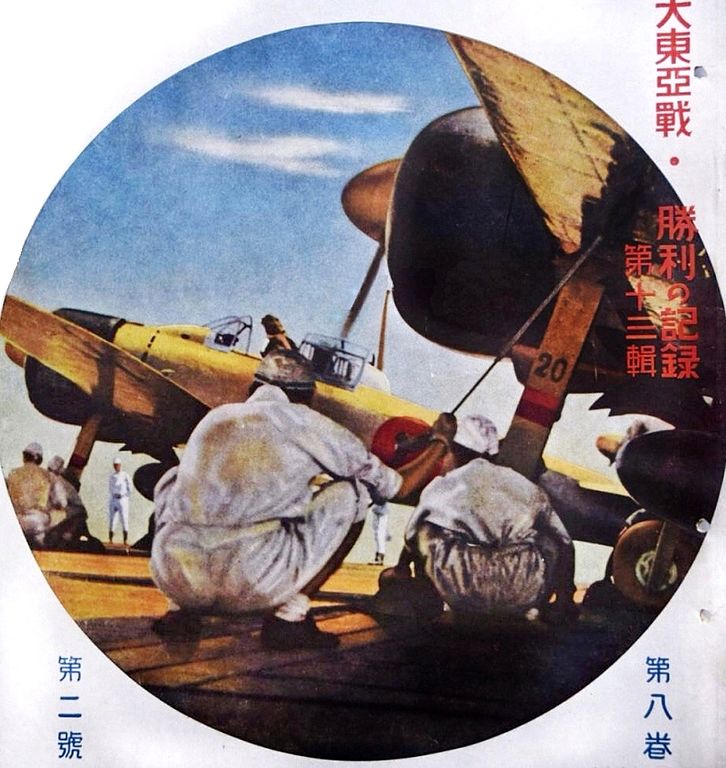
Books
Angelucci, Enzo and Peter M. Bowers. The American Fighter. Haynes Publishing, 1987.
Fernandez, Ronald. Excess Profits: The Rise of United Technologies. Addison-Wesley, 1983.
Ford, Douglas. “The USAAF Intel on Japanese Fighter Tactics in the Pacific Theatre, 1941–5,” International History Review 34
Francillon, R.J. Japanese Aircraft of the Pacific War. Putnam, 1970
Glancey, Jonathan. Spitfire: The Illustrated Biography. Atlantic Books, 2006.
Green, William and Gordon Swanborough. The Great Book of Fighters. MBI Publishing, 2001.
Gunston, Bill. Aircraft of World War 2. Octopus Books Limited, 1980.
Holmes, Tony, ed. Dogfight, The Greatest Air Duels of World War II. Osprey Publishing 2011
Huggins, Mark “Hunters over Tokyo: The JNAF’s Air Defence of Japan 1944–1945”. Air Enthusiast
Jablonski, Edward. Airwar. New York: Doubleday & Co., 1979.
James, Derek N. Gloster Aircraft since 1917. Putnam and Co Ltd., 1987.
Lundstrom, John B. The First Team and the Guadalcanal Campaign. Annapolis, Maryland: NIP
Matricardi, Paolo. Aerei Militari. Caccia e Ricognitori (in Italian). Mondadori Electa 2006.
Mikesh, Robert C. Warbird History: Zero, Combat & Development History, A6M Zero. Motorbooks International 1994
Mikesh, Robert C. Zero Fighter. Crown Publishers Inc., 1981 Zokeisha Publications
Okumiya, Masatake and Jiro Horikoshi, with Martin Caidin. Zero! E.P. Dutton & Co. 1956.
Nijboer, Donald. Seafire Vs A6M Zero: Pacific Theatre. Osprey Publishing 2009.
Nohara, Shigeru. Aero Detail 7: Mitsubishi A6M Zero Fighter. Tokyo: Dai-Nippon Kaiga Co. Ltd 1993
Parshall, Jonathan and Anthony Tully. Shattered Sword: The Untold Story of the Battle of Midway. Potomac Books
“Plane Facts: Zero-sen ancestry”. Air International, October 1973, Vol 3 No 4.
Smith, Peter C.Mitsubishi Zero: Japan’s Legendary Fighter. Pen & Sword Books 2015.
Soumille, Jean-Claude (September 1999). “Les avions japonais aux couleurs françaises”
Spick, Mike. Allied Fighter Aces of World War II. Greenhill Books 1997.
Stille, Mark. Guadalcanal 1942–43: Japan’s bid to knock out Henderson Field and the Cactus Air Force (Air Campaign). Osprey 2019.
Thompson, J. Steve with Peter C. Smith. Air Combat Manoeuvres. Ian Allan Publishing 2008.
Thruelsen, Richard. The Grumman Story. Praeger Press, 1976.
Tillman, Barrett. Hellcat: The F6F in World War II. NIP 1979.
United States Strategic Bombing Survey Aircraft Division. Mitsubishi Heavy Industries, Ltd. Corporation Report I, Washington, D.C. 1947.
Wilcox, Richard. “The Zero: The first famed Japanese fighter captured intact reveals its secrets to U.S. Navy aerial experts”. Life, 4 November 1942.
Willmott, H.P. Zero A6M. London: Bison Books, 1980.
Yoshimura, Akira, translated by Retsu Kaiho and Michael Gregson. Zero Fighter.Praeger Publishers 1996.
Young, Edward M. F4F Wildcat vs A6M Zero-sen. Oxford, UK: Osprey, 2013.
Bueschel, Richard M. Mitsubishi A6M1/2/-2N Zero-Sen in Imperial Japanese Naval Air Service. Canterbury, Kent, UK: Osprey
Francillon, René J. The Mitsubishi A6M2 Zero-Sen (Aircraft in Profile number 129). Profile Publications Ltd. 1966.
Francillon, René J. The Mitsubishi A6M3 Zero-Sen (“Hamp”) (Aircraft in Profile number 190). Profile Publications Ltd., 1967.
Jackson, Robert. Combat Legend: Mitsubishi Zero. Airlife Publishing, 2003.
Juszczak, Artur. Mitsubishi A6M Zero. Tarnobrzeg, Poland/Redbourn, Mushroom Model Publications 2001.
Kinzey, Bert. Attack on Pearl Harbor: Japan awakens a Sleeping Giant. Military Aviation Archives, 2010.
Marchand, Patrick and Junko Takamori. (Illustrator). A6M Zero (Les Ailes de Gloire 2) Editions d’Along, 2000.
Mikesh, Robert C. and Rikyu Watanabe (Illustrator). Zero Fighter. Jane’s Publishing Company Ltd. 1981.
Nohara, Shigeru. A6M Zero in Action (Aircraft #59). Squadron/Signal Publications, Inc., 1983
Nohara, Shigeru. Mitsubishi A6M Zero Fighter (Aero Detail 7) Dai Nippon Kaiga 1993.
Okumiya, Masatake and Jiro Horikoshi: Zero! The Story of Japan’s Air War in the Pacific Ballantine Books 1956
“Plane Facts: Zero-sen ancestry”. Air International, Vol. 3, No. 4, October 1973
Richards, M.C. and Donald S. Smith. Mitsubishi A6M5 to A6M8 ‘Zero-Sen’. Profile Publications 1972.
Sakaida, Henry. Imperial Japanese Navy Aces, 1937–45. Osprey Publishing Ltd. 1998.
Sakaida, Henry. The Siege of Rabaul. Phalanx Publishing, 1996.
Sheftall, M.G. Blossoms in the Wind: Human Legacies of the Kamikaze. NAL Caliber 2005
Wilson, Stewart. Zero, Hurricane & P-38, The Story of Three Classic Fighters of WW2. Aerospace Publications 1996.
Sakaida, Henry “Imperial Japanese Navy Aces 1937-45” Osprey 1998
Caidin, Martin Stag October 1961, pp. 36, 38-9, 70-3
Inoguchi Rikihei, Tadashi Nakajima, Roger Pineau 1958. The Divine Wind: Japan’s Kamikaze Force. NIP
Acheson, Denis Axis Fighters (Plymouth Press 1982)
Hata, Ikuhiko IJN Fighter Units and Their Aces, 1932-1945, Casemate Publishers 2011.
Links
On airwar.ru
On warbirdforum.com
jstor.org dealing with the Zero, John F. O’Connell Air Power History Vol. 63, No. 3
aviatia.net/f4u-vs-zero
On weaponsandwarfare.com
ONI plates on the zeke 52
ONI handbook IJN A6M
alchetron.com
Cat against the sun – airforcemag.com
Speaker Briefing: F4F vs A6M Setting the Record Straight, Marc Liebman, USN
Same, more detailed
On Peter Lewis’ site 1985-1999
wiki commons, cc photos
wiki
Videos
Hellcat vs Zero, by two vet pilots.
A6M Zero – Japan’s Mystery Machine. Armoured carriers channel
Pacific Legends Day – F6F Hellcat – A6M3 Zero – Flying Heritage Collection
Drachinifel’s The A6M Naval Carrier Fighter – Zero or Hero?
The Rise and Fall of the Japanese Mitsubishi A6M Zero
The A6M Zero – Documentary (1/4)
Zero: Legend vs reality – Military Aviation History
Model Kits
A fair number of manufacturers had been on this legend for many years and it’s not over. All Japanese manufacturers and many others, among which, classed by scales:
Eureka Hobby, Kyo 1:14, Cleveland Model & Supply, Guillow, Kyo, 1:16, Komet 1:22, bandai, Trumpeter 1:24, Doyusha, midori 1:28, Ace Whitman, megow 1:30, Hasegawa covered the 1:48 for example, and it is down to Pit-Road/Rainbow to crowd carriers at 1:350. 1:72 is of course the usual scale, covered by Airfix, and many others. See the full list below.
main query scalemates
On 1001hobbies
1:32 On Tamiya
Author’s Illustrations
Standard colours for JNAF combat aircraft varied over time. From 1940, it was light brownish grey (…).
From July 1943 dark green was applied to the upper surfaces with light grey or even natural metal lower surfaces. Engine cowlings were always black. The addition of lighter/darker green and grey spots here and there was done on the field and varied considerably from unit to unit. It was presumably an attempt at a blotch-type camouflage but paint was a rare commodity and there was little regulation on the matter, a bit like in army sentais. The red Hinomaru on both sides also differed. On the fuselage it was backed by a white circle for better identification from 1943 over dark green, and on upper wings, but on the lower wings they were generally were not outlined in white.
In 1944, this outline was often black. The factory-applied dark green paint was of degrading quality until the end of the war due to chemical shortages and wore out rapidly so that over time, it left the original light grey/factory finish appear behind, creating fatigue patterns acting as impromtu camouflages. Individual aircraft identification data on the port rear fuselage was in black with the unit/aircraft numbers painted across the fin and rudder in white or yellow, and sometimes red, although barely visible over dark green. In addition, Hikōtai leaders had extra identification bands as well as for flight leaders in sub-units. After the surrender as ordered by the allies, some wore surrender Markings with a dark green paintwork covered with washable white. The following profiles had been split for commodity between the three more common series, A6M2, 3 and 5, and a few prototypes plus oddball liveries. See also.
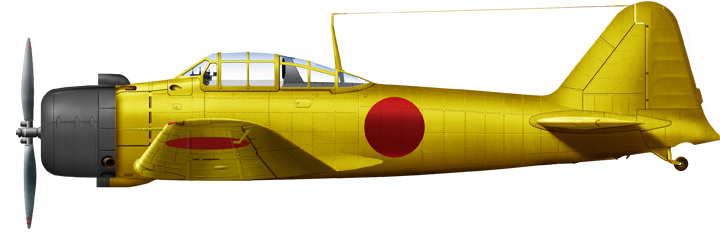
A6M1 prototype, Kagamigahara airfield, April 1939
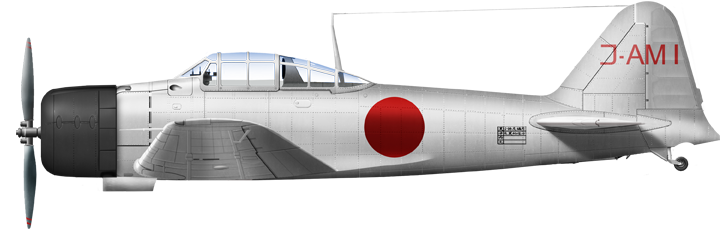
A6M1 Navy 1st prototype, carrier qualifications, late 1939

A6M2 in 1940
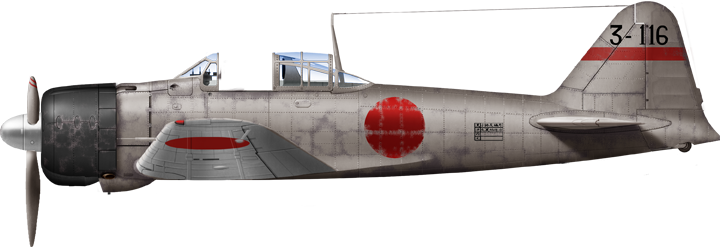
A6M2 in China, 1940
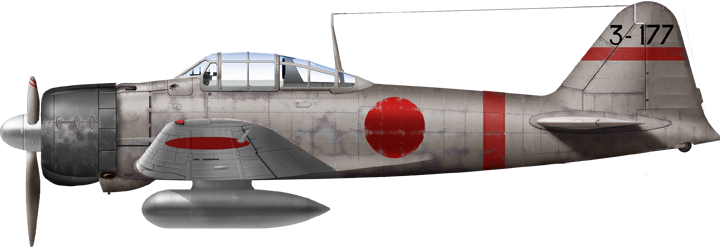
A6M2, 12th Rengo Kokutai, Hankow, China 1940

A6M2 Lt. Minoru Suzuki, 11th Kokutai, Ame Iro, China 1941
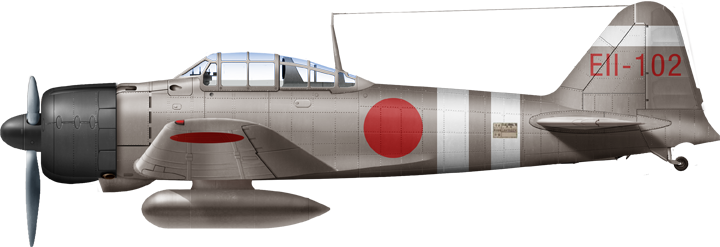
A6M2b, Model 21, IJN Zuikaku, December 1941
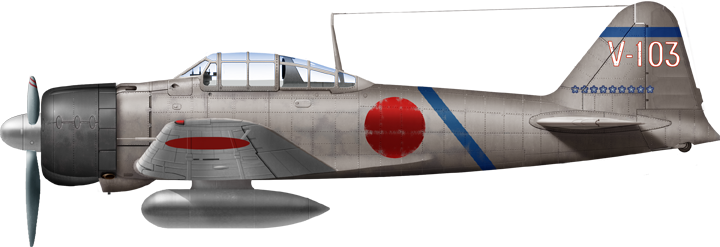
A6M2 IJN Ace Saburo Sakai, Tainian Kokutai, Bali, Early 1942
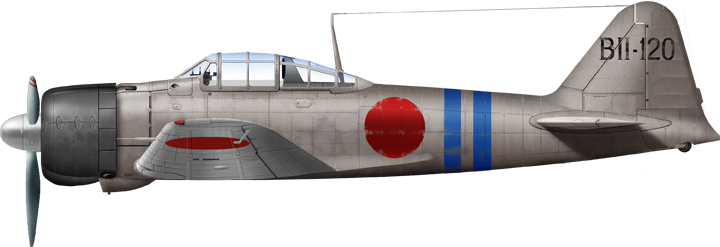
A6M2 IJN Hiryu 1941-42
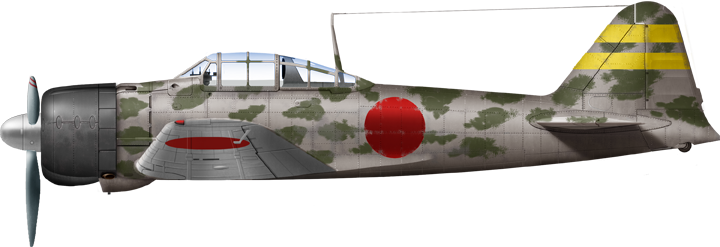
A6M2 Model 21, Rabaul, November 1942
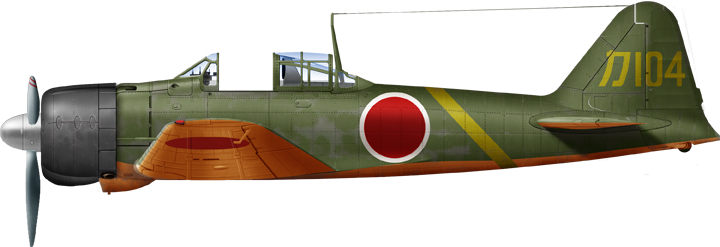
A6M2 Model 21 Kasumigaura Flying Group, Japan, 1943
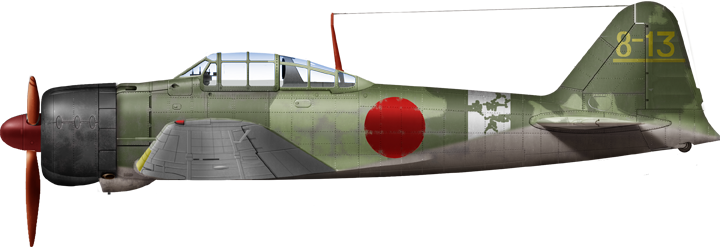
A6M2 captured by the USMC, Saipan, June 1944
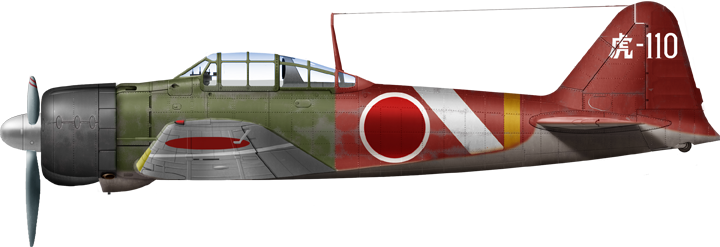
A6M2 M21, 261 Kokutai, 1943/44
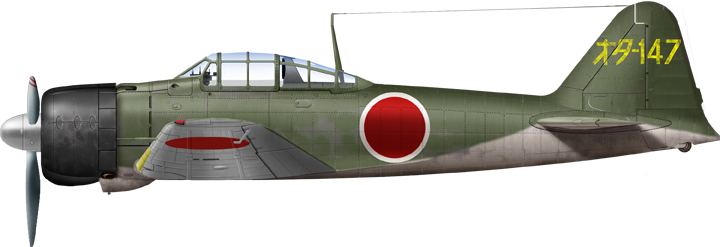
A6M2 Oitu Kokutai, February 1944
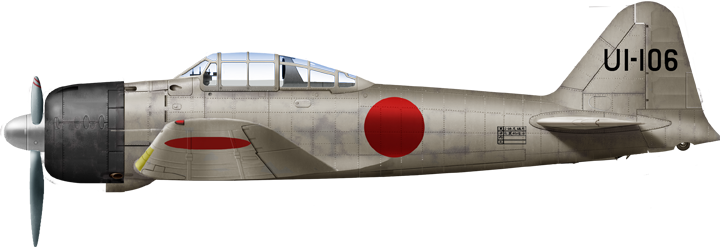
A6M3 m22 of IJN ace Hiroyoshi Nishizawa, Aichi prefecture, Kyushu spring 1943
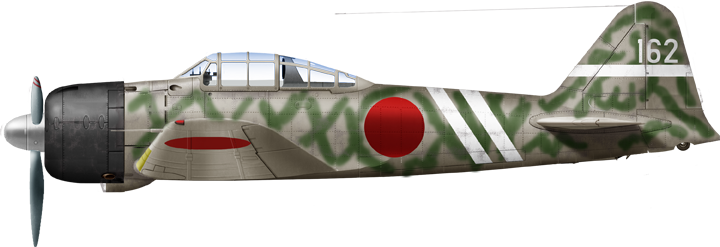
A6M3 m22 of 201 Kokutai, Rabaul, New Britain, May 1943
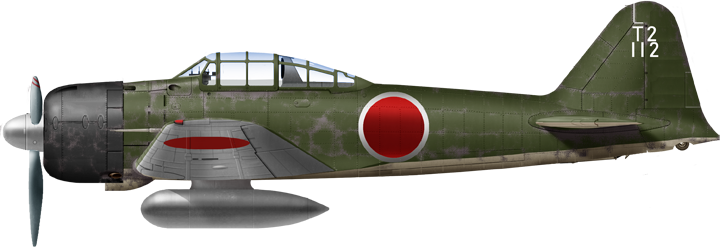
A6M3 m22 of IJN ace Matsuo Hagiri, Buin, Summer 1943
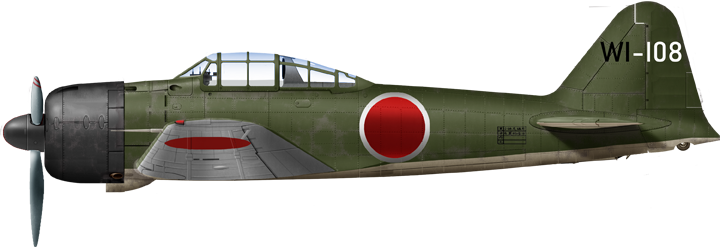
A6M3 Model 22, 201 Kokutai, Ace Takeo Omura, Buin, September 1943
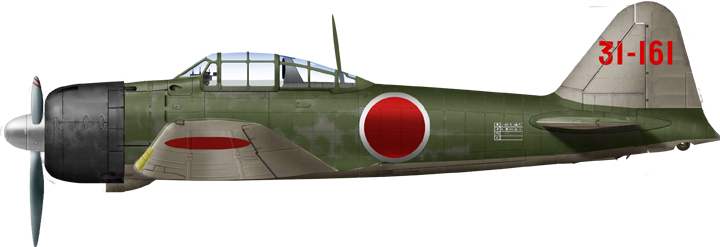
A6M3 m22a at Magwe, Burma, December 1943
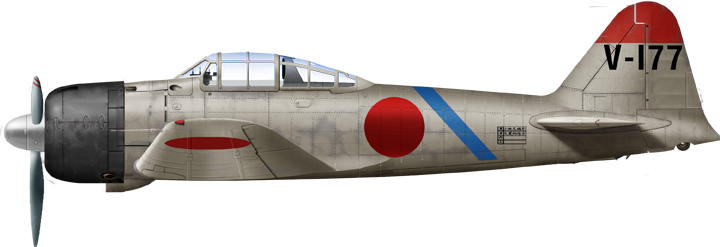
A6M3 model 32 Tainan Kokutai, 2nd Chutai Buna, New Guinea August 1943
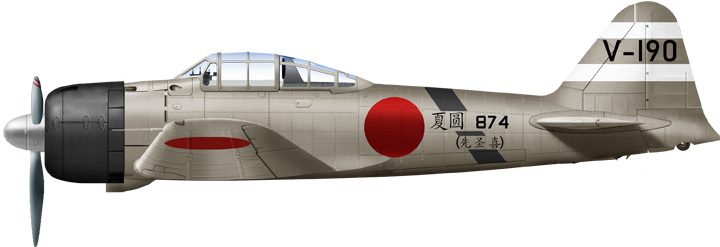
A6M3 m32 of Tainan Kokutai, 4th Chutai, same.
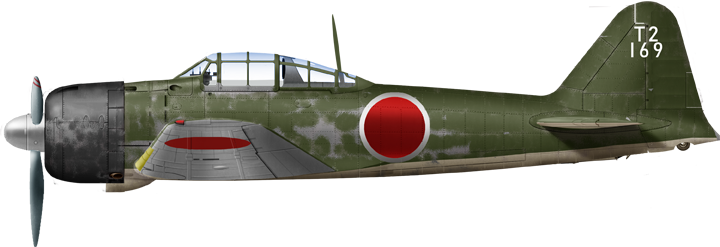
A6M3 m32 of 204 Kokutai, IJN ace Kenji Yanagira, Buin, April 1943
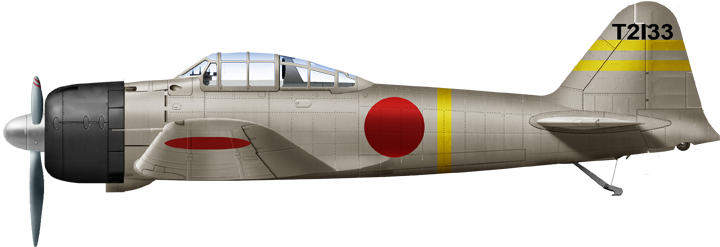
A6M3 m32 of 204 Kokutai, Munda, New Guinea 1943
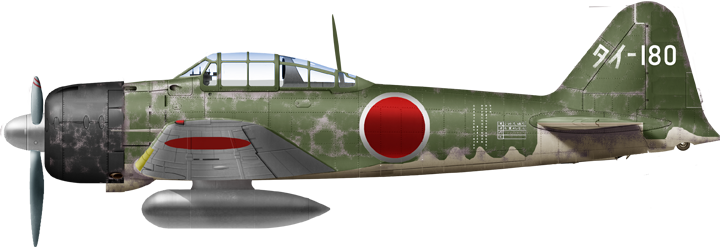
A6M3 m32 of IJN ace Takeo Tanimizu, Tainan Kokutai, Formosa September 1944
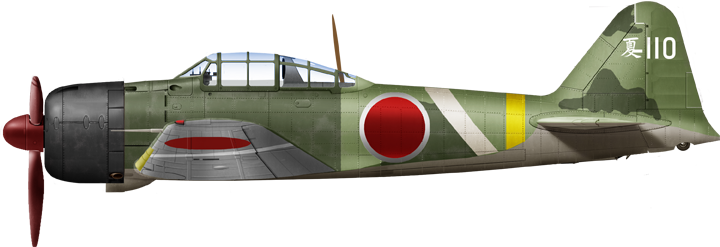
A6M3 m22 in Saipan, June 1944
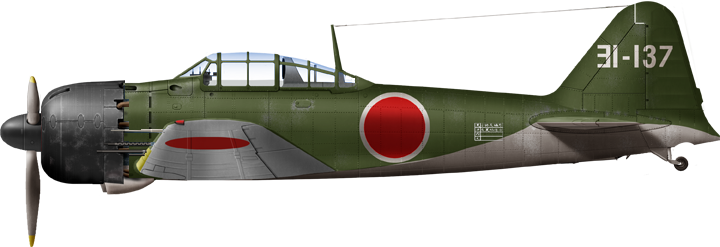
A6M5, Model 55, IJN Taiho, October 1944
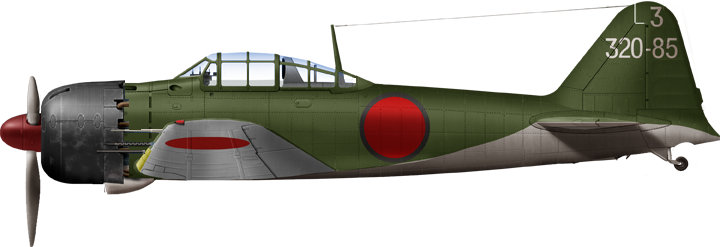
A6M5b, 652 Kokutai, IJN Jun’yo, June 1944
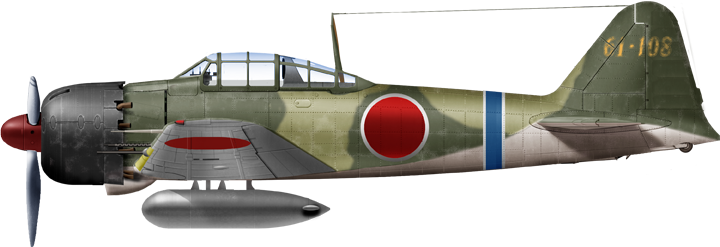
A6M5 model 52, 231 Kokutai, Japan 1944
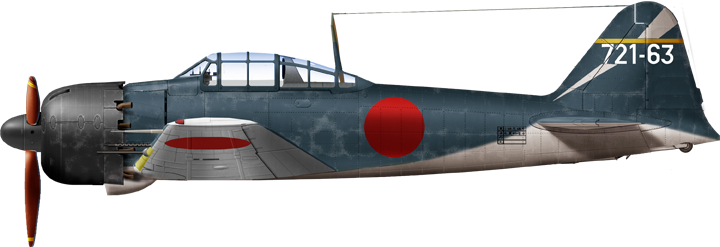
A6M5c (Model 52c), 721 Kokutai Jinrai 406/407 Hikotai at Miyazaki Air Base, Kyushu, 1945
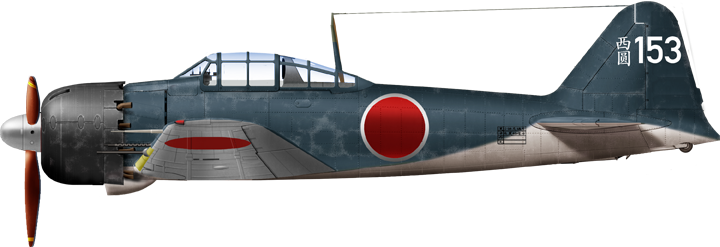
A6M5a Model 52a, 256 Kokutai, Malbalacat Air Base, Philippines October 1944 (Battle of Leyte)
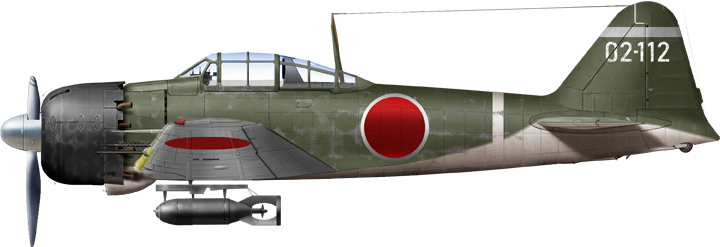
Model 52 modified as a fighter bomber, 301 Hikotai, 201 Kokutai; Early Kamikaze unit, October 944 (Battle of Leyte)
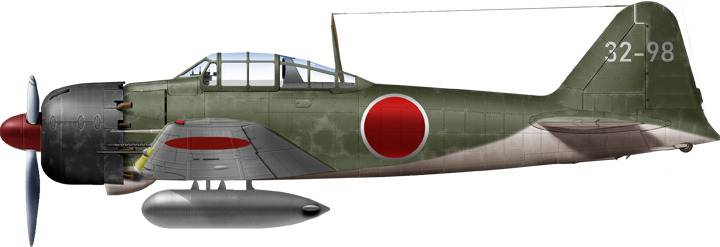
A6M5 model 52c, 332 (Interceptor) Kokutai, Narua Air Base, Japan summer 1945
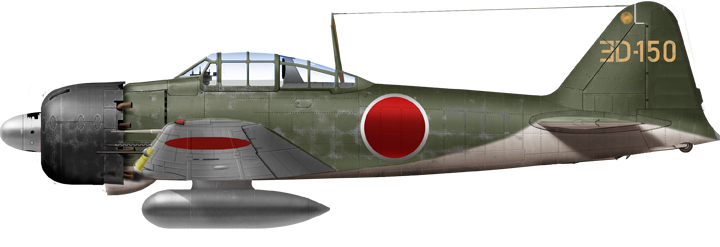
A6M5 of 302 Kokutai, Atsugi Air Base, Japan, 1945
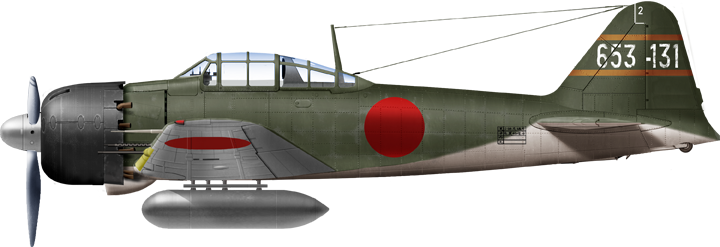
A6M5b of an unknown unit
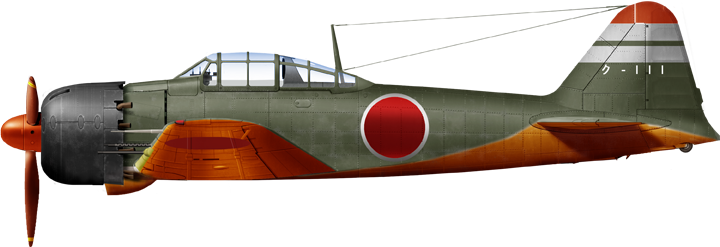
A6L5 m52 Kokutai Genzan, Wonsan, Korea 1944
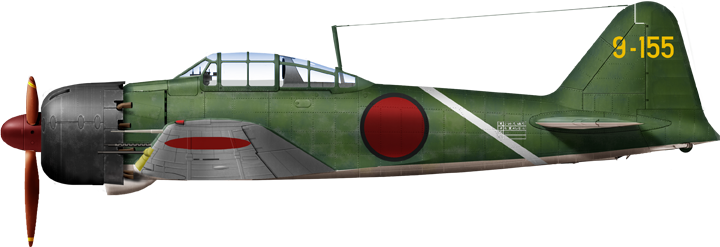
A6M5 m52 at Rabaul, 1944
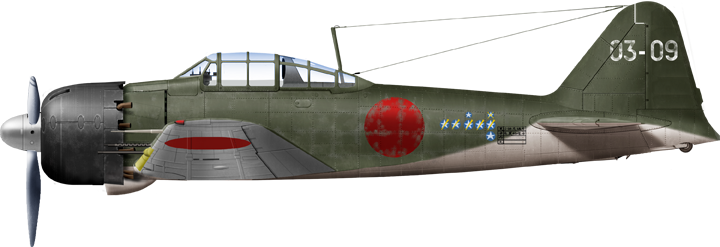
A6M5c, 303 Sentai, 203 KoKutai, IJN ace Takeo Taminizu, 1944
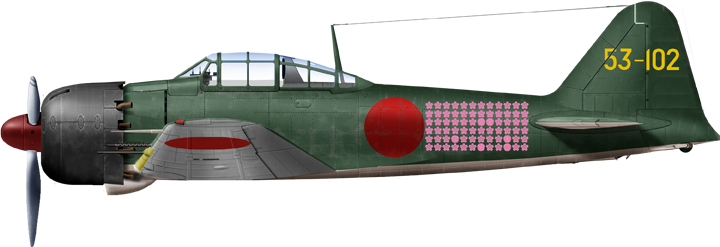
A6M5c of IJN ace Tetsuzo Iwamoto 1944
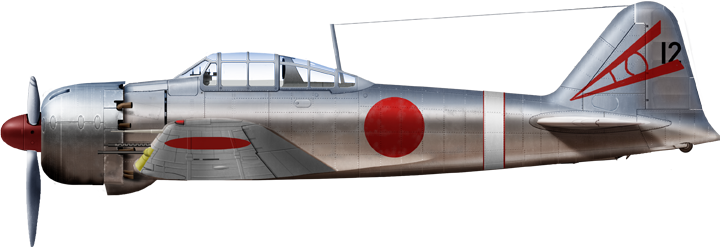
A6M5 captured in Saipan with a factory unpainted livery.
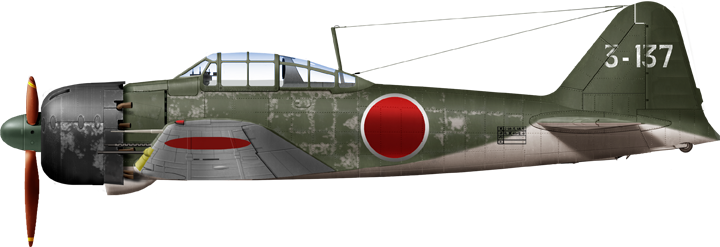
A6M5b of an unknown Kokutai, note the paint fatigue
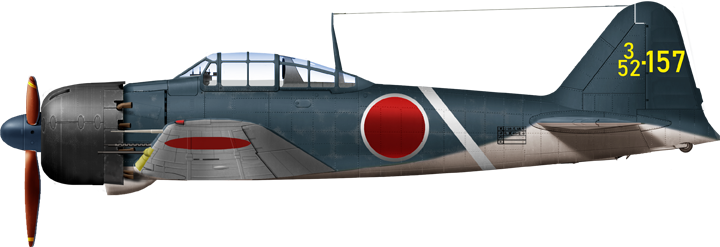
A6M5c from 352 Kokutai, Kasanohara Air Base, Kagoshima, Kyushu, March 1945
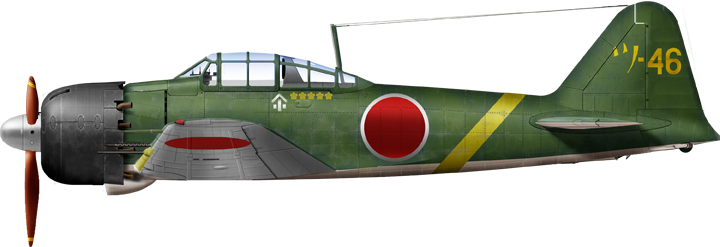
A6M5c of Tsukuba Naval Air Corp, Oita Air Base, Japan, July 1945
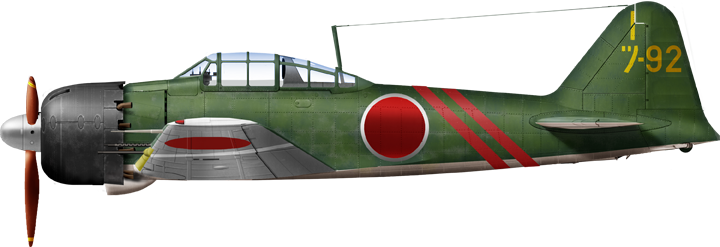
A6M5c of Tsukuba Flying group, early 1945
To come (if references are available): A6M4, A6M6, A6M7 and A6M8.
Gallery

A6M Zero Chino California
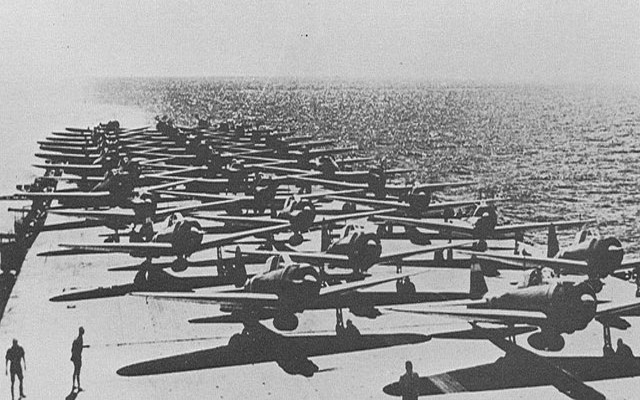
Zero on Zuikaku, Indian Ocean raid, April 1942
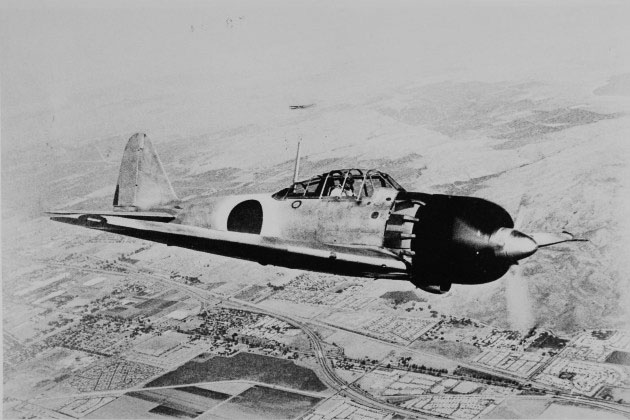
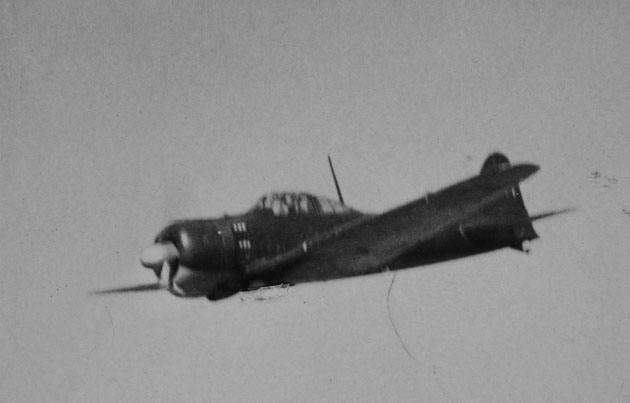
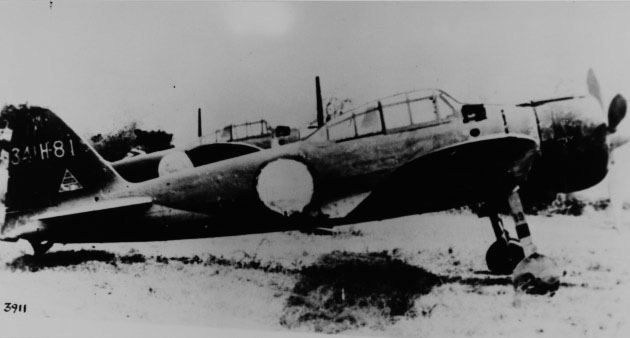
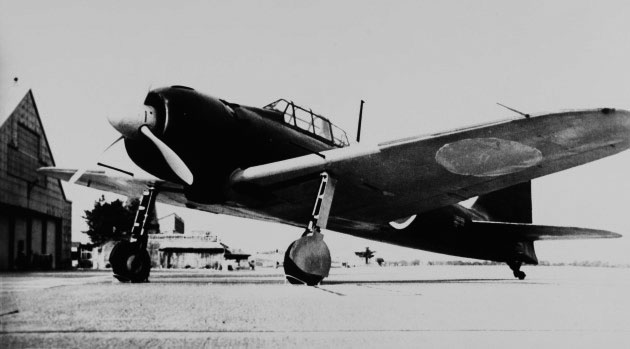
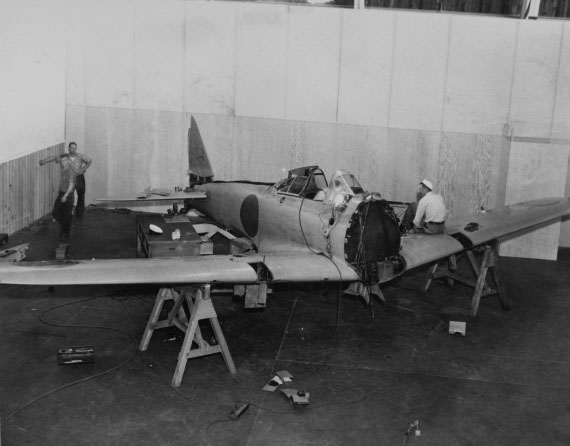
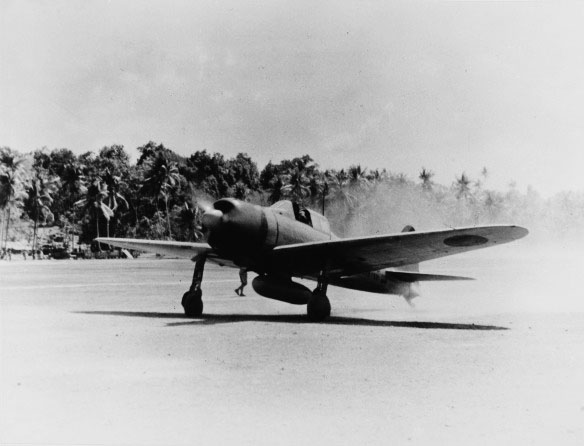
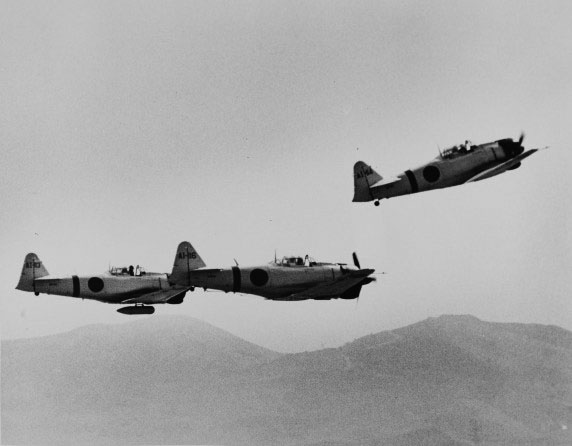
Zero photo References on Wagner coll.
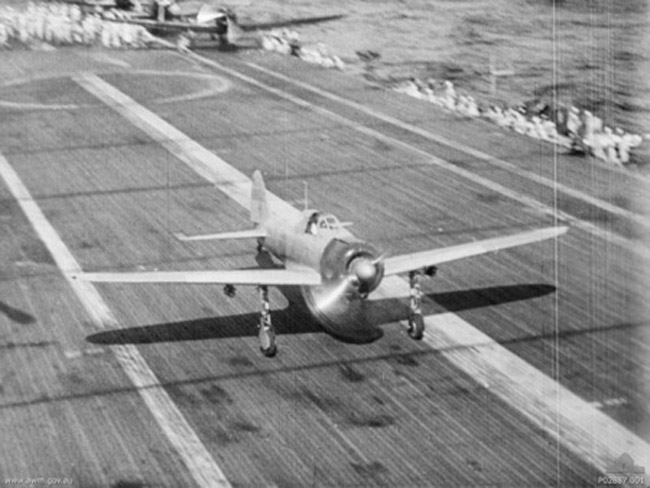
A6M_taking_off_during_Battle_of_Santa_Cruz_Islands_1942
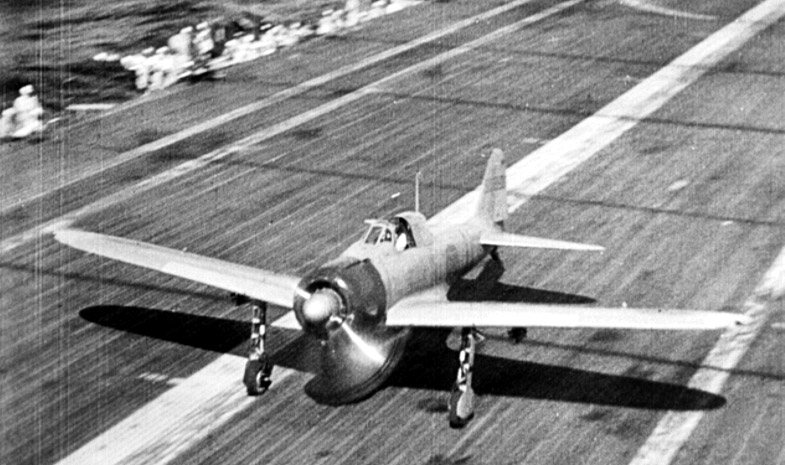
Mitsubishi_A6M2_taking_off_during_Battle_of_Santa_Cruz_Islands_26_October_1942
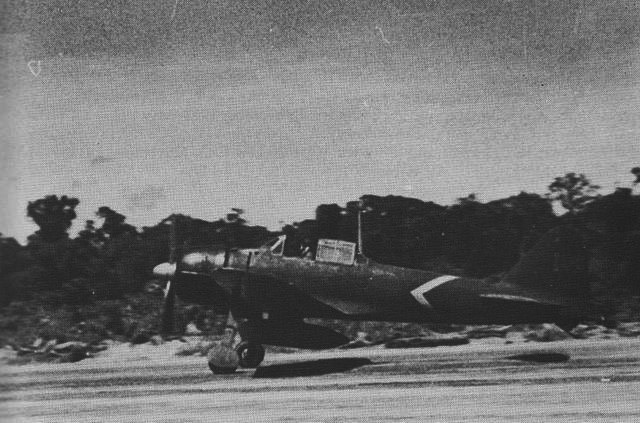
Zuikaku_Zero_at_Buin_1943
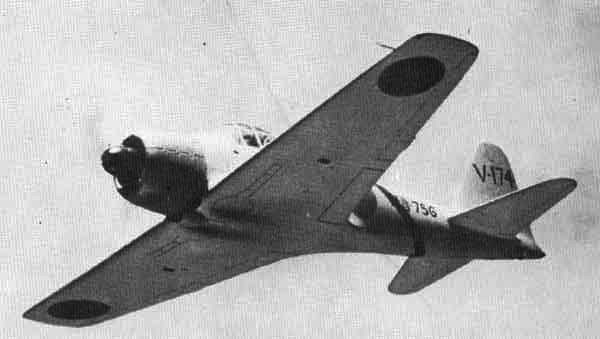
A6M3_Type32_Tainan_Kokutai_V174
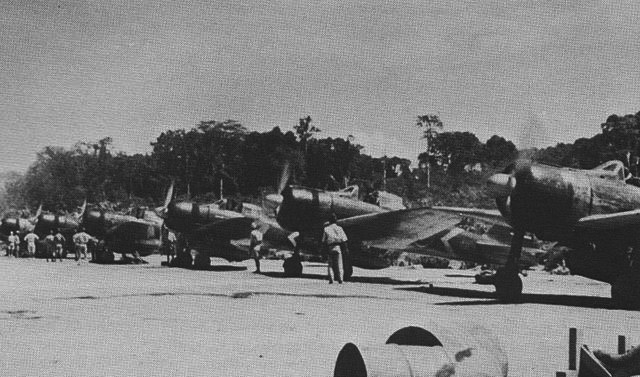
Zuikaku_Zeros_at_Buin_1943
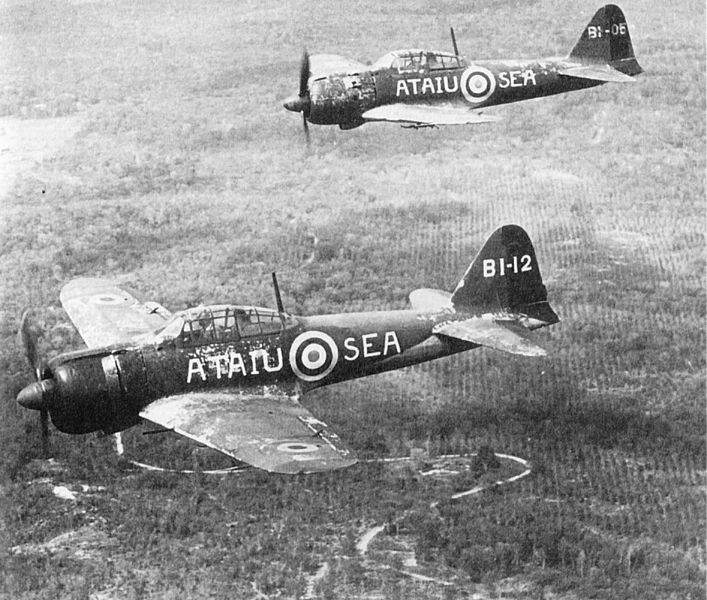
capt-A6M_Zeros_over_Malaya
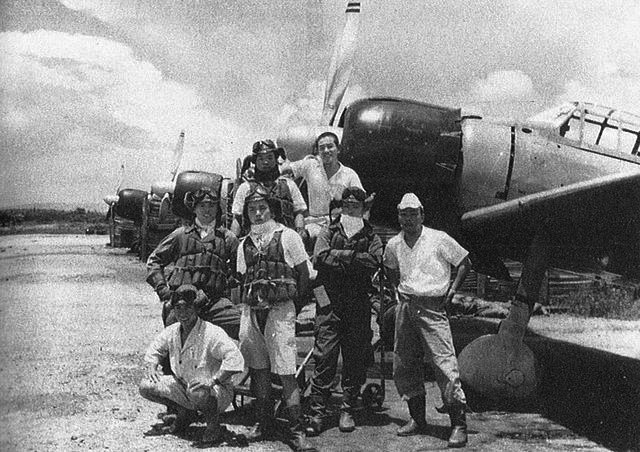
202_air_group_pilots_at_Kupang
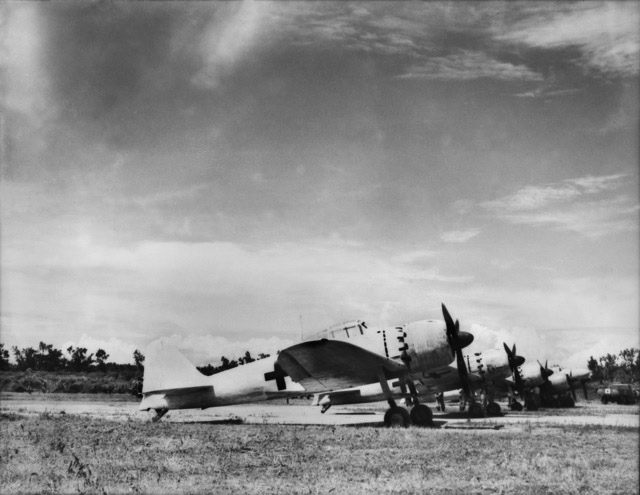
Surrendered_A6M5s_at_Jacquinot_Bay_1945
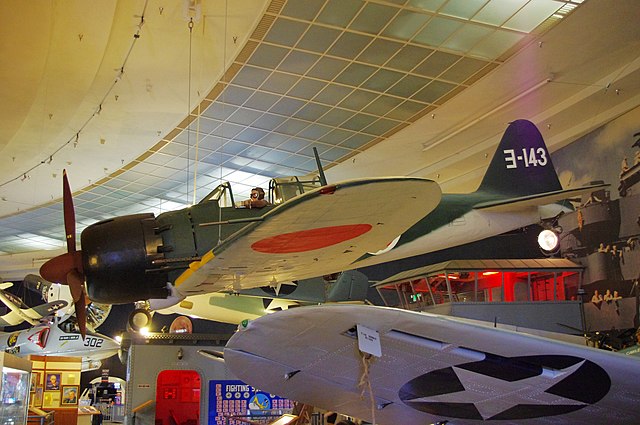
Zero_Fighter_Model_63_museum
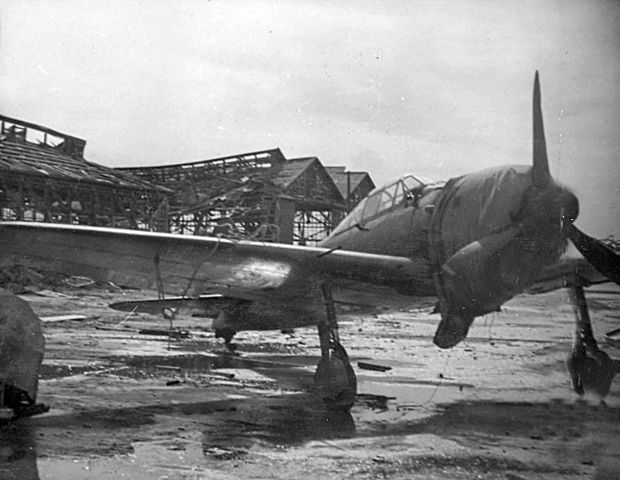
Captured_A6M5_on_Saipan_1944
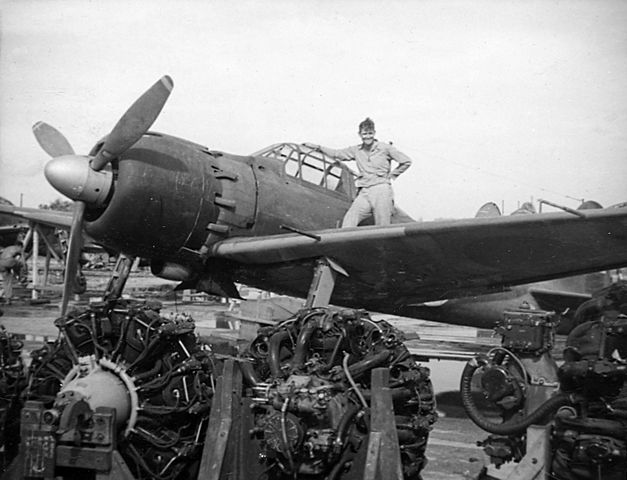
Captured_A6M5_with_engines_on_Saipan_1944
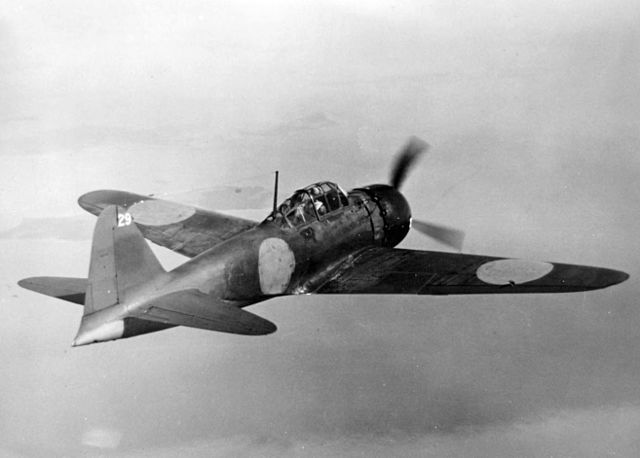
Captured_A6M5_in_flight_1944
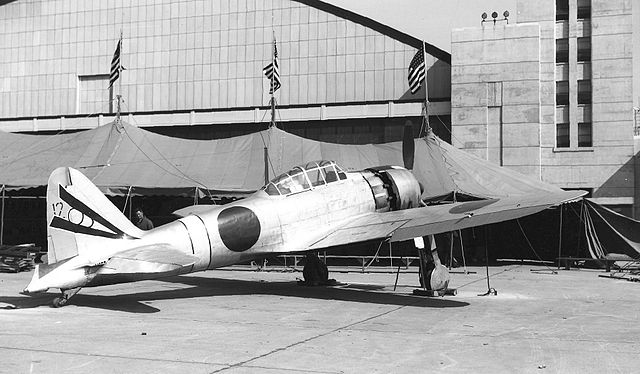
Mitsubishi_52_Zero_US

Captured_Mitsubishi_A6M5_in_flight_1944
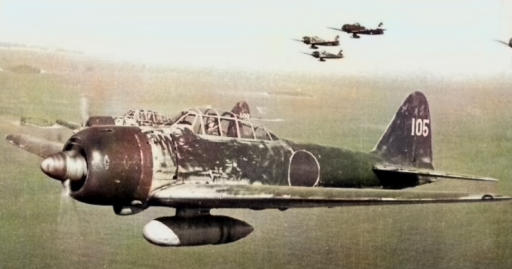
Zero62

Mitsubishi_Zero-sen_engine
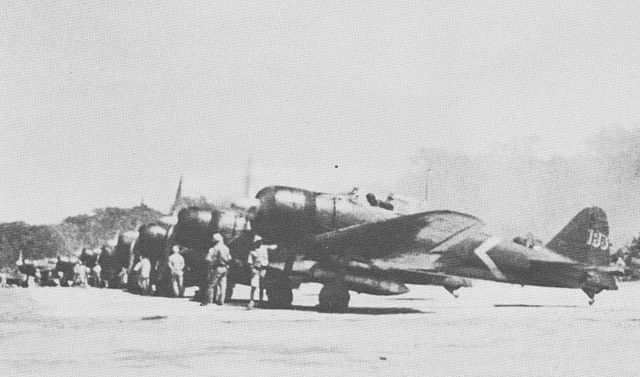
Zuikaku_Zeros_at_Buin_1943
Reconstructed-Mitsubishi_A6M_Zero_X-133_tail
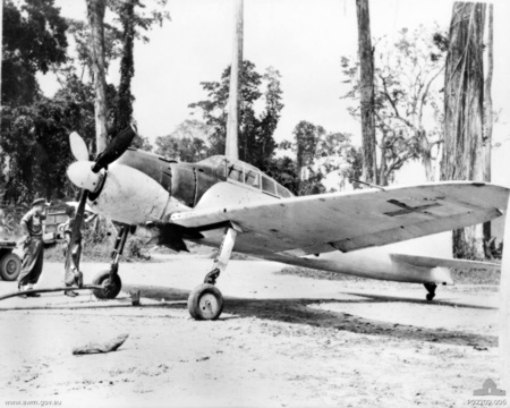
A6M3_captured_at_Bougainville_1945
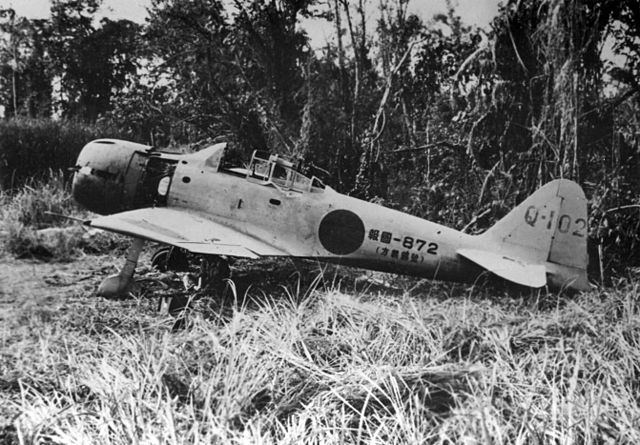
Abandoned_Mitsubishi_A6M3_fighter
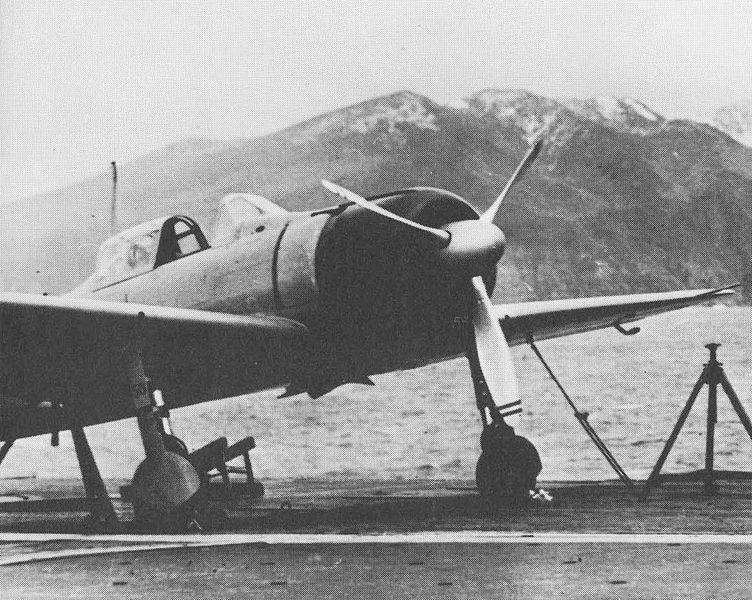
Akagi_Zero_Hitokappu
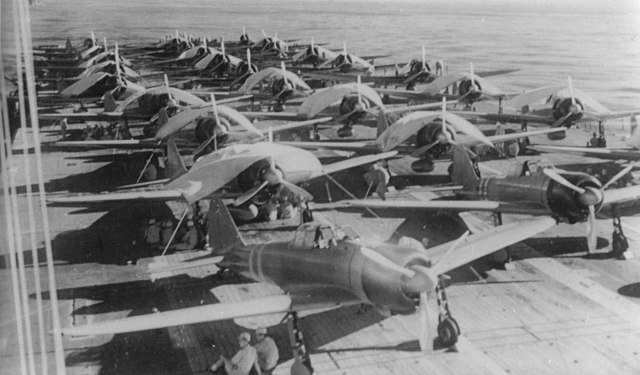
A6M2-Zuikaku_air_raid
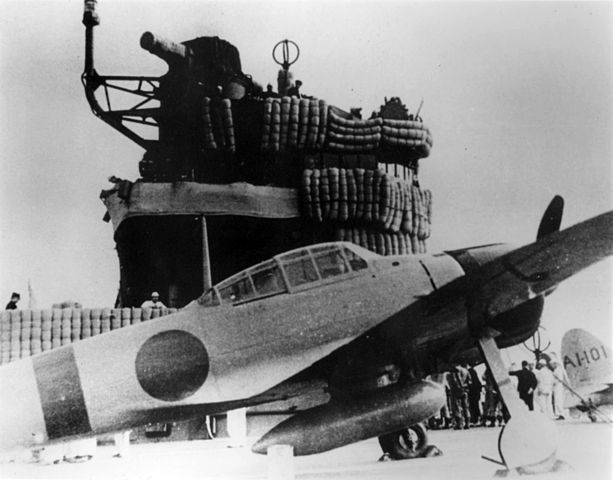
A6M2_on_carrier_Akagi_1941
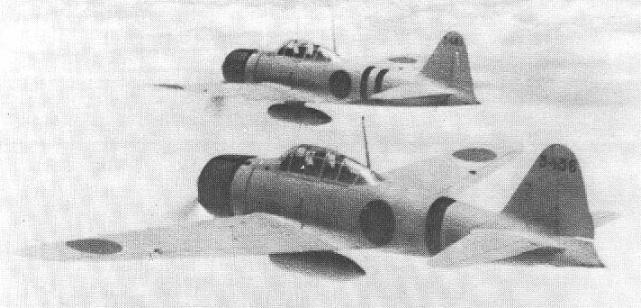
A6M2Zeros
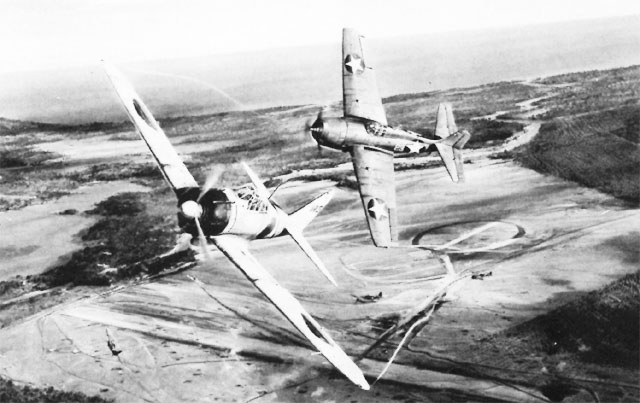
Henderson-Marine-Wildcat-Watercolor
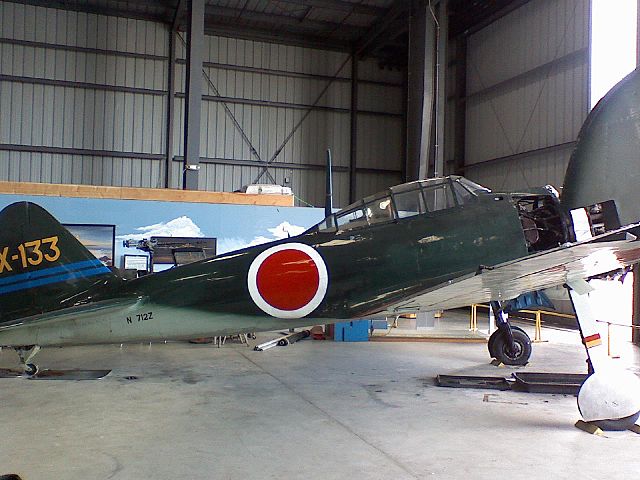
Mitsubishi_A6M6C_Zero_2
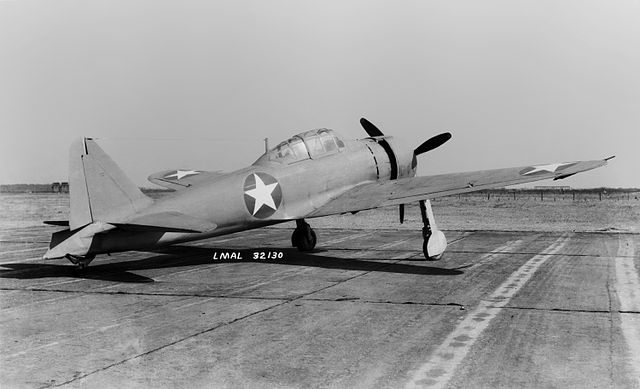
Mitsubishi_A6M2_NASA_GPN-2000
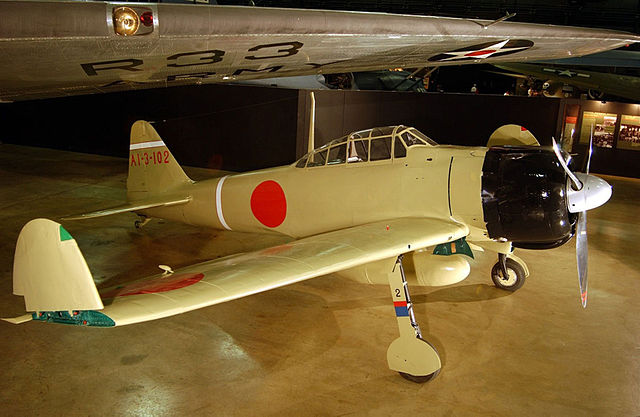
Mitsubishi_A62M_Zero_USAF
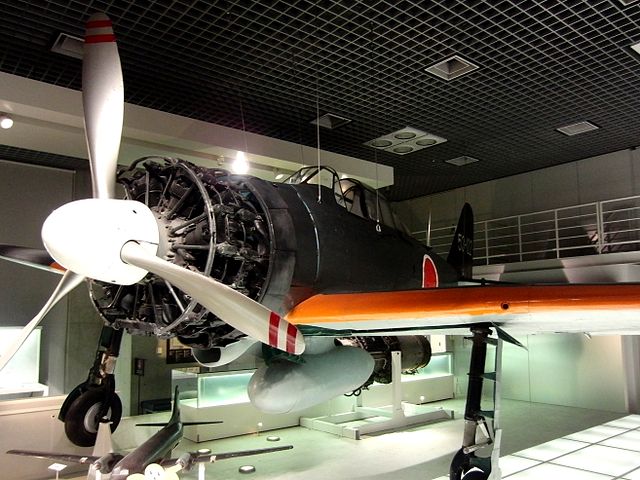
Zero_Fighter_Plane_Model_21
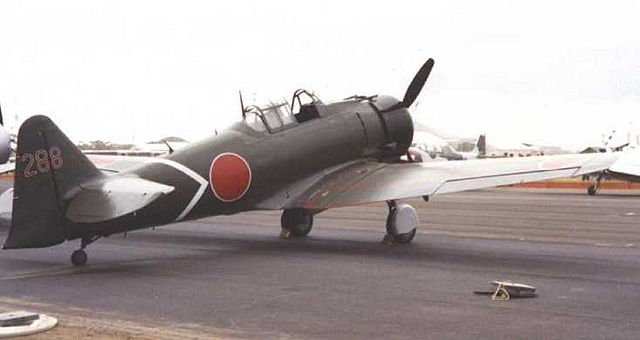
Mitsubishi-zero-replica-l
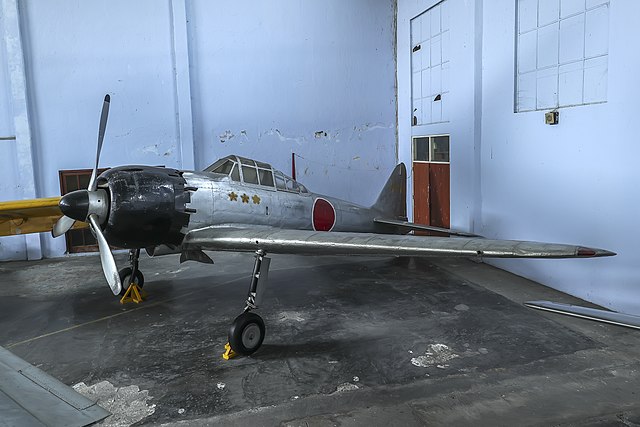
Mitsubishi-A6-M5-Zero-Zen
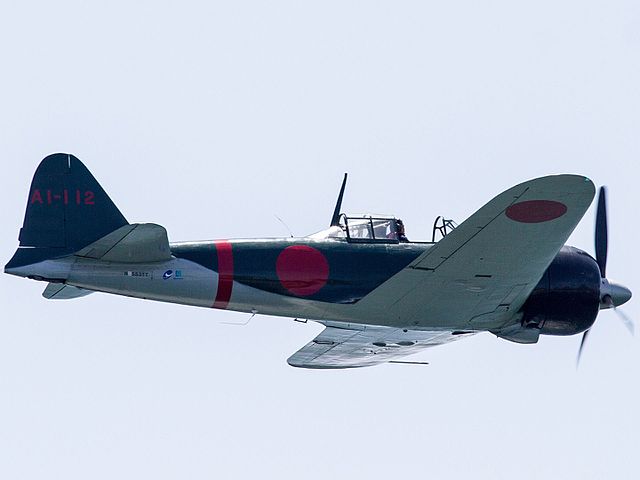
2017-RedBull-Air-Race-Chiba-Mitsubishi-A6M-Zero
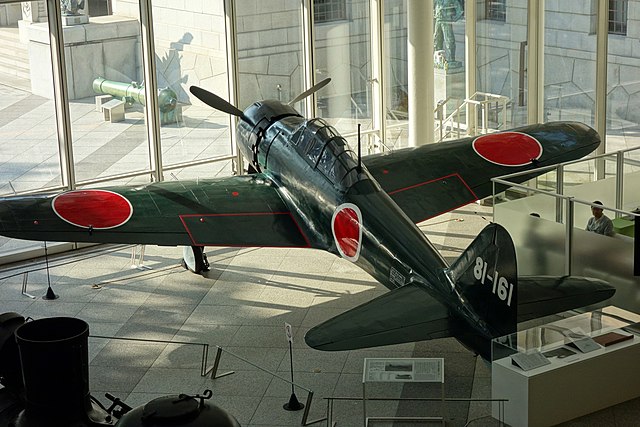
Mitsubishi-A6M-Zero-Yushukan-2016-Luka-Peternel
MitsuZero_AirandSpace
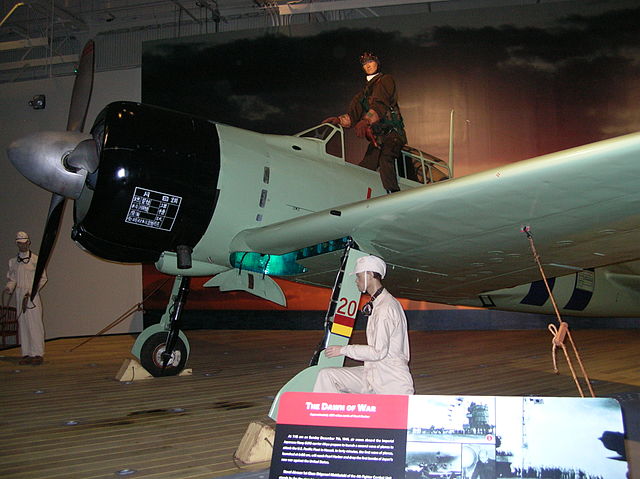
Mitsubishi_A6M2_Type_0_Model_21
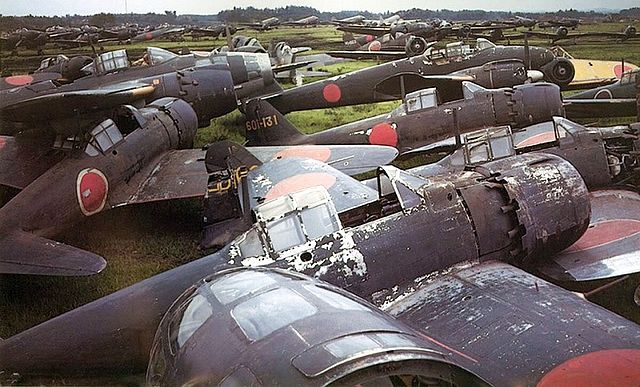
A6M5_scrapped
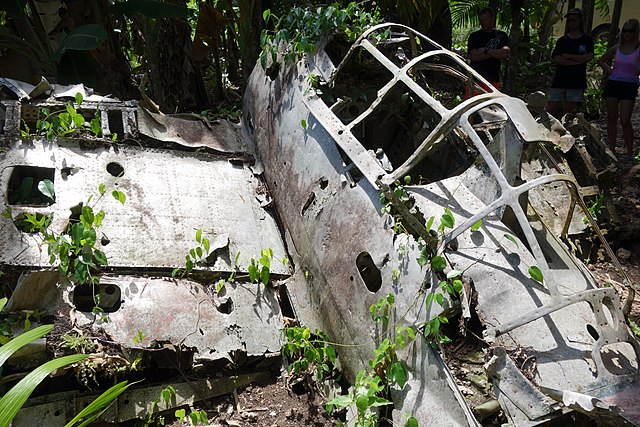
Mitsubishi-A6M-Zero-Peleliu-2016-Luka-Peternel
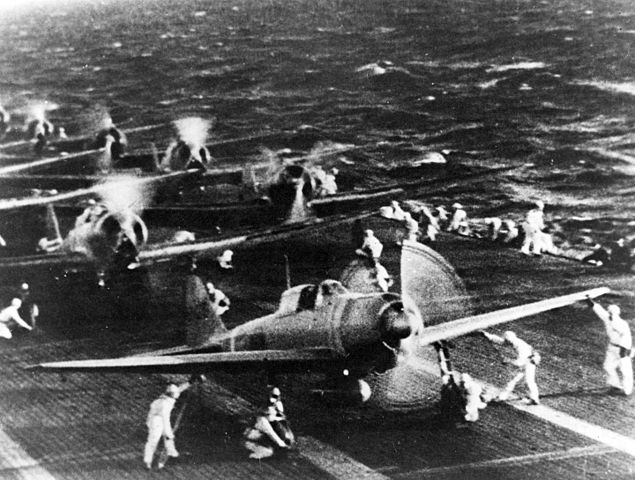
Carrier_shokaku
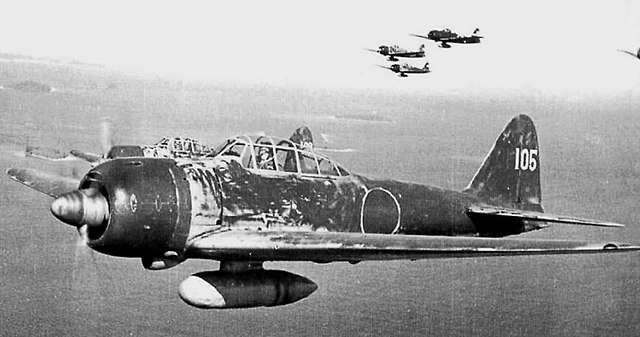
A6M3_Model22_UI105_Nishizawa
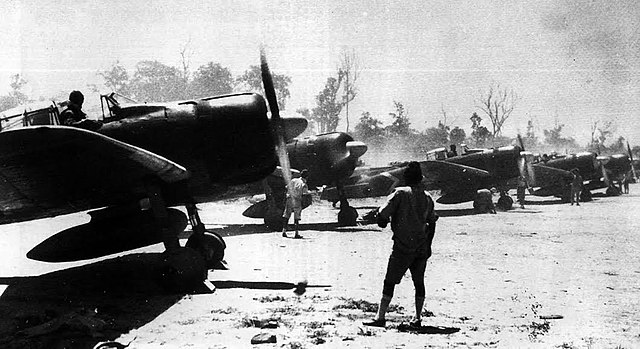
A6M2_Zuikaku_Rabaul
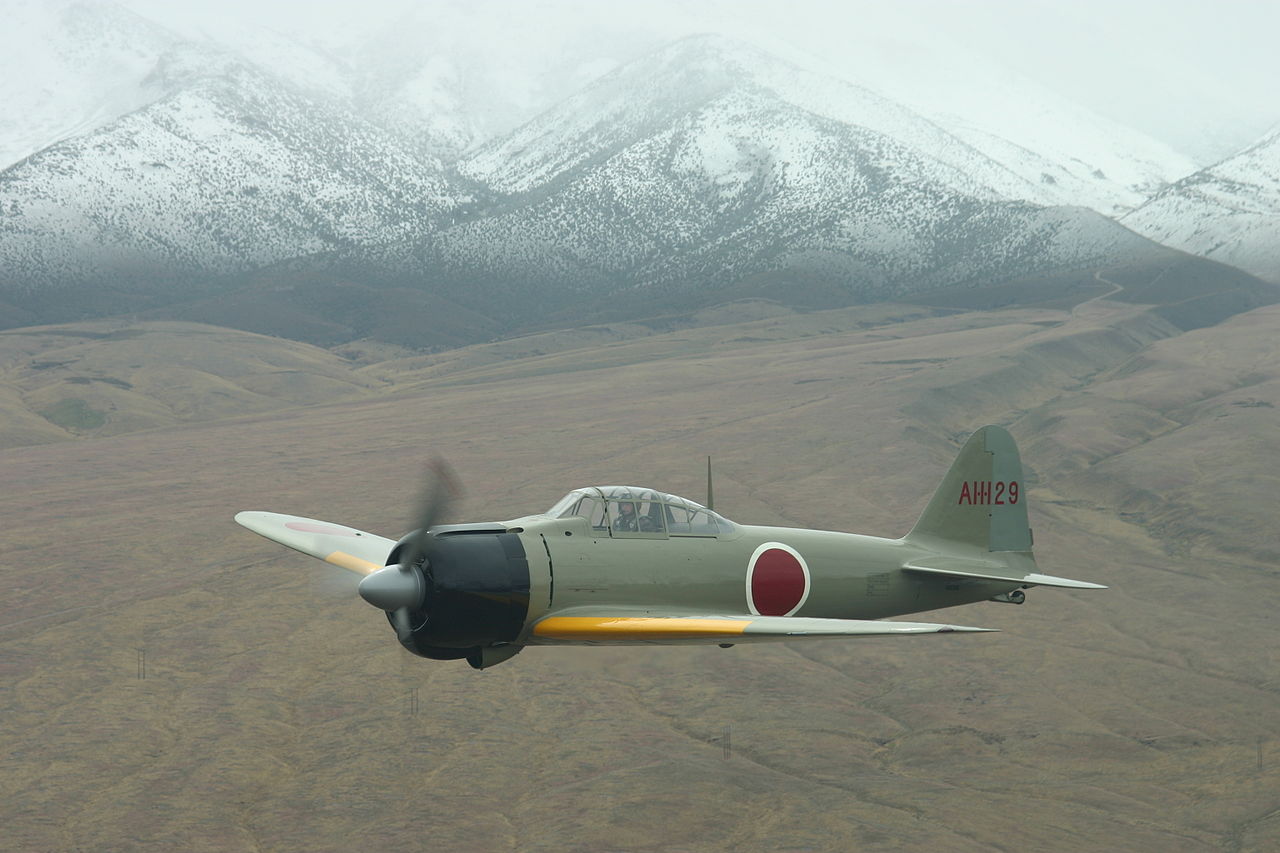
Japanese_Zero-preserved
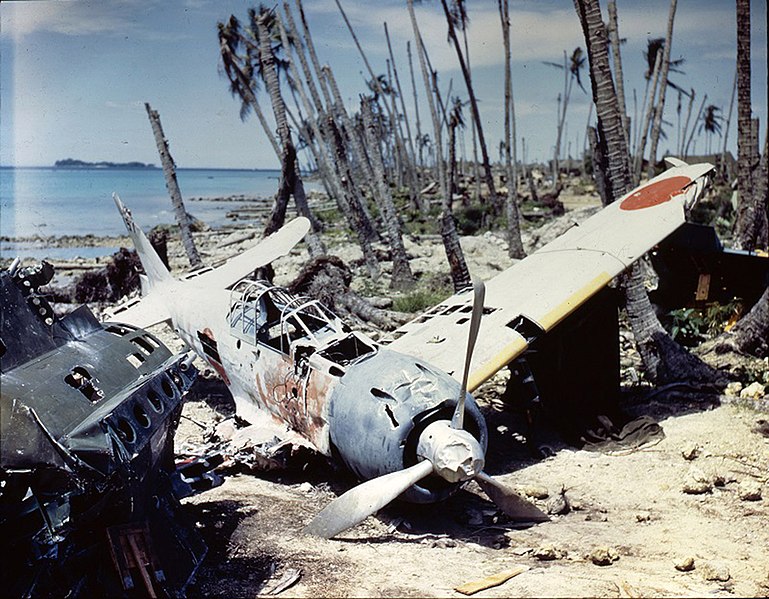
crashed-A6M3_Munda_1943
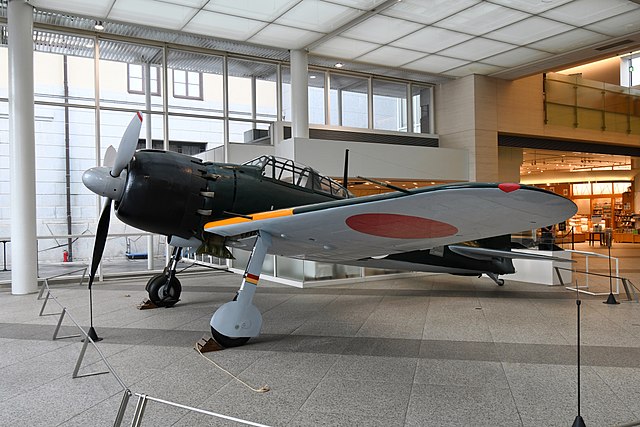
Mitsubishi_A6M5_in_Yushukan
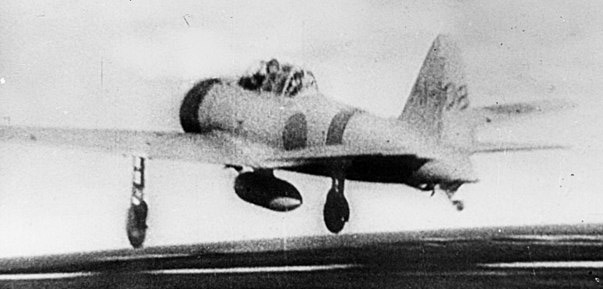
Zero_Akagi_Dec1941
Zero_11_on_China
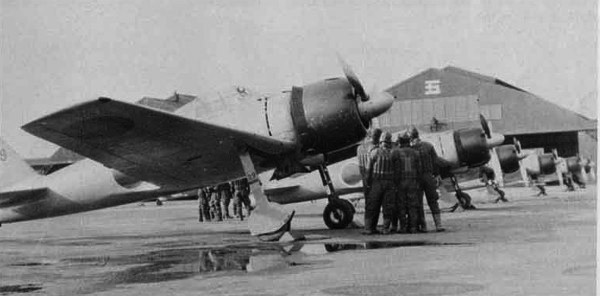
A6M3_Model32-common
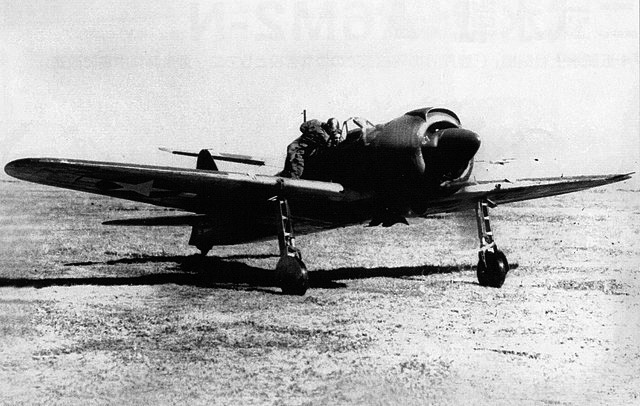
A6M8_Type_64_usmarkings-tests


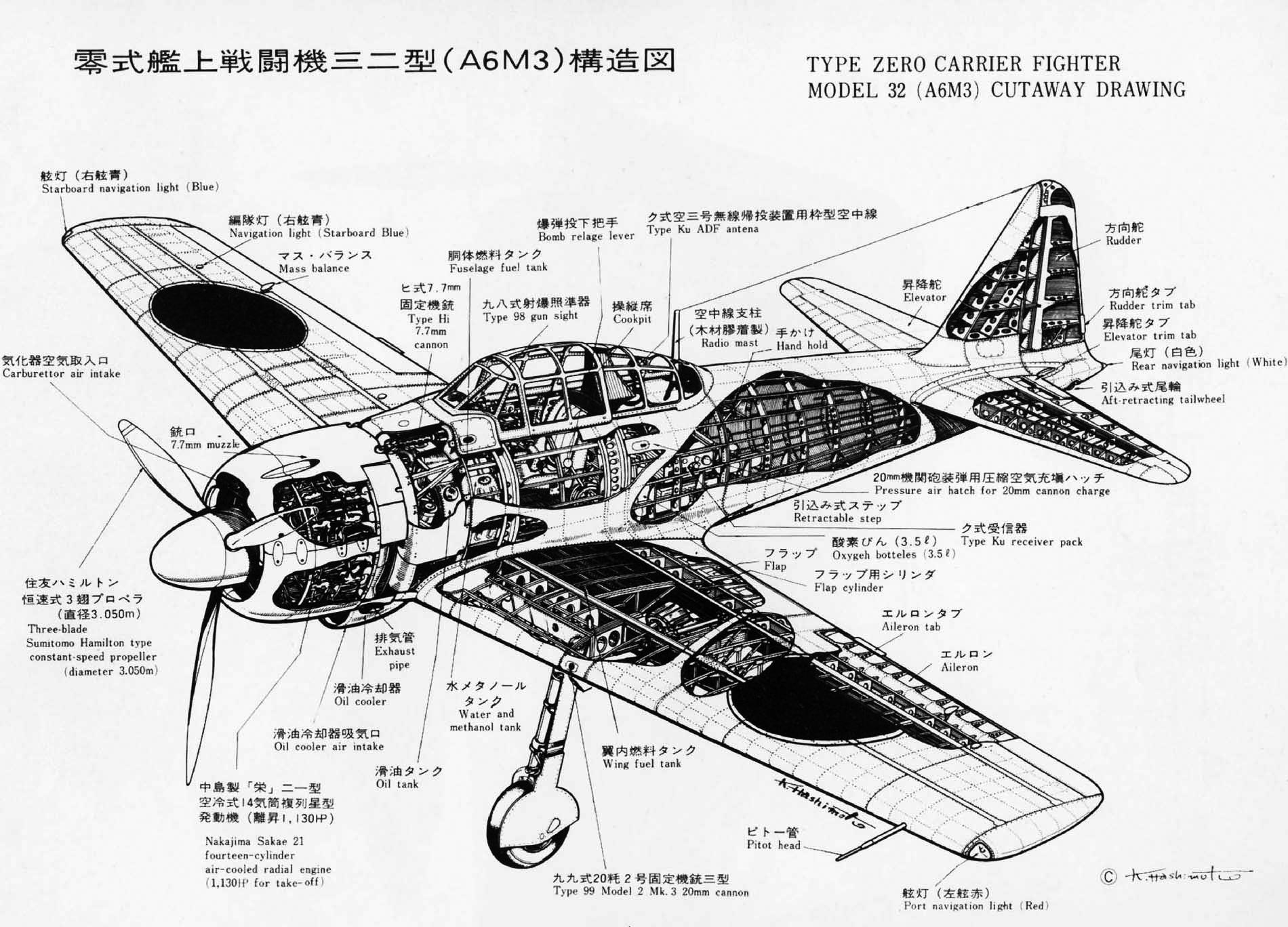
 Latest Facebook Entry -
Latest Facebook Entry -  X(Tweeter) Naval Encyclopedia's deck archive
X(Tweeter) Naval Encyclopedia's deck archive Instagram (@navalencyc)
Instagram (@navalencyc)





 French Navy
French Navy Royal Navy
Royal Navy Russian Navy
Russian Navy Armada Espanola
Armada Espanola Austrian Navy
Austrian Navy K.u.K. Kriegsmarine
K.u.K. Kriegsmarine Dansk Marine
Dansk Marine Nautiko Hellenon
Nautiko Hellenon Koninklije Marine 1870
Koninklije Marine 1870 Marinha do Brasil
Marinha do Brasil Osmanlı Donanması
Osmanlı Donanması Marina Do Peru
Marina Do Peru Marinha do Portugal
Marinha do Portugal Regia Marina 1870
Regia Marina 1870 Nihhon Kaigun 1870
Nihhon Kaigun 1870 Preußische Marine 1870
Preußische Marine 1870 Russkiy Flot 1870
Russkiy Flot 1870 Svenska marinen
Svenska marinen Søværnet
Søværnet Union Navy
Union Navy Confederate Navy
Confederate Navy Armada de Argentina
Armada de Argentina Imperial Chinese Navy
Imperial Chinese Navy Marinha do Portugal
Marinha do Portugal Mexico
Mexico Kaiserliche Marine
Kaiserliche Marine 1898 US Navy
1898 US Navy Sovietskiy Flot
Sovietskiy Flot Royal Canadian Navy
Royal Canadian Navy Royal Australian Navy
Royal Australian Navy RNZN Fleet
RNZN Fleet Chinese Navy 1937
Chinese Navy 1937 Kriegsmarine
Kriegsmarine Chilean Navy
Chilean Navy Danish Navy
Danish Navy Finnish Navy
Finnish Navy Hellenic Navy
Hellenic Navy Polish Navy
Polish Navy Romanian Navy
Romanian Navy Turkish Navy
Turkish Navy Royal Yugoslav Navy
Royal Yugoslav Navy Royal Thai Navy
Royal Thai Navy Minor Navies
Minor Navies Albania
Albania Austria
Austria Belgium
Belgium Columbia
Columbia Costa Rica
Costa Rica Cuba
Cuba Czechoslovakia
Czechoslovakia Dominican Republic
Dominican Republic Haiti
Haiti Hungary
Hungary Honduras
Honduras Estonia
Estonia Iceland
Iceland Eire
Eire Equador
Equador Iran
Iran Iraq
Iraq Latvia
Latvia Liberia
Liberia Lithuania
Lithuania Mandchukuo
Mandchukuo Morocco
Morocco Nicaragua
Nicaragua Persia
Persia San Salvador
San Salvador Sarawak
Sarawak Uruguay
Uruguay Venezuela
Venezuela Zanzibar
Zanzibar Warsaw Pact Navies
Warsaw Pact Navies Bulgaria
Bulgaria Hungary
Hungary

 Bundesmarine
Bundesmarine Dutch Navy
Dutch Navy Hellenic Navy
Hellenic Navy Marina Militare
Marina Militare Yugoslav Navy
Yugoslav Navy Chinese Navy
Chinese Navy Indian Navy
Indian Navy Indonesian Navy
Indonesian Navy JMSDF
JMSDF North Korean Navy
North Korean Navy Pakistani Navy
Pakistani Navy Philippines Navy
Philippines Navy ROKN
ROKN Rep. of Singapore Navy
Rep. of Singapore Navy Taiwanese Navy
Taiwanese Navy IDF Navy
IDF Navy Saudi Navy
Saudi Navy Royal New Zealand Navy
Royal New Zealand Navy Egyptian Navy
Egyptian Navy South African Navy
South African Navy






























 Ukrainian Navy
Ukrainian Navy dbodesign
dbodesign
Great stuff on the Zero did not There was so many models and up greads as the War went on .
Welle at list its goude enof four google